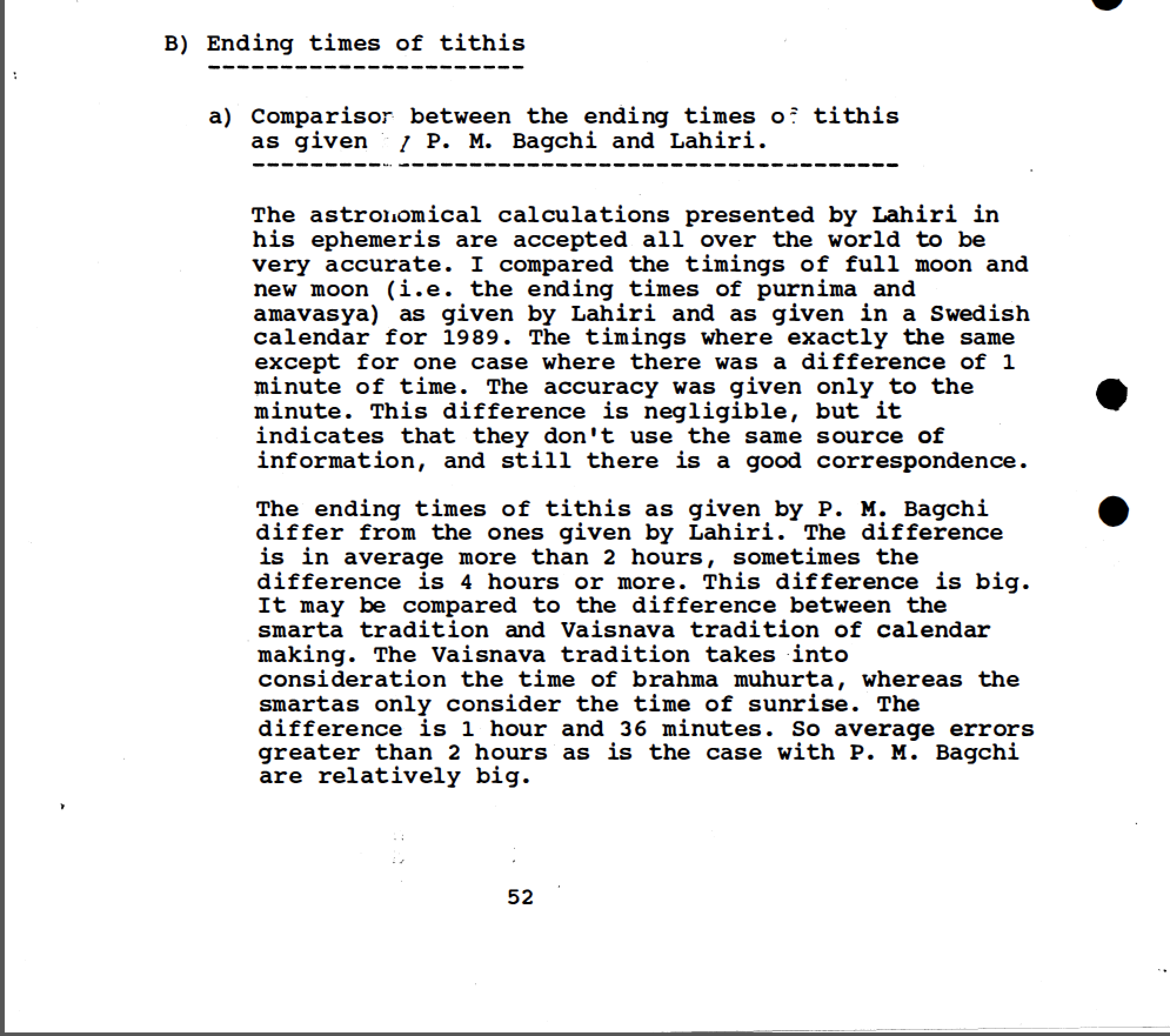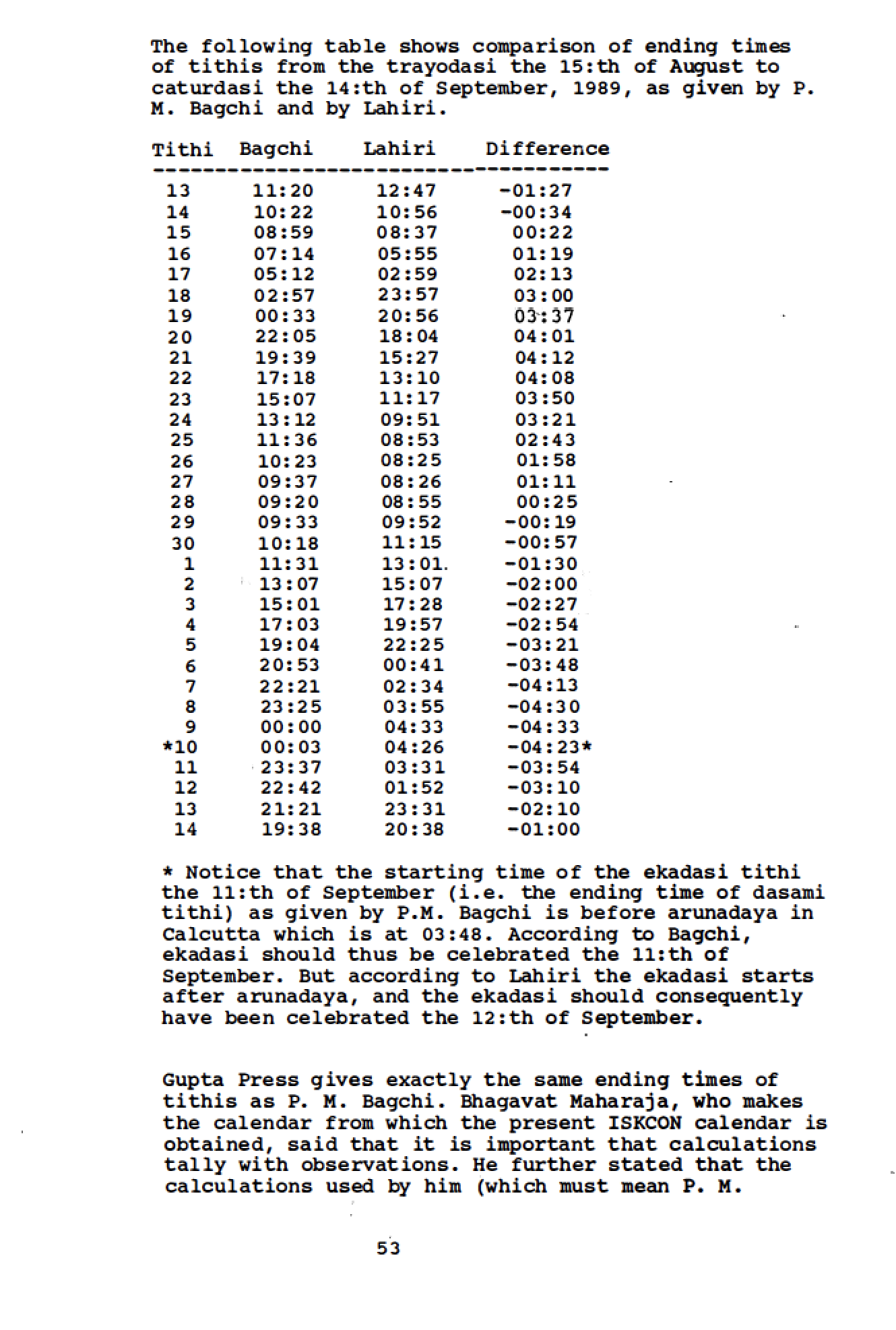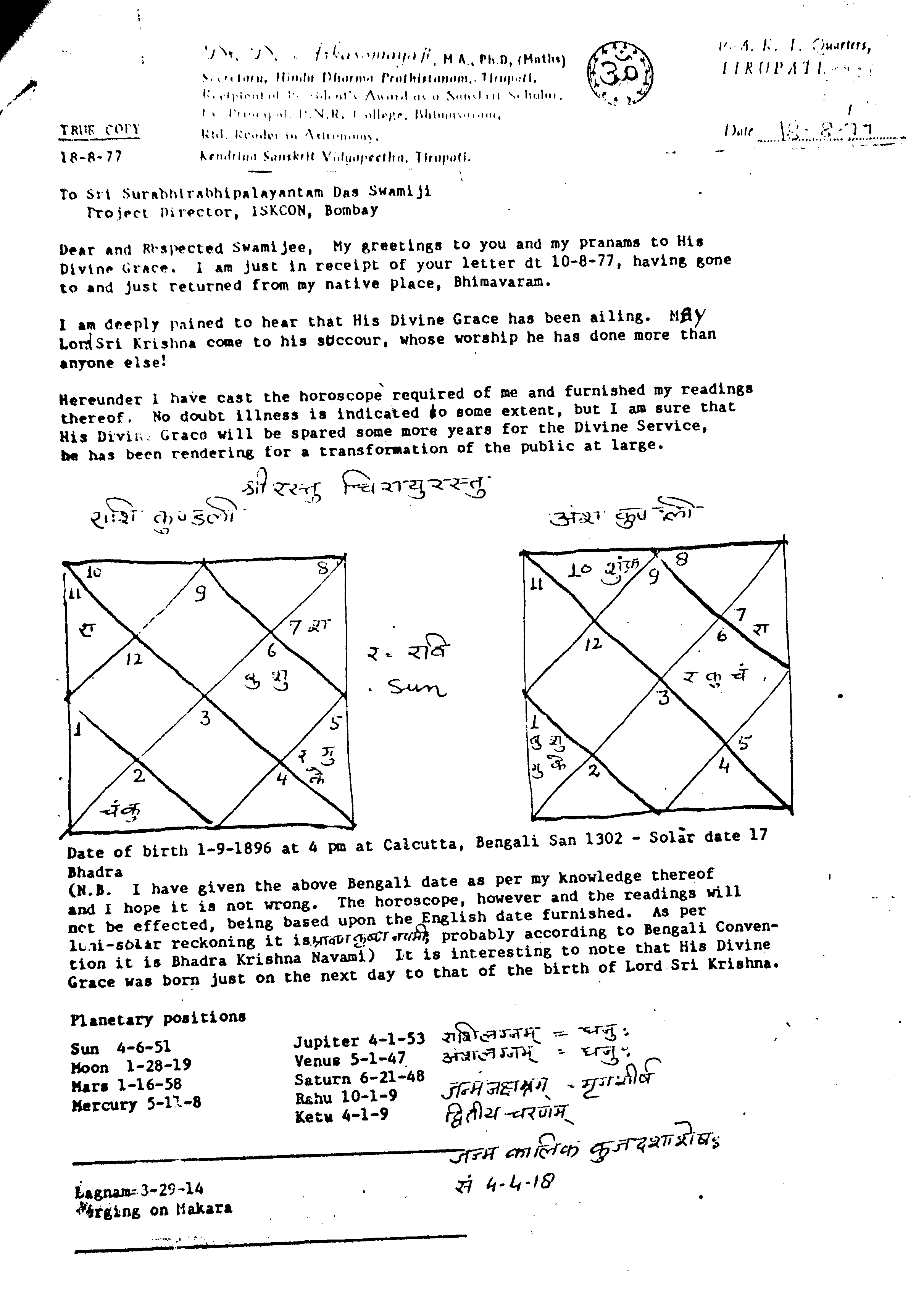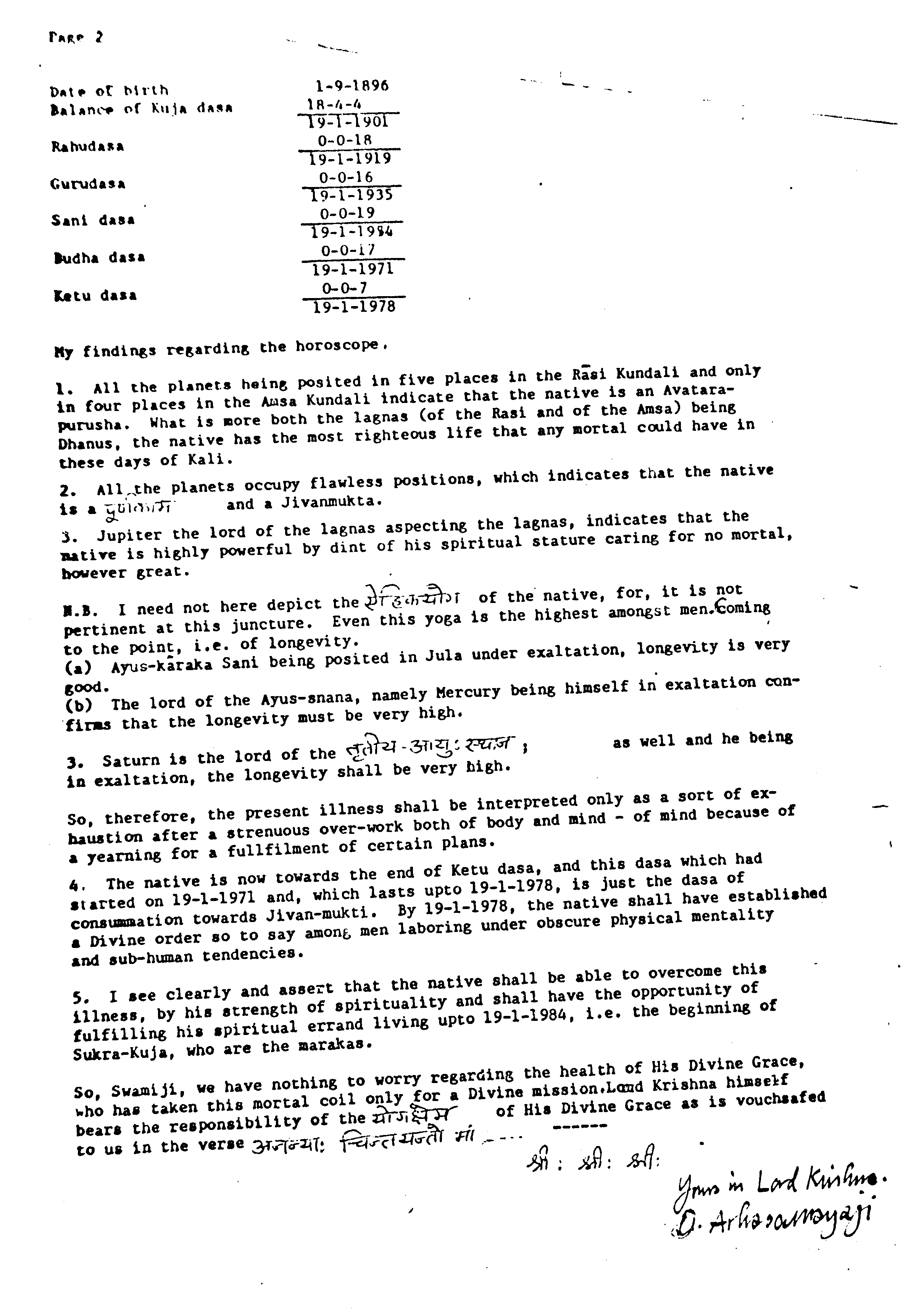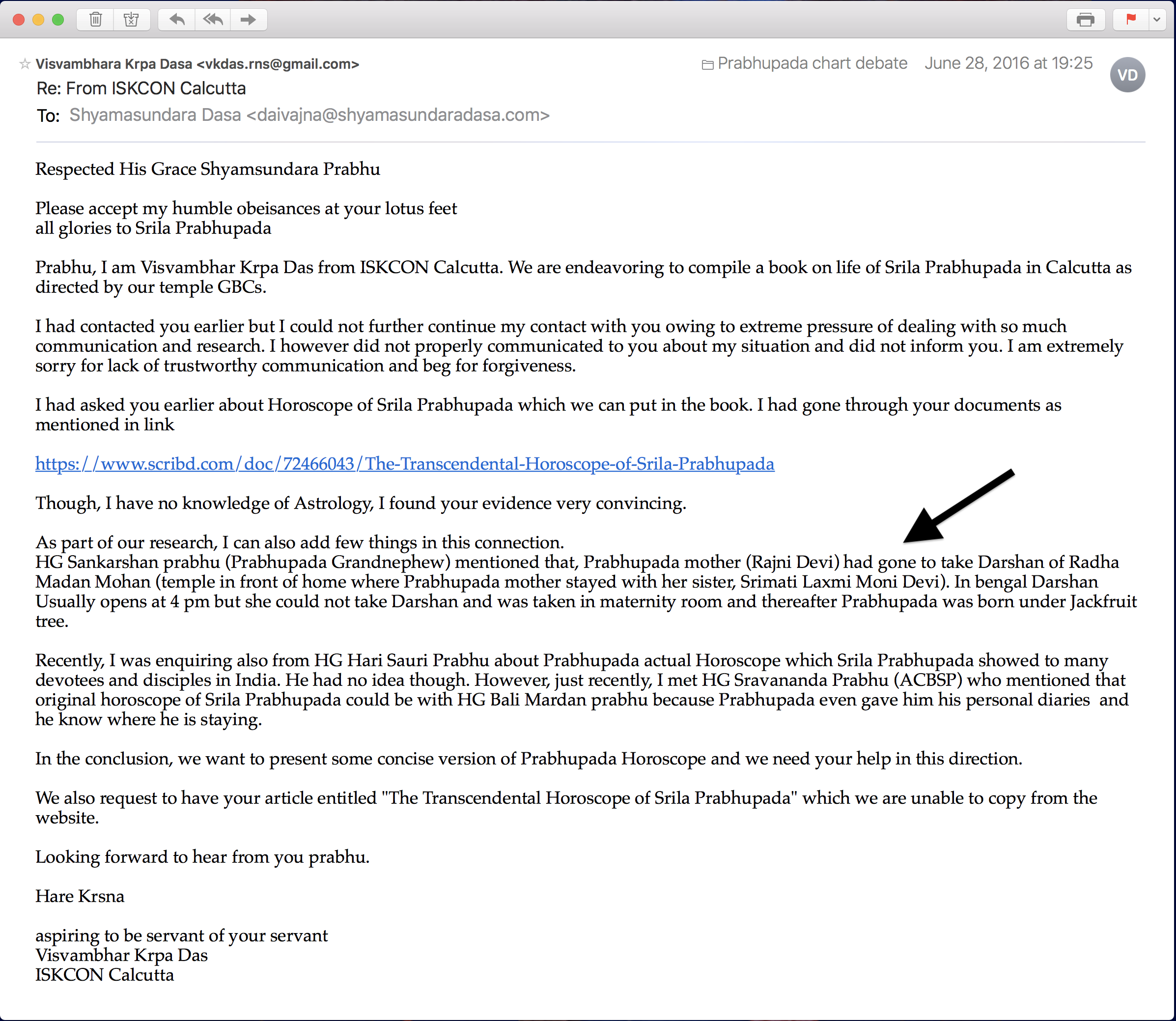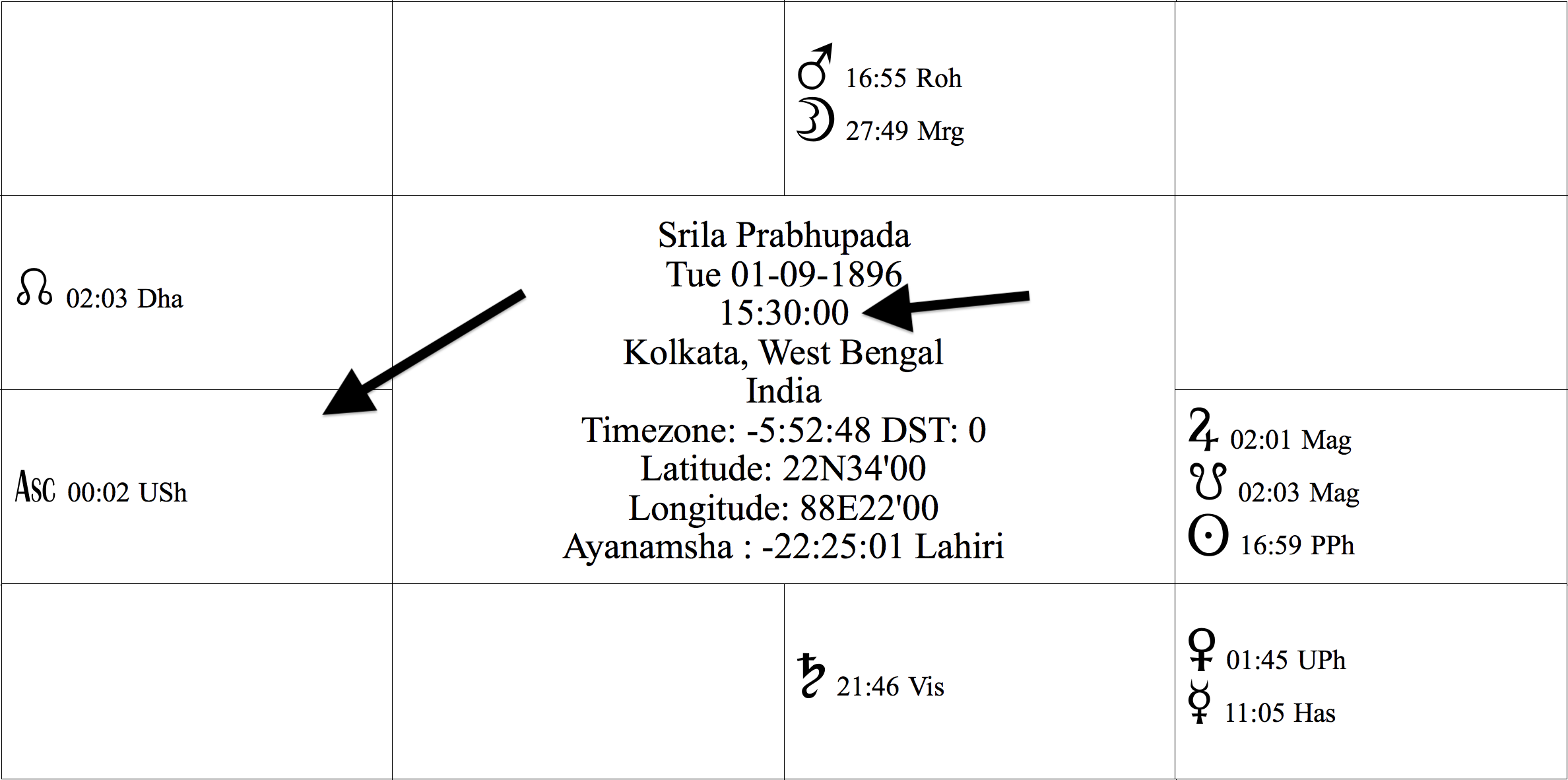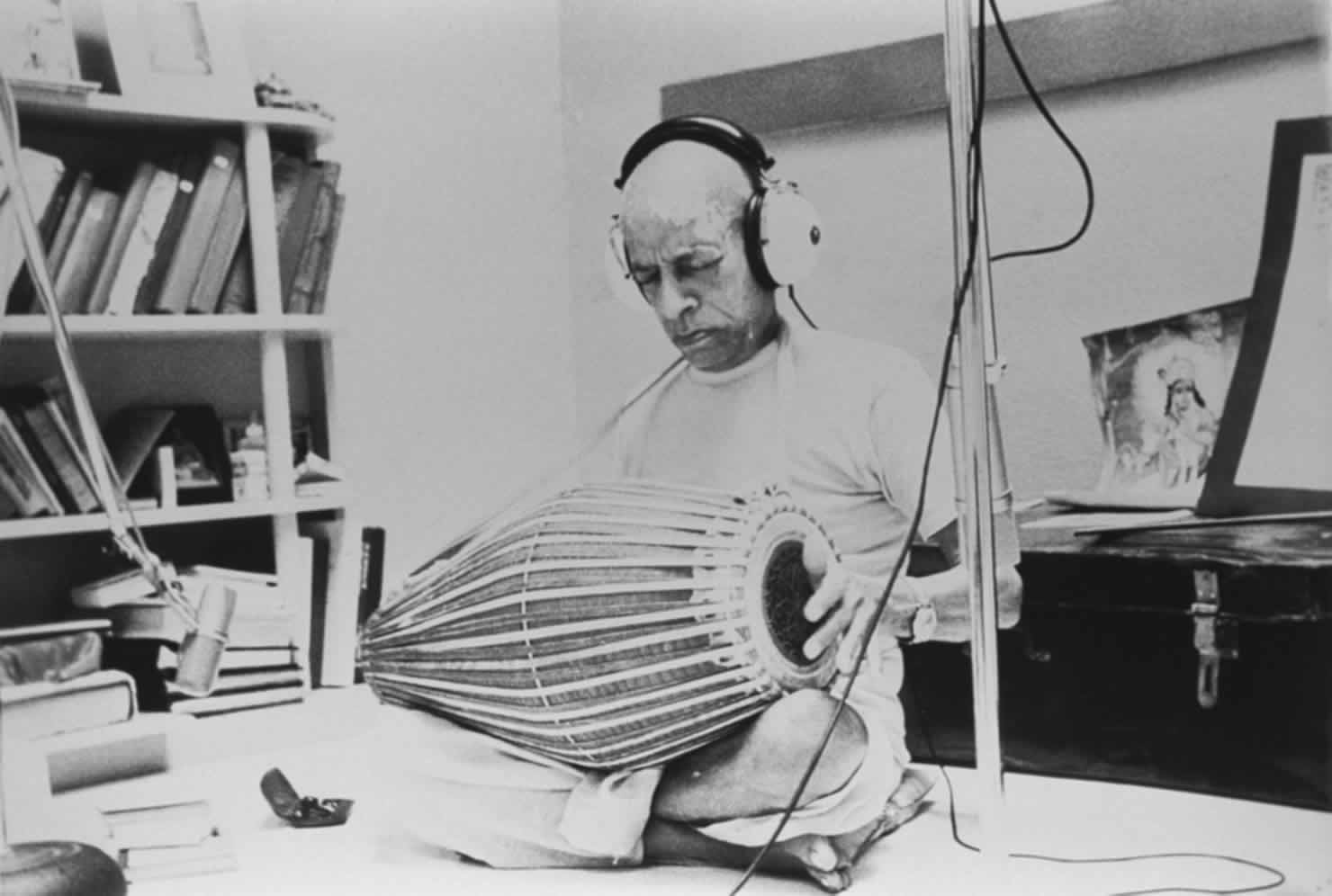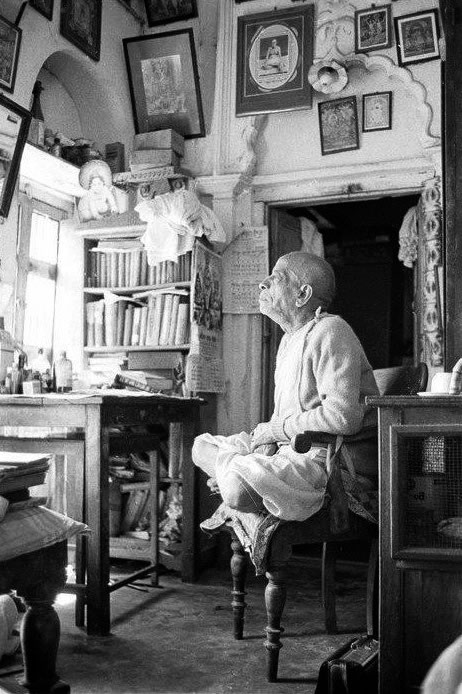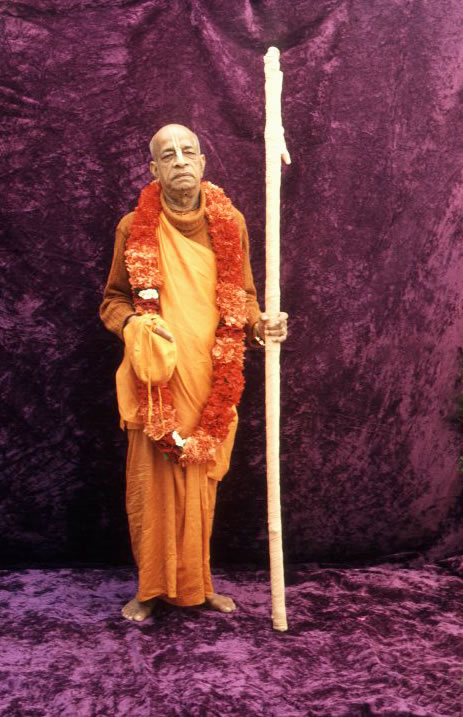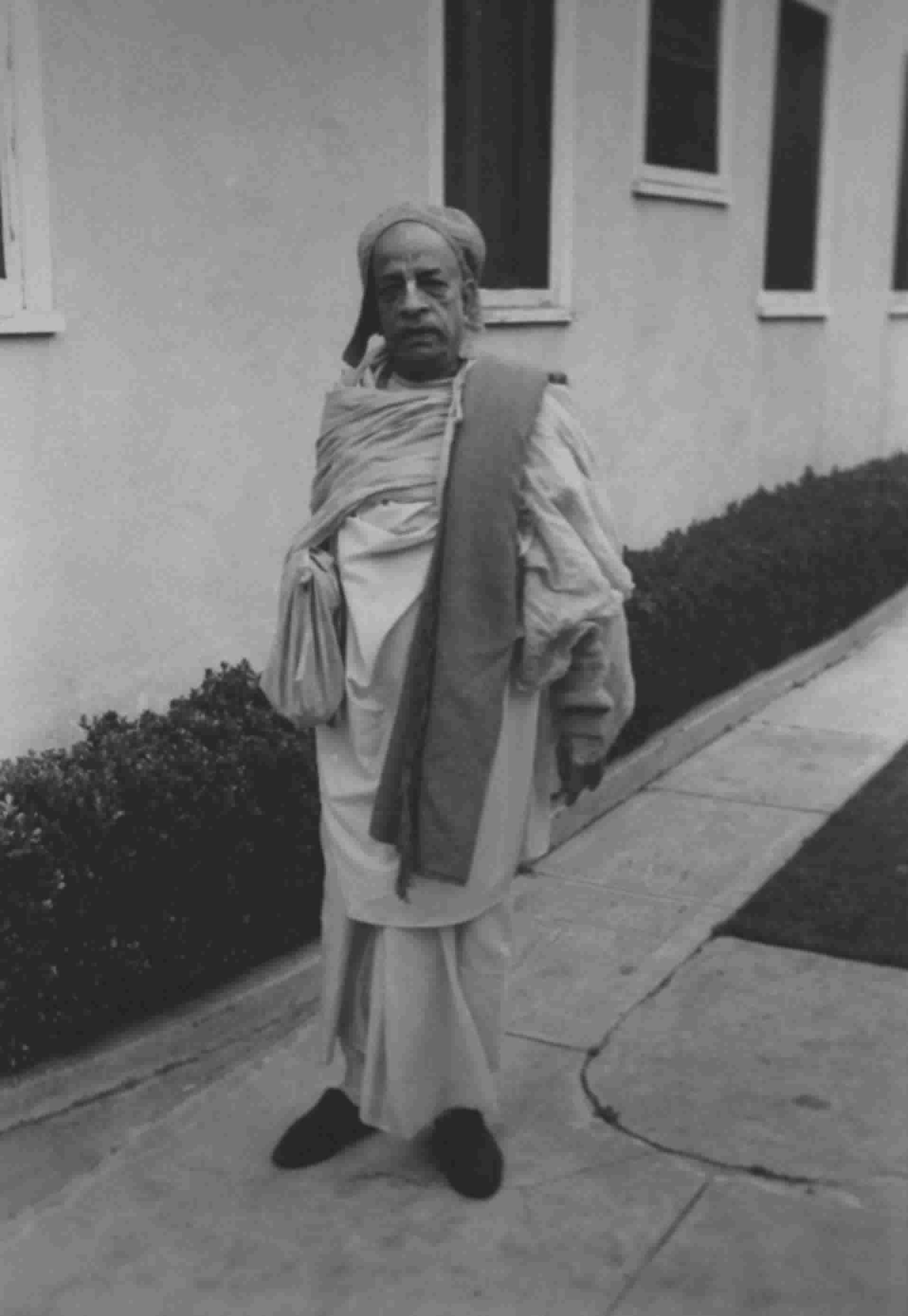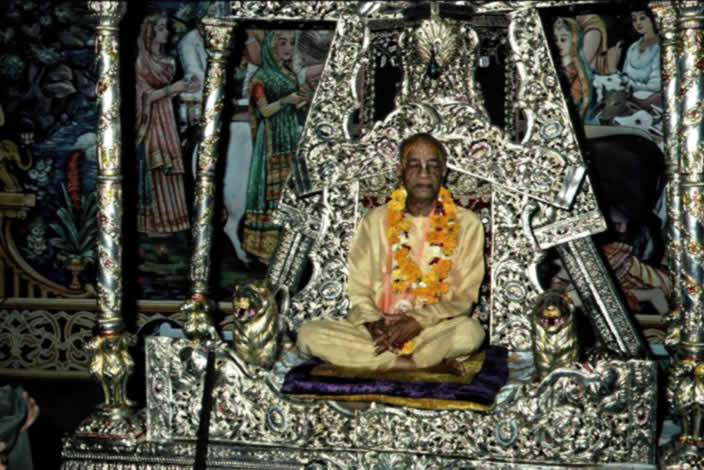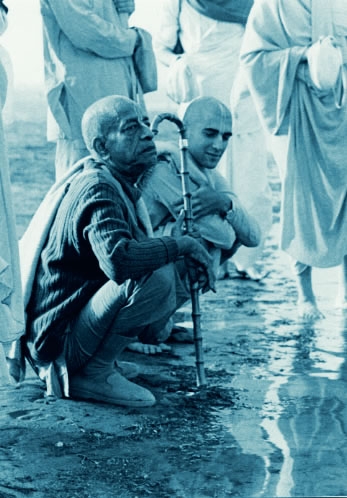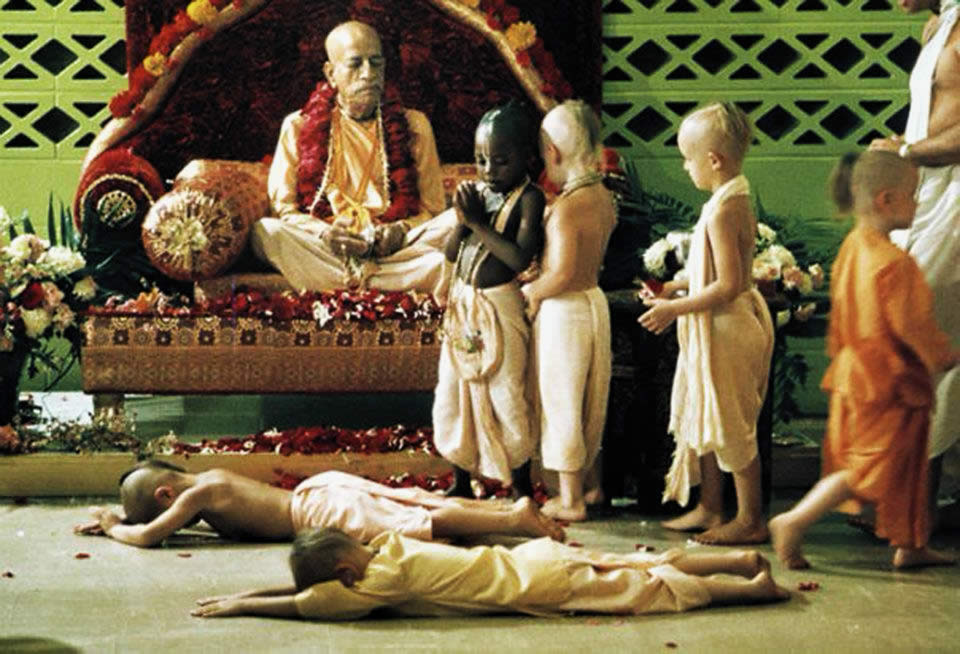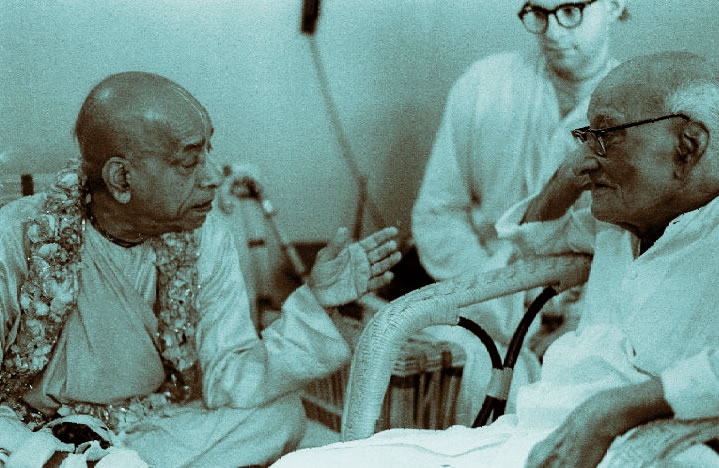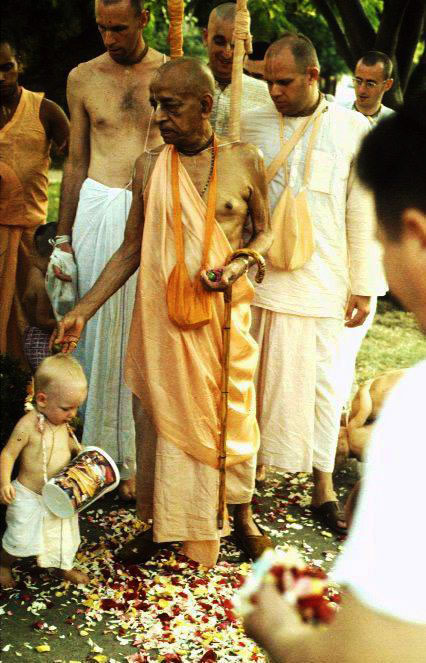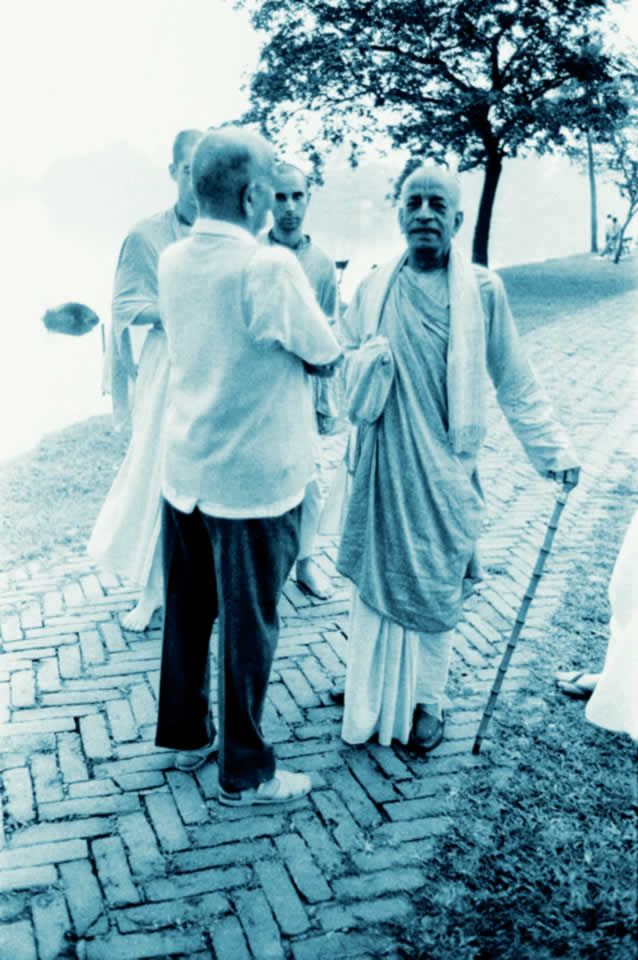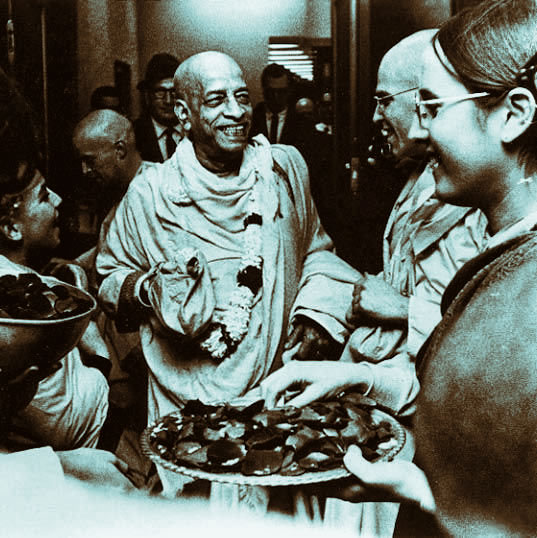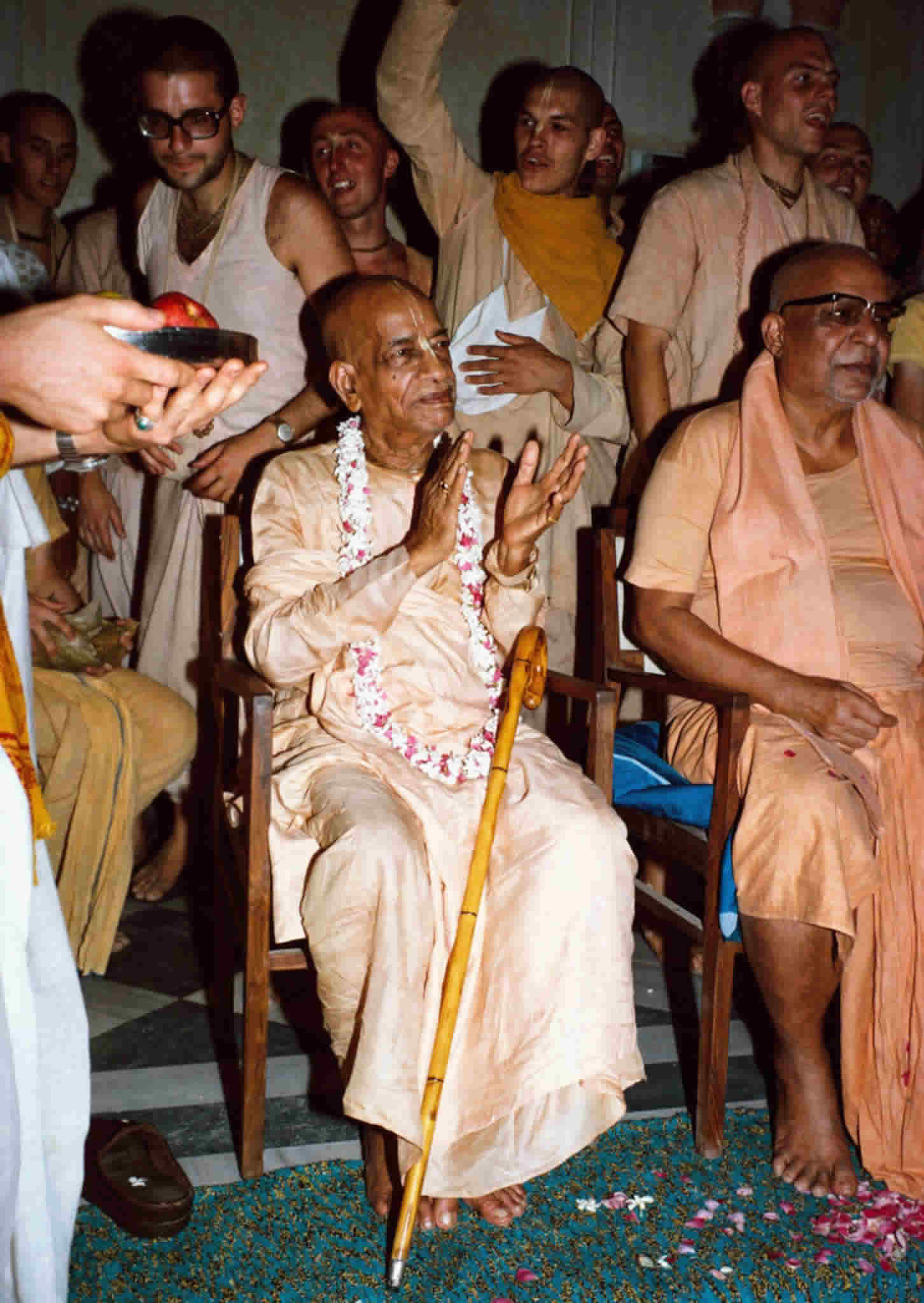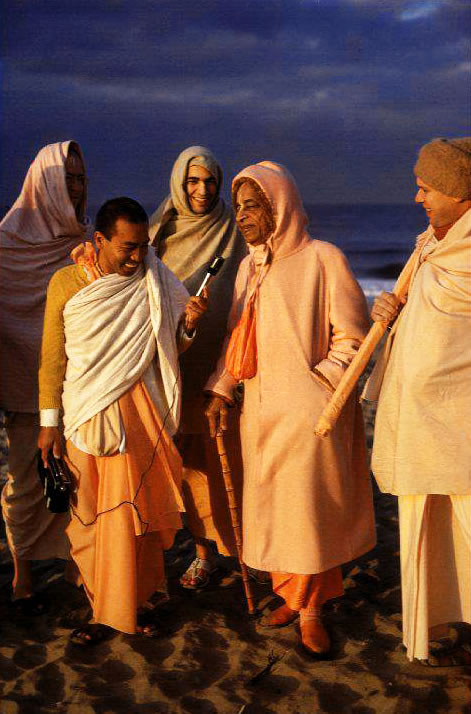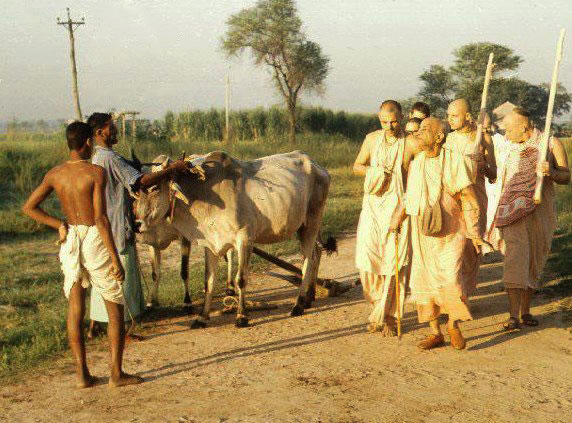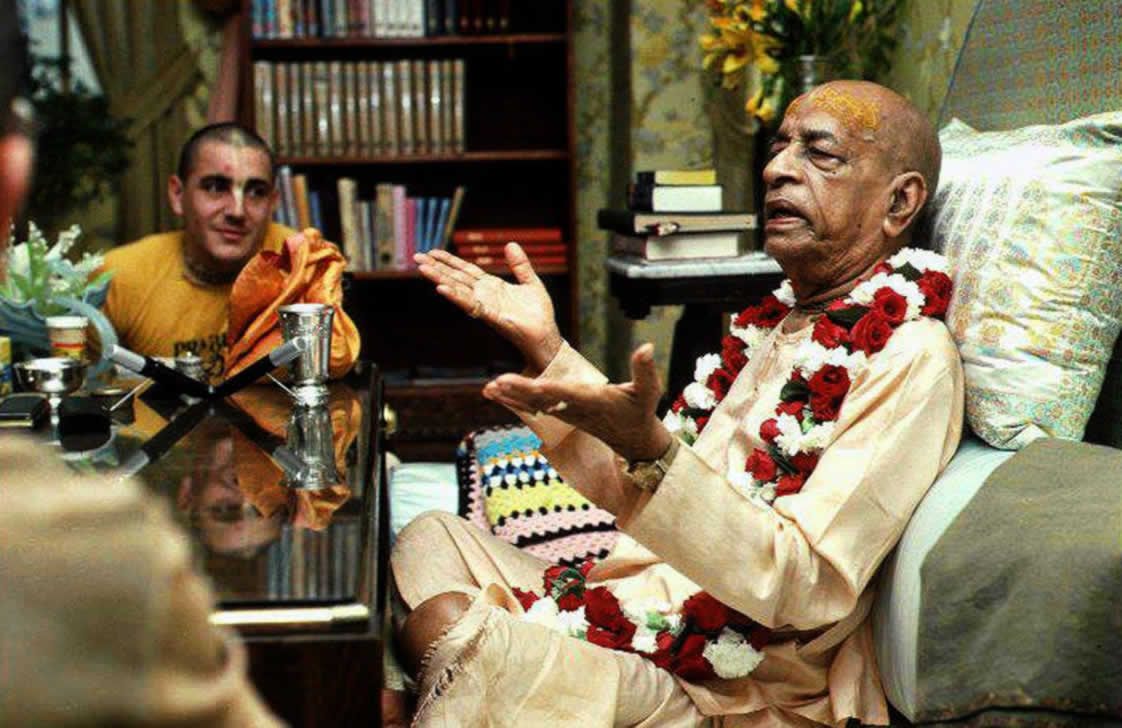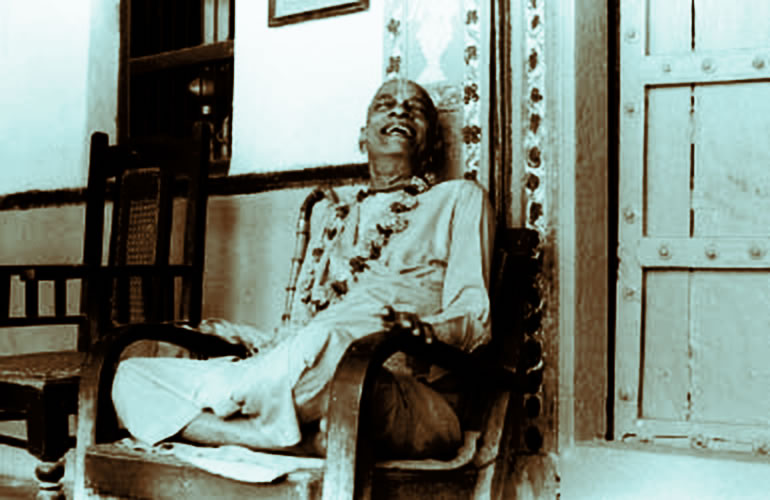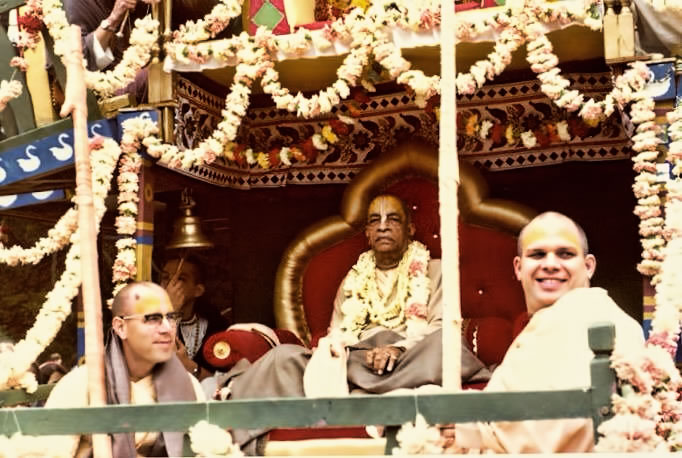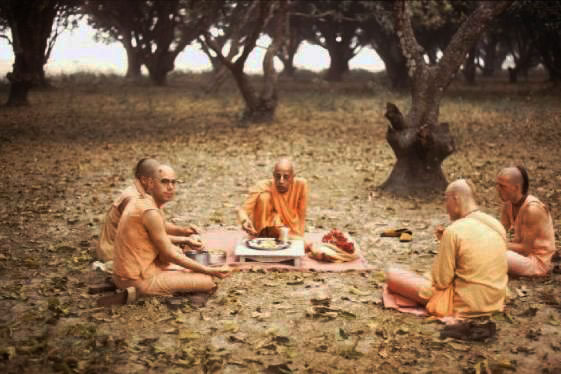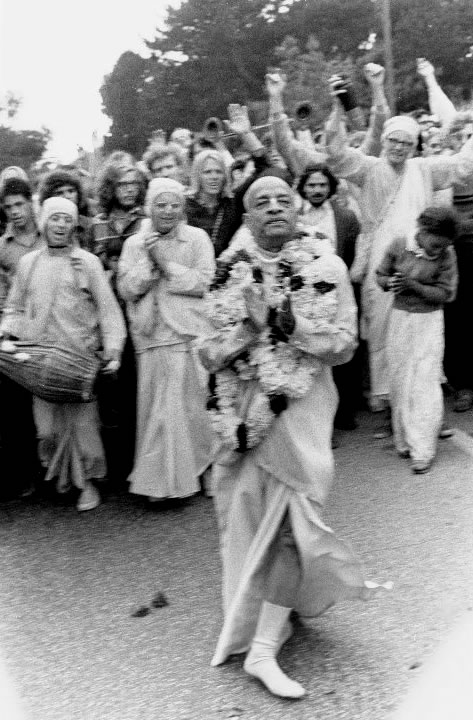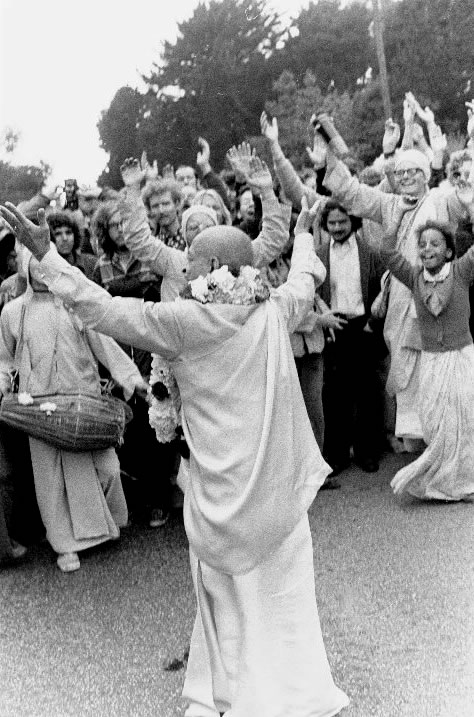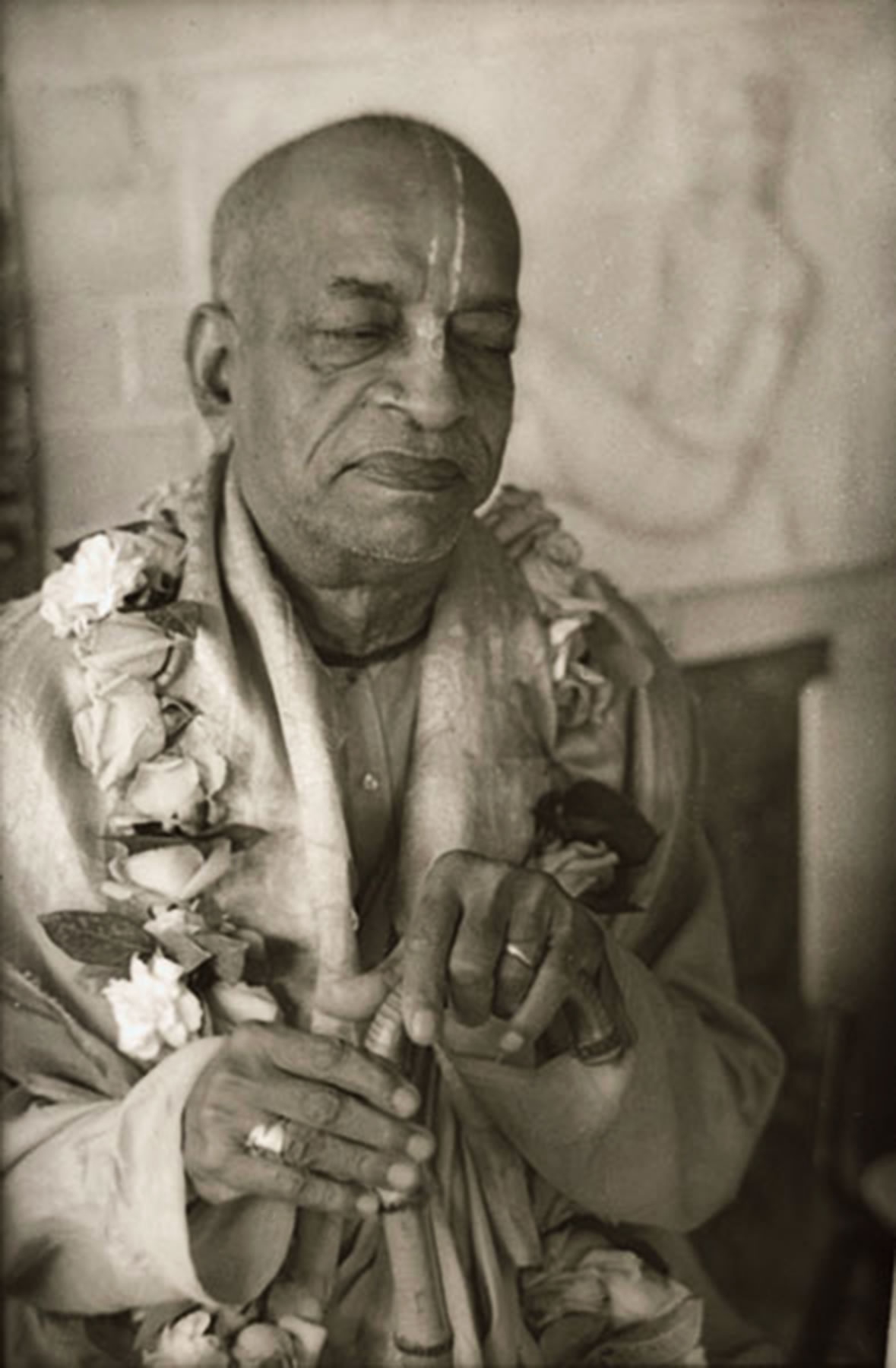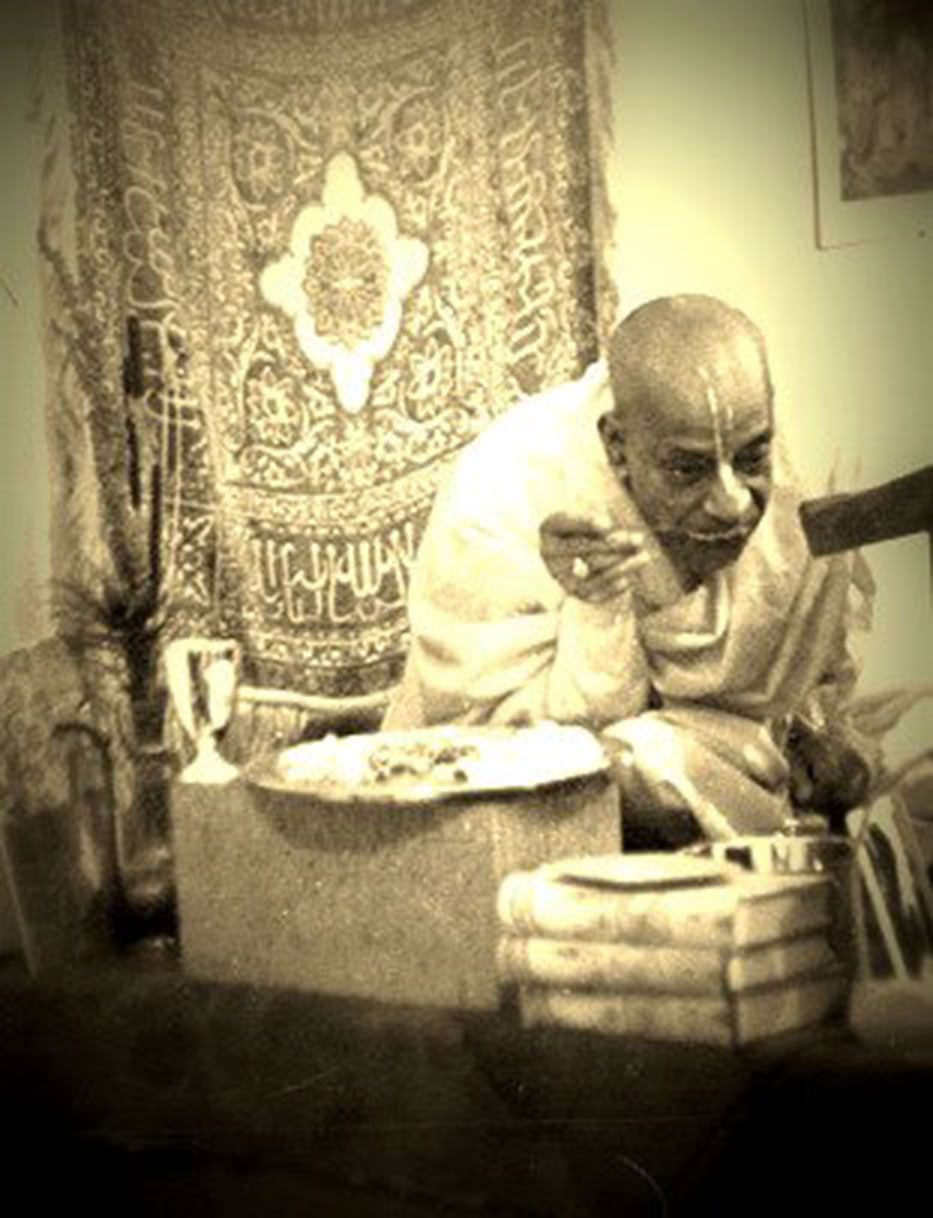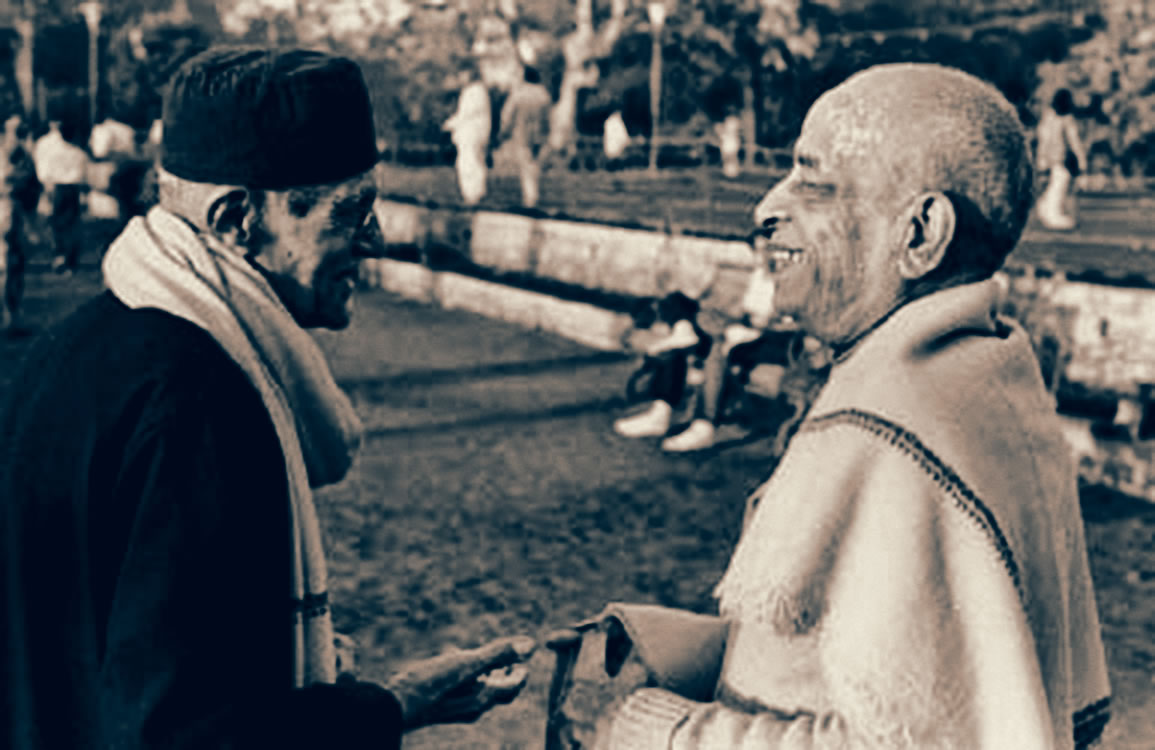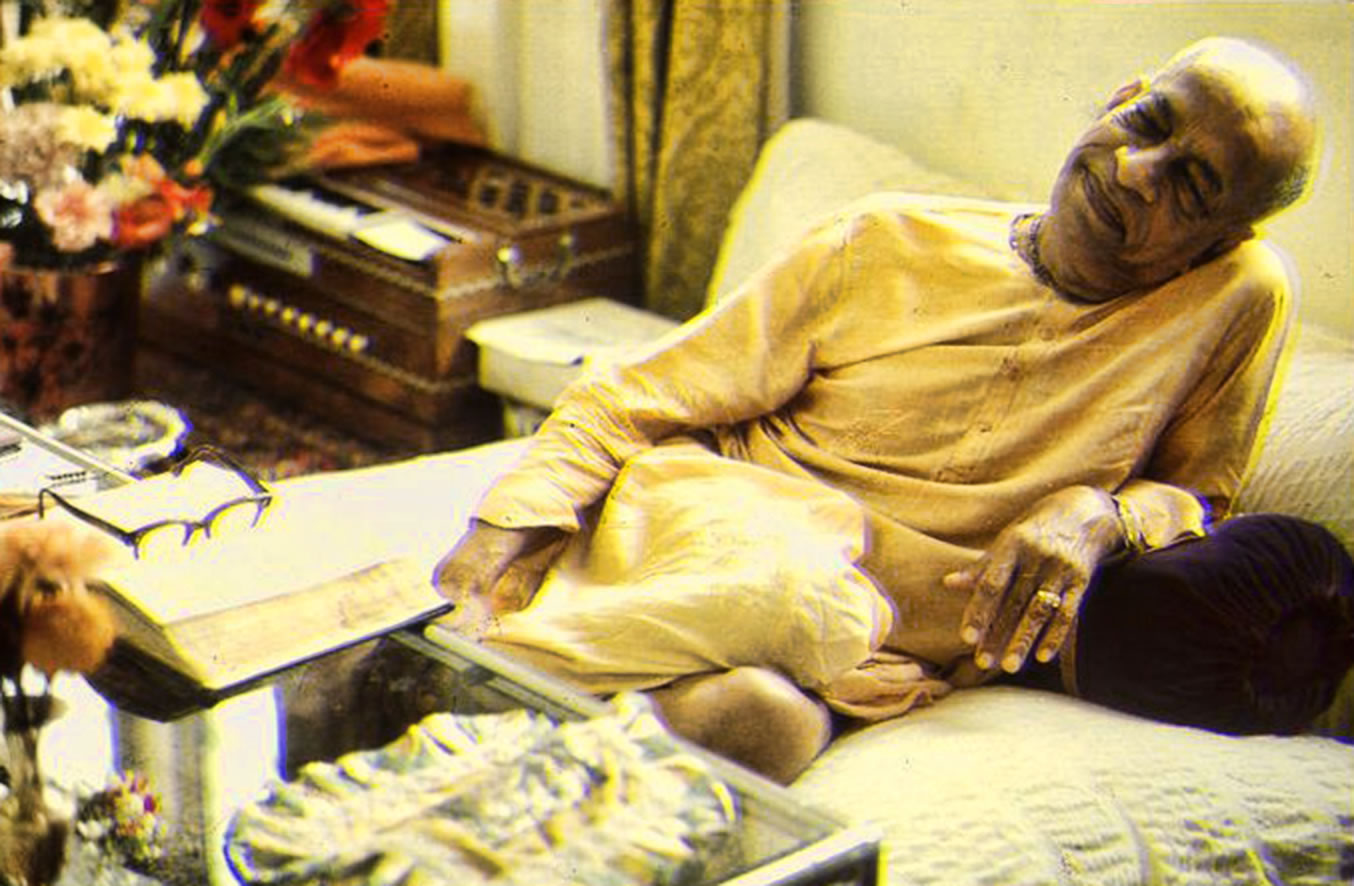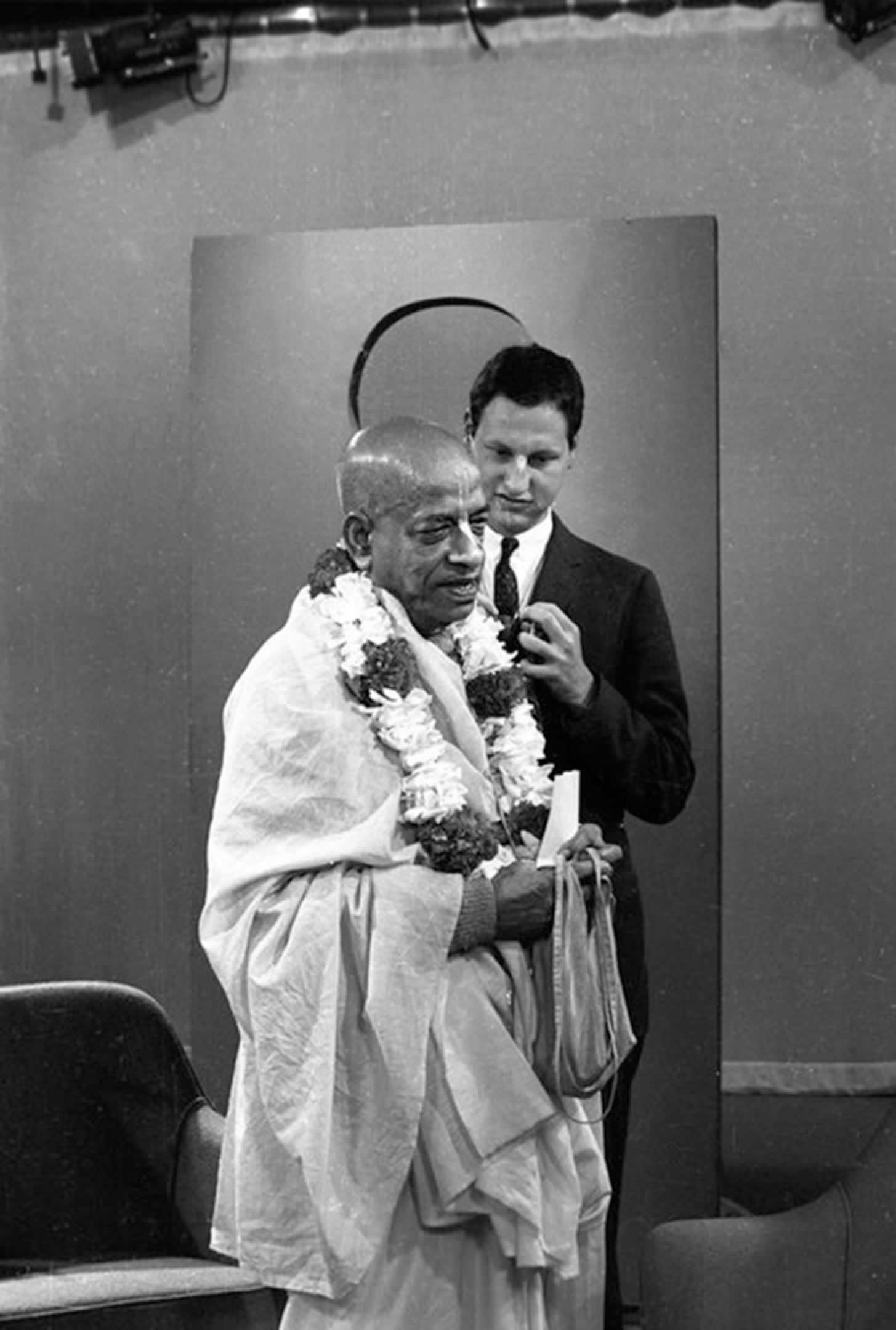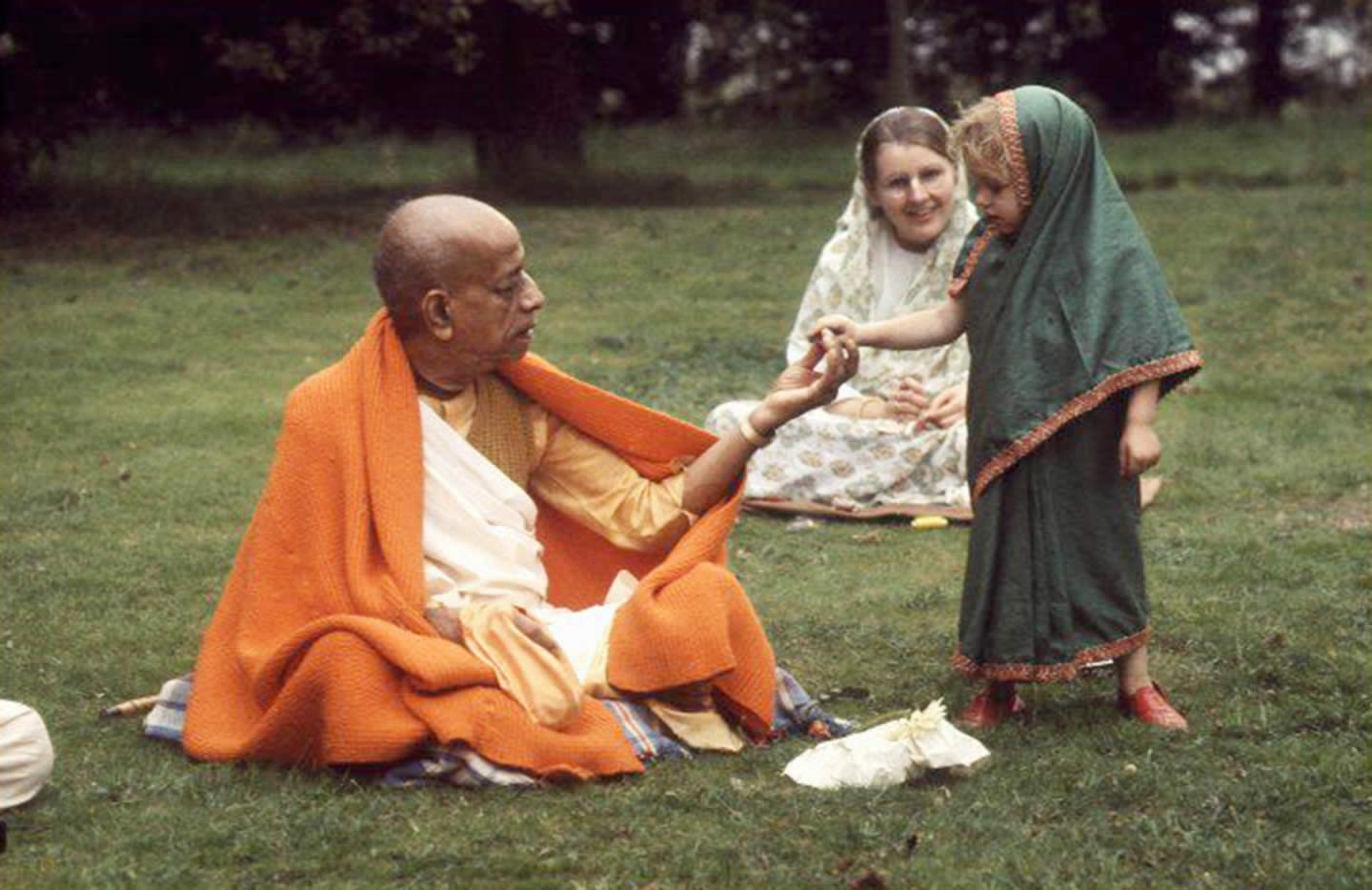Chapter 2
An Analysis of Nalini Kanta’s
Statements Regarding
Srila Prabhupada’s Chart
Page 5
1 2 3 4 5 6 7 8 9 10 11
2.2.1 Give Preference to the Time Prabhupada Gave
2.2.2 The Time Factor
2.2.3 The Letter
2.2.4 Prabhupada Well Aware of Astrology as a Young Man
2.2.5 Objection Based on Candra
2.2.6 Makara Rising
2.2.7 “About 4:00 PM”
2.2.8 Nalini Chooses 3:30 PM
2.2.9 Update 2019, Vital New Evidence
Abstract: We demonstrate that all of Nalini’s statements regarding the Makara rising chart are incorrect and establish that Srila Prabhupada did not have Dhanus rising as Nalini claims but rather has Makara rising. In so doing we note the long standing history of this controversy and its origins. We discuss the significance of the time of birth and Nalini’s arguments for changing it. I argue that we should prefer whatever Prabhupada gave us because he was well aware of the importance of the time of birth in astrology. We analyze Nalini’s fallacious use of the Drekkana argument and show how it is not applicable in the way Nalini states. We then go through all of Nalini’s objections to Srila Prabhupada’s Makara rising chart and demonstrate how they are based on a simplistic and one-sided presentation of astrological theory. We discuss the spiritual factors in a horoscope especially in regard to the 8th house. We explain the Viparita Raja yoga in Prabhupada’s chart. And expose several contradictions made by Nalini Kanta in reference to Guru in the 8th as well as in relation to the chart of Srila Bhaktisiddhanta Saraswati Thakura. We demonstrate the fallacy of saying that one sign or planet is bad and another good. We then analyze Srila Prabhupada’s planetary periods and finally compare Prabhupada’s chart with that of Srila Bhaktisiddhanta.
Before I begin I should like to say that I do not fault Nalini Kanta Prabhu for wanting to praise and glorify Srila Prabhupada. That is the loving duty and pleasure of the disciple. We humbly request that this essay be taken in the same spirit.
2.1 History of the Controversy
It should be noted that in 1980 when I was in India my GBC at the time, Adikeshava Swami (co-GBC of the BI), told me that HH Satsvarupa Swami wanted to do something relating to Srila Prabhupada’s horoscope for the Lilamrta (Prabhupada's biography). He requested me on behalf of Satsvarupa Swami to delineate Srila Prabhupada’s chart and that he would put it into literary form. Satsvarupa Swami provided me with the following birth details for Srila Prabhupada: September 1, 1896 at 4:00 PM LMT (local mean time) Kolkata, India.
I did my best to fulfill my obligation and did a write up of the chart and sent it to Adikeshava Swami who forwarded it to Satsvarupa Swami. Some time later Satsvarupa Swami sent me a copy of what he had written based on my material and wanted me to check it to make sure that it was still accurate. I did as requested and sent it back. A few months later I found out that Satsvarupa Swami decided not to include Srila Prabhupada’s horoscope in the Lilamrita, but just oblique references to it. I was a little surprised by this change. I wrote asking, why? He responded by saying that when the manuscript was sent to Los Angeles for production two astrologers namely Nalini Kanta Prabhu and Srikara Prabhu came to know about the astrological contents. On examining what I had done they declared that I was totally wrong, Prabhupada couldn’t have a Makara Lagna. “It must be a Dhanus Lagna” they claimed and demanded that it be changed. Satsvarupa Maharaja explained that he was no astrologer and could not defend what I had written so he decided that in order to avoid controversy he would not publish the chart at all.
Nalini Kanta has admitted in his current paper (on page two), that he first came to the conclusion that Srila Prabhupada must have been mistaken in his birth time when he had only been studying astrology for a few months. We would like to humbly suggest that he clearly didn’t have the insight or training then to make such a momentous decision. The reading of the horoscopes of great souls requires a bit more insight than that of a beginner.
2.2 The Time of Birth
The most important factor in delineating a chart is the Lagna. The Lagna is the point rising on the eastern horizon at any given time, it is a very quickly moving astronomical entity and is determined by the time and place of birth. Thus the time of birth is very important. Much of the present discussion will be centered around what the time of Srila Prabhupada’s birth is. If we know this then we can construct his horoscope. (On the equator the Lagnas change every 2 hours. As we move further from the equator these timings vary.)
Prabhupada’s time of birth is approximate. He has stated he was born at “about” 4 PM. This is where the debate really starts. How much license should we take with the Guru’s words? Is Srila Prabhupada to be believed when he makes a statement about himself? Or, should we make adjustments to suit our speculations or lack of understanding? If the Guru says something which we cannot understand we should not immediately assume that he was wrong. Rather we should understand that our poor fund of knowledge has created an apparent contradiction. We must either ask the Guru for an explanation, or if unable to do that become sufficiently trained to understand the subject matter. We will then find that the error which we had at first attributed to the Guru actually only existed with us. This I suggest is the case with Nalini's inability to read and understand Srila Prabhupada's chart based on the actual 4 PM time given by Prabhupada.
If the Guru says something which we cannot understand we should not immediately assume that he was wrong. Rather we should understand that our poor fund of knowledge has created an apparent contradiction. We must either ask the Guru for an explanation, or if unable to do that become sufficiently trained to understand the subject matter. We will then find that the error which we had at first attributed to the Guru actually only existed with us. This I suggest is the case with Nalini's inability to read and understand Srila Prabhupada's chart based on the actual 4 PM time given by Prabhupada.
2.2.1 Give Preference to the
Time Prabhupada Gave
I also suggest that if two charts explain and glorify Srila Prabhupada then the chart of preference should be the one that is consistent with the time that Srila Prabhupada gave. That being, 4:00 PM, September 1, 1896, Kolkata, India. Not one based on speculative rectification. Rectification is a method in astrology to adjust the time of birth if the horoscope is not accurate and doesn’t fit the individual. Our school is to take the direct approach first. We only take the indirect approach if a direct approach is not feasible or requires interpretation. In this case, with a time of “about 4:00 PM” a perfectly acceptable chart is arrived at which clearly points out the future greatness of Srila Prabhupada. There is no need for “adjusting” the birth time earlier and thus changing what Srila Prabhupada said. (If a change is warranted then it would be for later than 4 PM because Prabhupada thought it might be between 4-5 PM, this gives the same Lagna, but not 3:30 PM. This is discussed in Abhiram's letter to Tamal Krishna Goswami (TKG), also see letter from TKG to me with references from his diary which clearly indicates what Prabhupada’s time of birth was and that Prabhupada accepted that the chart drawn up according to this time was most accurate.)
I trust that from your reading of my delineation (in chapter 1) of Srila Prabhupada’s chart (and also Ojha’s reading, chapter 5) no one thought I was insulting Srila Prabhupada or demeaning him. But rather that based on the time that Srila Prabhupada gave we can see why he is such a great Mahabhagavata devotee of the Lord. There is no need to change anything that Srila Prabhupada said. It is not for the disciple to change the words of the Guru. But rather it is for the disciple to understand the words of the Guru.
It is not for the disciple to change the words of the Guru. But rather it is for the disciple to understand the words of the Guru.
2.2.2 The Time Factor
Prabhupada was coming from a high class Vaisnava family where such things are recorded. This is proved by the fact that his chart was done immediately after his birth and the prediction was made that Srila Prabhupada would open many temples and cross the sea. Also the BBT Archives has copies of the charts that Srila Prabhupada had done in India. The time given by Srila Prabhupada to all the astrologers was 4:00 PM. There is also a letter (see below) in which Prabhupada gives his time as “about 4:00 PM.” It would thus seem that Srila Prabhupada was set on his time of birth being 4:00 PM not 3:30 PM. As Hari-sauri has pointed out in his statement, Prabhupada consistently gave his birth time as 4:00 PM, so that is what we should also use. We also note that in his diary (in chapter 6) TKG mentions that Srila Prabhupada gave his time of birth as 4 PM not “about” 4 PM. TKG (6.1) states:
[Srila Prabhupada said] I was born in the evening at 4:00 p. m. It was Nandotsava. You can consult an old panjika to see the day. It was a Tuesday. Mithuni rasi; mrgusira naksatra [sic].
2.2.3 The Letter
Vrindaban 6th December, 1975
[address deleted]
My Dear Jay Krishna Thakura,
Please accept my blessings. I beg to acknowledge receipt of your letter dated November 30, 1975.
Yes I remember you were coming to see me daily at Bhaktivedanta Manor during my stay there in 1973. Regarding your question about my birth. I was born September 1, 1896, Tuesday at about 4:00 in the afternoon. My rasi is Metthuna [Mithuna=Gemini].
I hope this letter finds you well.
Your ever well wisher,
A. C. Bhaktivedanta Swami
ACBS/hda
2.2.4 Prabhupada Well Aware of
Astrology as a Young Man
Svarupa Damodara: Srila Prabhupada, are these astrologers, ah, are, can we believe in them, what they say? Called pseudo- science.
Prabhupada: No. Astrology is a science. (break) ...that I shall go to the foreign countries and throughout the whole world I will establish so many temples, so many things... this...
Svarupa Damodara: So they have some intelligence to tell that...
Prabhupada: No, no. That is calculation, calculation. This astrologer, this astrologer was a very big astrologer and when I was in service, Dr. Bose’s laboratory, so Dr. Bose was treating one patient. He was vomiting blood. So he was treating as tuberculosis. Then he could not cure him after giving all medicine. Then he asked the astrologer, this astrologer who made my horoscope, ‘What is the matter? Panditji, can you tell?’ So he calculated. He said, ‘You are making wrong treatment. He has got some sore in the throat. It is not heart.’ And he treated, he was cured.
Yasomatinandana: Vedic science is so perfect.
Prabhupada: Yes. He knew it.”
Morning Walk Los Angeles, December 8, 1973
This conversation indicates that Srila Prabhupada was well aware of astrology as a young man (see also transcript of conversation with Yamuna Devi). Apparently the astrologer who had made the predictions that Prabhupada would travel to the West and do big preaching was also associated with Bose Chemical Laboratories while Prabhupada was employed there as a young man in his early 20’s. This indicates that Srila Prabhupada was consulting him while he was an adult. In order to do so he would have had to give the astrologer accurate birth information. Srila Prabhupada’s memory, as many devotees have pointed out in the past (see Hari-sauri and Yamuna transcript), was phenomenal.
We suggest that Srila Prabhupada therefore gave the same birth time to the astrologers in 1975-77 as he did when he was a young man. He was not mistaken about his time of birth. Also it is likely that, if the great astrologer who had calculated Prabhupada’s chart predicting his travels and preaching success had thought the time needed to be adjusted, he would have told the same to Srila Prabhupada who would have duly noted it for future reference.
2.2.5 Objection Based on Candra
Nalini Kanta has stated (Nalini p. 1) that Prabhupada was mistaken about his birth time because in the letter cited above Prabhupada gives both his birth time and his Rasi (Candra Sign). Prabhupada in the letter states his birth as about 4 PM and his Rasi as Mithuna (Gemini). However if you calculate the chart in reality his Rasi is Vrshabha. Thus, according to Nalini’s logic, since Srila Prabhupada didn’t know astrology and got his Rasi mixed up then it follows that he also got his birth time wrong. Thus Nalini Kanta feels that the actual birth time must be such that Dhanus must be rising.
We counter this by pointing out that people are more apt to know their time of birth than the disposition of the planets in their charts. If a mistake is to be made it would be with the planetary position not the time of birth. However we have a stronger argument which is derived from the research of the Vaisnava Calendar Committee.
The degree of Srila Prabhupada’s Candra is 28TA06, very close to Mithuna. At the time when Srila Prabhupada was born, and even today, in Bengal, astrologers used panjikas (ephemirides) made according to siddhantas like Surya-Siddhanta, Siddhanta-Siromani, etc. However these Bengali Pandits make their calculations without adding the necessary bija correction that would give planetary positions that agreed with observable reality. Anyway this lax method of planetary calculation still goes on and it was documented by Markandeya Rsi Prabhu in his 1990 report to the Vaisnava Calendar Committee.
Candra ’s position is often calculated so erroneously in Bengal that even for calendars calculated for Bengal the ekadasis are wrong a significant percentage of the time. That means that they are off by several degrees for the Candra . (This is one of the main reasons that we don’t rely on Bengali Panjikas for our Vaisnava Calendar.) In the example Markandeya Rsi gives on pages 52-53, he compares the endings of all the tithis (lunar days) from Aug 15th to September 14th 1989 as calculated by P.M. Bagchi and Lahiri. Bagchi is following the old, inaccurate style of calculating without correction for observable reality. Markendaya Rsi says: “The difference is, in the average, more than two hours . . .” Individual days could diverge by as much as 4.5 hours and that was only in a sample space of one month. Other months may be even worse. Considering that Candra has a mean velocity of ≃ 0.549° per hour, it is not difficult to see how, by using the old un-corrected method popular with most astrologers in Prabhupada’s day, that a 2 or 3 degree mistake in the position of Candra could have easily occurred. (4.5h X .549°/h = 2.47°)
We now see how it is very possible for Srila Prabhupada to have been told by an old style astrologer, using an unpurified Siddhanta method, that Mithuna (Mithuna) was Prabhupada’s Rasi as opposed to Vrshabha. A mistake of only two degrees would place Prabhupada’s Candra in Mithuna. This disposes of the notion that Prabhupada didn’t know his own time of birth because the Rasi was different from modern up-to-date hi-tech computer calculations. The mistake was not with Prabhupada, but with the inaccurate methods of calculation employed for finding the position of Candra .
2019 update. After re-reading this text we note that Pradyumna Prabhu stated that Srila Prabhupada used the Directory Panjika from Calcutta, which is not as accurate as Lahiri.
Another point to remember is that Srila Prabhupada may have made a simple error in nomenclature. In TKG’s statement he gives the following from his diary:
Prabhupada became noticeably enthused and said: ’Let us consult an astrologer—whether I should go? Whether I shall be cured? How long I shall live? I was born in the evening at 4:00 p. m. It was Nandotsava. You can consult an old panjika to see the day. It was a Tuesday. Mithuni rasi; mrgusira [sic] naksatra. I am prepared to go to the West.’
The point being that Mrgasirsa nakshatra straddles both Vrshabha and Mithuna, half in one and half in the other. In Bengal especially, all the planets, not just Candra , are given in the chart with reference to the nakshatra it resides in (see description of Lord Caitanya’s horoscope). Also we see from Pradyumna’s statements (see transcript) that Srila Prabhupada would often be asked his Nakshatra when going into a temple. The reason is that when puja is done to the Deities on behalf of someone (Yajamana) the Pujaris request the Yajamana’s name, gotra and nakshatra and this is told to the Deities at the time of puja to indicate the identity of the sponsor. We may thus infer that because Mrgasirsa is actually in both signs that some confusion may have crept in (along with the possibility of inaccurate planetary calculation). So in one sense to say Moon is in Mithuna is not exactly wrong because it is the Nakshatra position that is most important and Mrgasirsa is in both Vrshabha and Mithuna.
There is one obvious explanation for Prabhupada giving Mithuna Rasi—Gemini Moon sign that we have all over looked. It is very possible that whoever informed Srila Prabhupada that his Moon was in the sign of Mithuna may have been using a different ayanamsa than that which Nalini Kanta and I use. We both use Lahiri's ayanamsa. Devotees experienced in India know that there are varied opinions on practically every subject, this also holds true for ayanamsa. The most popular ayanamsa in India today is the Citrapaksa ayanamsa popularized by N.C. Lahiri but this a recent phenomena of this century. Though Lahiri's is the most popular today, still there are several competitors. Who knows what the situation was like back at the turn of the century? Pradyumna Prabhu once told me that he had come across a letter by Srila Bhaktisiddhanta which was sent out to learned pandits all over India inquiring from them which ayanamsa they used. Apparently the Thakura was trying to see if there was any consensus of opinion or may have been attempting to arrive at a correct ayanamsa after consulting others. (We do not know the results of the Thakura's research but would be greatly interested to find out.) Considering that Srila Prabhupada's Moon is less that two degrees away from Mithuna by Lahiri's ayanamsa it is quite possible that a poor calculation or different ayanamsa or some combination of both could easily put Candra into the next sign. If the other astrologer was indeed using a different ayanamsa then there would be absolutely no mistake in Prabhupada saying his Moon was in Mithuna.
2.2.6 Makara Rising
Nalini Kanta has said on page one of his paper that “[Srila Prabhupada] at other times mentioned that he had Capricorn rising.” I have never heard or seen this before. I would like to see a reference to this. If so, it is the truth. Argument over. How can Nalini dare go against the stated opinion of his own Guru?
2.2.7 “About 4:00 PM”
That is Srila Prabhupada’s statement concerning his birth time. According to the dictionary “about” means: 1. Approximately; nearly. 2. Almost.
If someone says they will meet you “about” 4:00 PM you would expect them to be at the meeting place fairly close, plus or minus a few minutes from 4 PM. But not 3:30 PM
The only time that Srila Prabhupada varied from this time was when he asked Abhirama Prabhu to ask from Ojha if the chart would be different if he was born after 4 PM. In the letter (see transcripts of charts and letters from 1977) from Abhirama Prabhu to Tamal Krishna Goswami, Abhirama says:
I visited the astrologer [Ojha] and inquired about Srila Prabhupada’s horoscope if it were calculated at 4:30 or 5:00. He calculated that it would remain the same between the hours of 4:00 and 5:00.
That means that it could only remain Makara Lagna. This also seems to imply that Srila Prabhupada was wondering if there was any change had his birth been later than 4:00 PM. He did not inquire about it being before 4:00 PM.
Hari-sauri has also made some strong comments regarding the time of birth used by Srila Prabhupada. His opinion is that Srila Prabhupada would not make mistakes in this regard. That 4:00 PM was the earliest he could have been born, because he didn’t favor any time earlier but may have accepted a later time say up to 5:00 PM. For details please read Hari-sauri ’s letter. Abhirama Prabhu, after his initial comments comparing SP’s approximate time of birth to his approximate place of birth, conceded in a phone call to Hari-sauri on October 11, 1995, that Hari-sauri ’s reply was a more accurate analysis than his own which, he said, was written when he wasn’t thinking clearly.
I think that we have sufficiently covered arguments regarding the time of birth. I would like to again emphasize that if two charts based on different times both nicely describe his glories then the one based on the time given by Srila Prabhupada should be chosen.
2.2.8 Nalini Chooses 3:30 PM
We should like to point out that Nalini Kanta Prabhu changed Prabhupada’s time of birth just enough so that the very last moment of Dhanus was rising. This was done in order that the time be as close to 4:00PM, the time SP gave, as possible. However, he must have made the calculations by hand because he made the difference so close that when I calculated it on my computer, using Lahiri Ayanamsa, (which both of us use) I actually got Makara rising at 3:30 PM. To get Dhanus rising you have to push the time back to 3:29 PM and thus you get a rising position of 29 degrees, 45 minutes of Dhanus. Even one minute more puts it into Makara.
In 2016 we received new evidence from a researcher in Kolkata that explains why Srila Prabhupada always used the time 4:00 PM. That time was a “chronological landmark” in the family’s daily routine.
2.2.9 Update 2019 Vital New Evidence
Often a person’s birth time is recorded in terms of a “chronological landmark” such as “born shortly after sunrise” or in relation to the family’s daily routine such as their work schedule. Some one might say “I was born at just after 7 AM because my mother told me she went into labor and gave birth right after my father left for the office, he would leave every morning at 7 AM.”
Why did Srila Prabhupada stick to the time “4:00 PM?” Because 4:00 PM was an important chronological landmark in the daily routine of his family, especially his mother. Why? Because 4:00 PM is the standard time that temples in Bengal have afternoon darshan of their Deities. And, the De family followed this schedule of having darshan of the Deities at their local family temple.
On June 28, 2016 Visvambhar Krpa Prabhu, a devotee from the Kolkata temple emailed me to inform me that he was doing extensive research “to compile a book on the life of Srila Prabhupada in Calcutta as directed by our temple GBCs.” He further informed me of the following important piece of information (edited slightly for readability):
As part of our research, I can also add a few things in this connection. HG Sankarshan prabhu (Prabhupada’s grand nephew) mentioned that, Prabhupada’s mother (Rajni Devi) had gone to take Darshan of Radha Madan Mohan (temple in front of home where Prabhupada’s mother stayed with her sister, Srimati Laxmi Moni Devi). In Bengal Darshan usually opens at 4 pm but she could not take Darshan and was taken to the maternity room and thereafter Prabhupada was born under a Jackfruit tree.
(Click to see the original email.)
Srila Prabhupada’s mother had gone to her parental home, in Tollygunge, to give birth as is the usual custom in India. Across the street from where she was staying was a temple of Sri-Sri Radha Madan-Mohan that she would visit daily for darshan. According to the family tradition as narrated by Srila Prabhupada’s grand nephew his mother went for the 4 PM darshan of the Deities and at that time suddenly felt the onset of labor and was taken to the maternity room which was about 200 meters from the temple and gave birth.
So the probable scenario was something along these lines. Since she was heavily pregnant she would have waited till the last minute to go for darshan to avoid having to wait for a long time in her condition. So she would have left her residence just a few minutes before 4 PM say at 3:55 PM. Then just as she got to the temple for darshan she felt the time has come and goes to the maternity room 200 meters away. Visvambhara Krpa Prabhu personally told me that even at a slow pace it would only take five minutes to get to the maternity room. But, considering her condition I would assume they were going as quickly as possible. So this suggests that at about the time of darshan Srila Prabhupada’s mother was already in the maternity room and gave birth shortly after that. So his birth would have taken place at 4 PM or shortly after. How long after 4 PM is not known but since the chronological landmark was the time of darshan this suggests that it was somewhere in the range of 4:00-4:15 PM. Thus it would be impossible for her to give birth at 3:30 PM which is not the darshan time.
And, the fact that his mother went for the 4:00 PM darshan is why it was used as the chronological landmark for when Srila Prabhupada was born. Something to the effect of “your mother was going for the 4:00 PM darshan when you were born” must have been the oft repeated story. And we see that is what Prabhupada’s grand nephew Sankarshan also repeats. It also explains why Srila Prabhupada at different instances seems to have suggested a time between 4:00 PM and 5:00PM and why one of Ojha’s charts used a time of 4:30 PM, because some time would have elapsed between the time his mother went for darshan at 4:00 PM and when she gave birth. How much time we don’t know. She could have been preparing to go to the temple before the darshan time when labor started, or she could have already been in the temple. We just do not know. But we do know according to Srila Prabhupada’s grand nephew that instead of going for darshan Prabhupada’s mother gave birth to Prabhupada.
And, this also explains why Srila Prabhupada never suggested a time before 4:00 PM as darshan didn’t take place before that time. We suggest that those who want to rectify the birth time stick to limits between 4:00 PM and 5:00PM, but definitely not before 4 PM.
2.3 The Drekkana Fallacy
On page three of Nalini’s paper he states that he will describe the forms of the decanates as presented by sage Varaha Mihira in his work Brhat Jataka. (A Decanate or Drekkana in Sanskrit, is the division of each sign into 10° segments) Nalini then makes the critical statement (emphasis mine):
This description is of paramount importance in that it helps the astrologer in delineating the characteristics, physical and mental of the person concerned.
He then goes on to give the delineations for the last drekkana (decanate) of Dhanus and the first of Makara − the former being much nicer than the latter. This then, he claims, proves that Srila Prabhupada must be Dhanus rising and not a rotten Makara. Of course Nalini humbly states that he has all the bad qualities of Makara. (It should be noted that Nalini Kanta’s chart has the Lagna—4 degrees Makara—in the first Drekkana of Makara.) Therefore according to Nalini he should be looking like “a man full of hairs with a body like that of a hog, and a fierce look, etc. . . .” Though Nalini and I differ I could not say, with accuracy, that he looks like a “hirsute pig.”
Aside from that he didn’t give the complete description of the last drekkana of Dhanus which mentions that the man has “long beard and whiskers and wears deerskin.” Prabhupada was always clean shaven.
More problems creep in by taking a “cook book” approach. In another example, let’s look at the Drekkanas of Vrscika (Scorpio). Varaha Mihira describes the first two figures to be women and the last to be a lion. Does this mean that only women and lions are born under Vrscika Lagna? What about Tula Lagna? Here, in all the Drekkanas, Varaha Mihira only refers to men, no women. Does this mean that no women will be born under Tula Lagna? The same is there for Simha, no women only men and a half-man half-dog.
Drekkanas are not at all used for the purposes that Nalini Kanta states, “delineating the characteristics, physical and mental of the person concerned.” Far from it. What then are the uses of Drekkanas?
Bhattopala, the most illustrious commentator on all the works of Varaha Mihira, completed his commentary on Brhat Jataka in 966 AD. In his commentary on Drekkanas Bhattopala says that Varaha Mihira and his son Prthuyasas only used Drekkana in Yatra and Cora Prasna. He states:
The author has stated the uses of these descriptions in his [book] Yatra. If the Drekkana be of agreeable appearance, carrying fruits, flowers, gems, and pots and aspected by benefic planets, there will be success. If they be of hideous appearance, armed and aspected by malefic planets, there will be disgrace and failure; if they carry serpents, or fetters, there will be delirium and imprisonment [at the time of death]. The Drekkana description is also of use in tracing out thieves according to Prithuyasa, the son of Varaha Mihira in his work Sadpanchasika, a work on Horary astrology. 21 [emphasis mine.]
According to Prithuyasas from the Rasi (Sign) the time of the theft is ascertained, from the navamsa the nature of lost article, from the drekkana the nature of the thieves is to be ascertained. Varaha Mihira and others have also used Drekkana in relationship to calculating longevity. Varaha Mihira did not use the “faces” of the Drekkanas in the way envisioned by Nalini Kanta. That is, for rectification of birth charts by the description of the symbol of the Drekkana, some of which are quite psychedelic. Later, some astrologers may have ascribed such use of Drekkanas but in practical application it is hardly if ever done. Varaha Mihira certainly didn’t intend for them to be used this way, nor do I know any reputable astrologers who do.
Please also note that even in the uses for which they were intended it was not that the mere appearance of the Drekkana was sufficient to get the result. They must also be aspected by malefic or benefic planets. Thus a negative Drekkana aspected by a benefic would not give bad results. Or, if the lord of the Drekkana was exalted as it is in the case of Srila Prabhupada then we can expect that it would give excellent results.
2.4 Nalini Kanta’s Objections
In his book How To Read Your Horoscope—The Basics of Bona Fide Astrology Nalini has stated his objections which he repeats in his paper to the GBC. He writes:
. . . First one should grasp these subjects very thoroughly before one attempts to predict sub-sub periods, or to read computerized print-outs of the 15 varga charts. I have seen colleagues in this science who look to the dasamsa charts and the astakavarga readings before they even know the essence of interpreting a horoscope.
For example, there was a dispute about the actual horoscope of the great spiritual master His Divine Grace A.C. Bhaktivedanta Swami Prabhupada. One chart had him with Capricorn rising, with exalted Saturn in the 10th and Jupiter in the 8th. Another chart had him with Sagittarius rising with Jupiter in the 9th. Now if one understands the most basic principles of astrology, one would know that it is more likely for a great saintly person to be born under the holy sign of Sagittarius with the lord of the ascendant (Jupiter) in the ninth house of religion, than for such a person to be born under the lower-class sign of Capricorn with the ascendant lord exalted in the tenth house (the house of artha or economic development). If one has no simple sense about such things, going into divisional charts and sub-sub periods will be pretty fruitless in my opinion. One has to know the ABCs of a science before graduating to the advanced class.22
He has also written that:
Jupiter and Venus in the 8th creates an asura-yoga or a combination for a demonic personality.23
And on page two of his current paper Nalini Kanta claims that:
In the case of Capricorn ascendant, you get a sudra sign on the ascendant, with ascendant lord in the 10th house of economic development, with the guru planet in the 8th house, the most malefic house in a horoscope.
He goes to great length repeating himself many times, it is basically the crux of his argument that Guru must be well placed in Prabhupada’s chart for him to be a Jagad Guru and that this is impossible if he has Makara rising.
We can see from these quotes several things:
- He thinks that some signs are low class while others are high class; Makara being low and Dhanus being high. And that Makara is a sudra sign.
- That Guru in the 8th makes one an asura.
- That for a spiritual person it is preferable to have the Lagna lord in the ninth of dharma than exalted in the tenth because he says the 10th is for materialism.
- As a corollary effect he says that it is better to have Guru as a Lagna lord than Sani because Guru is good and Sani is bad (page four of his current paper).
- He takes support from Arkasomayaji’s chart of Prabhupada and condemns Ojha’s chart.
In the following sections we will examine his objections.
2.4.1 Are There High and Low Class Signs?
Nalini Kanta states that Makara is a low class, sudra sign and Dhanus is high class.
First of all the notion that one sign is low class and another is high class is simply wrong and very misleading. There are no low class or high class signs. We should not consider that Makara is low and Dhanus is high. Every sign of the zodiac (in a natal chart) represents certain aspects of the human psyche which are intrinsically important to self-realization. Each sign has its highest expression as well as its lowest expression and a whole spectrum in between.
In their highest expression every sign, including Makara, is quite glorious and capable of all manner of spiritual accomplishment. It is the job of the intelligent astrologer to weight all the factors in the horoscope before determining the quality of the chart. For example if the Lagna lord is exalted, as it is in the case of Srila Prabhupada, with Sani in Tula, then this immediately raises the qualities manifested by that particular Lagna several quanta.
Aside from that Nalini has portrayed Dhanus as if all souls born under it are living saints. Considering that, on average, one in twelve people have Dhanus Lagna I’m surprised that the world is in such a terrible condition that we find it in today.
Dhanus has its down side—religious hypocrisy, tactless, blunt, irresponsible, depending totally on luck, know-it-all, guru-complex, sexual profligacy, aggressive, warlike, spendthrift, takes foolish risks, restless, financial mismanagement, gambling, breaks promises, can’t follow plans, undisciplined, always “horsing around,” wastes a lot of energy, unable to keep track of details, crude humor, etc. Dhanus has many wonderful qualities but they do not always manifest, rather the dark side of this sign does. As I like to say: “The vices of any sign are simply the virtues carried to an extreme.”
“The vices of any sign are simply the virtues carried to an extreme.”
And on the contrary he depicts Makara people as veritable Satans incarnate among us. But Makara on the positive side is the emblem of integrity. By that I mean that they must live their ideal. Their innermost thoughts and desires must become their public life, not something that can be done on the side. They must follow their vocation—their calling, if they want to succeed and be happy.
For example suppose someone had the inner desire to be a preacher in a spiritual mission, but they kept suppressing it and their mother convinced them to be a lawyer instead, while they really wanted to be a preacher. A highly developed Makara would have somehow arranged his life to do the preaching so that his deepest desire could be expressed in his public life.
Aside from that when Makara is positively manifested those born under this Lagna are known for stability, patience, strong determination always leading to success, trustworthy, (typical boy-scout types), hard worker, honest, serious about what they do, responsible in carrying out his duties, forging ahead always keeping goal in view, never complains—keeps working till goal is accomplished, epitome of self-control can apply himself to anything once his mind is set, astounding powers of concentration, diligent and good with detail work, charitable, loyal and trustworthy friend, never shirks his duties or responsibilities, very self-reliant and never expects too much from others, if someone helps him he will reciprocate and do his best to return the favor.
These are typical positive Makara qualities. They don’t sound so low class to me. Rather they are enviable qualities we all aspire for.
We should also remember that in every horoscope all the signs are present and will impact a person in his life. If, by Nalini’s definition, Makara is low class and in every way objectionable, then by placing Makara as the sign ruling the second house in Prabhupada’s chart we would expect, by Nalini’s logic, that all things ruled by the second would be negative.
What does the second house rule? According to classical texts the second rules: Face, right eye, power of speech, wealth, family, traditional learning—that is, learning that is handed down from Guru to disciple, Vedic lore such as Ayurveda, astrology, Vedas, etc. That is why it is so important to see the second house for pandits. (Knowledge was considered wealth in Vedic times.) By Nalini’s simplistic presentation of “Dhanus good; Makara bad,” philosophy we would conclude that with Makara ruling Prabhupada’s second house (if we were to deviate from Srila Prabhupada statements about his time of birth as Nalini urges us to do) then anyone with a Dhanus rising would be a failure in things ruled by the second house because it is tainted by rulership by Makara. Indeed by extrapolation for any Lagna we would expect by Nalini’s theory, that whatever portfolio of life that is ruled by Makara must be bad, and that ruled by Dhanus is good. No educated astrologer can accept this simplistic and erroneous approach.
Where did the idea that Makara was low class and Dhanus was high class come from?
2.4.2 Varnas
In Vedic astrology every thing imaginable is in the portfolio of one of either the planets, signs, houses, nakshatras, gunas, etc. Class refers to varnas. How then, are the four varnas assigned in astrology? They are assigned in two ways, by sign and by planet. The 12 signs are divided into four groups according to elements, that is, Fire, Water, Earth, and Air. Fire signs are Mesha and its trines Simha, and Dhanus. Earth are Vrshabha, Kanya, and Makara. Air signs are Mithuna, Tula, and Kumbha. And finally Water signs are Kataka, Vrscika, and Mīna. By this designation Water signs represent Brahmanas, Fire—Ksatriyas, Earth—Vaisyas and Air—Sudras.
2.4.3 Nalini’s Classifications
At this point we should point out that in Nalini Kanta’s book on pages 11-13 he gives a classification of Varnas that contradicts this ordering. The division I have given above is the standard division. As confirmed by Prasna Marga 15.142 “Mīna, Mesha, Vrshabha and Mithuna and their trines signify respectively Brahmins, Kshatriyas, Vaisyas and Sudras.” For the signs and their trines mentioned above in Prasna Marga are Water, Fire, Earth and Air respectively. (See also Brhat Parasara Hora Sastra 4.6-24)
Nalini Kanta’s erroneous classification is as follows: Water—Brahmin, Fire—Kshatriya, Earth—Sudra, Air—Vaisya. When in reality it should be Earth—Vaisya, Air—Sudra. By whatever classification Dhanus is a Fire sign and thus rules over Kshatriyas. By Nalini’s simplistic method all Dhanus rising people should be Kshatriyas, and he would have Srila Prabhupada be one also. (My understanding, from what I have heard from others who have consulted him, is that Nalini Kanta Prabhu advocates this method for determining the varna of people.)
Nalini Kanta has stated several times in his report, as well as in his book that Makara is a “Sudra sign.” And for this reason he condemns it. But again we see that he is wrong. Makara, an Earth sign, would be used in Prasna to determine if someone, in reference to the question, were a Vaisya not a Sudra. But this is not used in general astrology for determining the varnas of people based on the Lagna. Determining the varna of someone is much more difficult than looking up the Lagna and seeing which varna it represents; it requires a comprehensive analysis of the horoscope and is not determined by one factor alone.
Determining the varna of someone is much more difficult than looking up the Lagna and seeing which varna it represents; it requires a comprehensive analysis of the horoscope and is not determined by one factor alone.
2.4.4 Planetary Varnas
The planets are also divided according to varna. Guru and Sukra are Brahmanas; Surya and Kuja are Kshatriyas; Budha and Candra are Vaisyas; Sani is a Sudra; Rahu and Ketu represent Yavanas and Mlecchas. (There are some differences among authorities for some of the classifications as discussed in Prasna Marga 15.147-154.)
These classifications are generally for use in Prasna when trying to answer a question. For example in a cora prasna (question about theft) if the 6th lord is in a water sign and aspected by Guru or Sukra you could suspect that the thief comes from the Brahmana community.
To simply assume that all persons born with Water signs as Lagna are Brahmanas would be foolish in the extreme. That would mean that 25% of the present population are Brahmanas since three out of the twelve signs are water signs. Aside from that, Vrscika, a water sign, has probably the most disagreeable reputation of all the signs, some of it deserved. But like all other signs it has its good side and bad side and a whole spectrum in between. Saddam Hussein, for example, has Vrscika very prominent in his chart, somehow this unsavory character doesn’t fit my idea of what a Brahmana should be like.
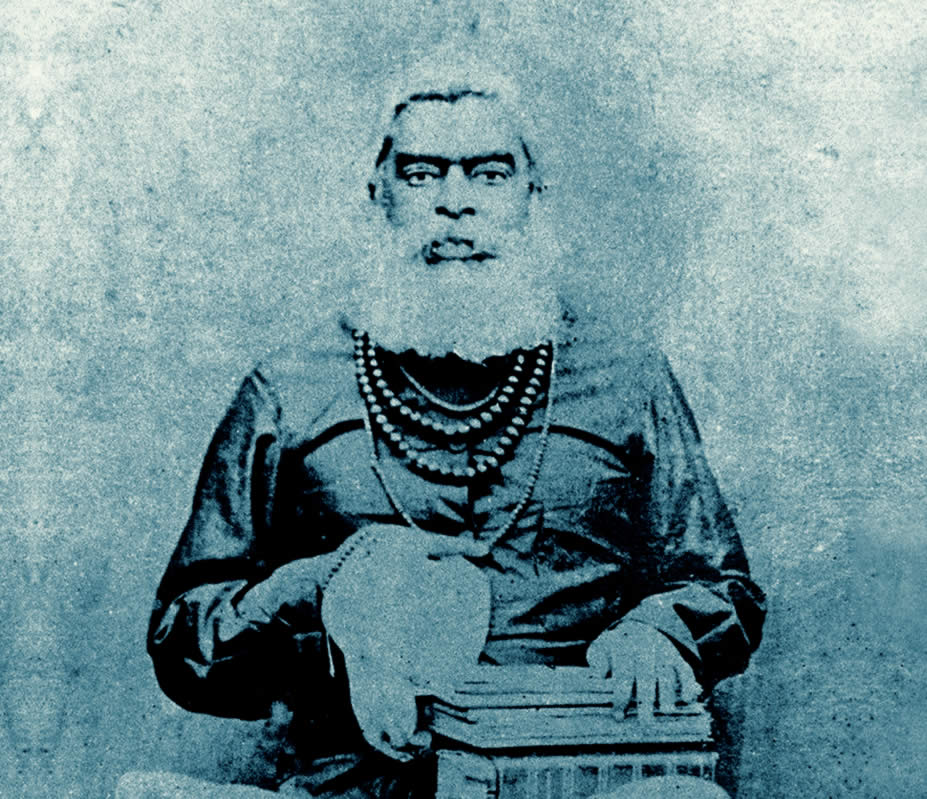
Srila Bhaktivinode Thakur
2.4.5 Importance of Candra :
Bhaktivinode and Vamanadeva
Bhaktivinode Thakura has his Moon in Makara in Śravaṇa nakshatra. Those who know Vedic Astrology realize that next to the Lagna, Candra is the most important element in the chart especially if the time of birth is unknown. This is confirmed by Parasara Muni:
The learned in astrology should base the effects on Candra also as are applicable to the ascendant. Brhat Parasara Hora Sastra 12.11.
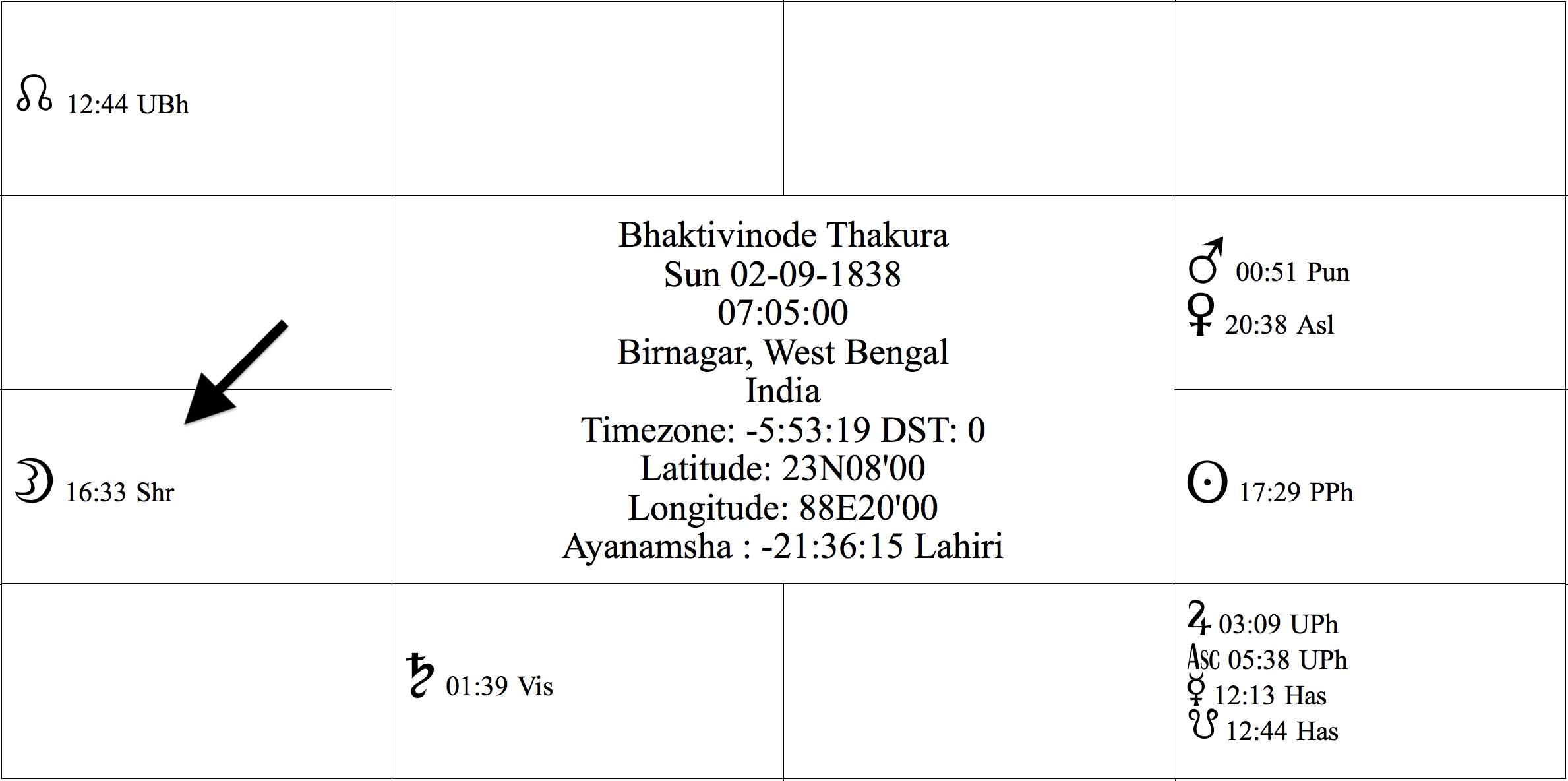
Then we also have Vamanadeva who appeared with Moon also in Śravaṇa Nakshatra (SB 8.18.5) which is in Makara. The list goes on.
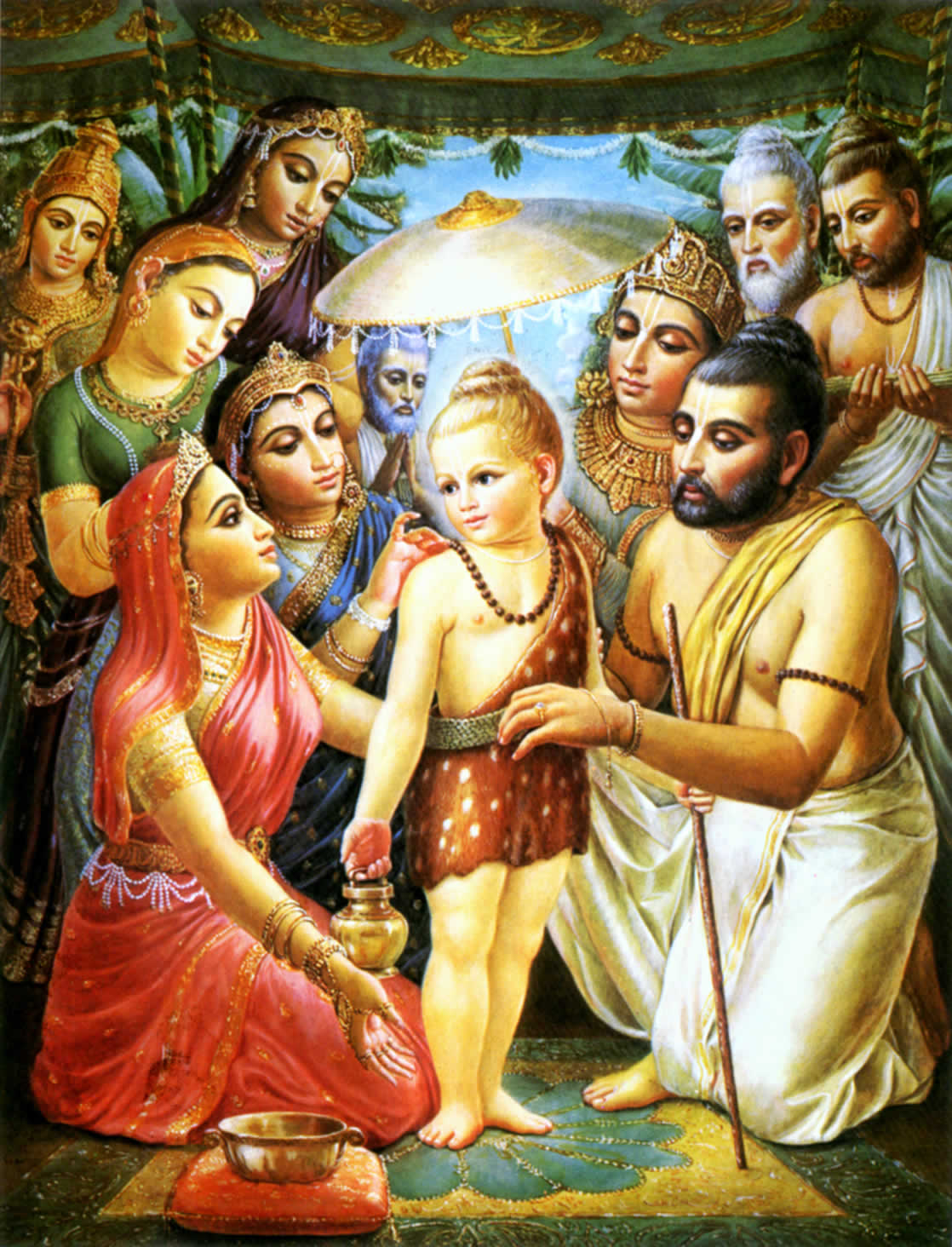
Sri Vamana Deva
According to the Sri Vaisnava Parampara24 there are several Alvars (incarnations of the paraphernalia of Lord Visnu) and leading acaryas in their line born with Moon in Makara. For example Poygai Alvar25 (incarnation of Pancajanya) was born with Candra in Sravana Nakshatra. This places Candra squarely in Makara. Pudatt Alvar (incarnation of Kaumadaki) was born the next day with Moon in Dhanishta. Dhanishta is half in Makara half in Kumbha, so there is a strong possibility that he also had Moon in Makara. The great saint Yamunacharya, author of the celebrated Stotraratna (much quoted by Srila Prabhupada) and guru of none less than Sri Ramanujacharya himself, was born on July 17, 916 AD at about 3:00 AM with Candra in Uttarashadha and fully in the sign of Makara. (Uttarashadha is one quarter in Dhanus three quarters in Makara but other details about his birth such as birth tithi make a Dhanus Moon astronomically impossible.) Vedanta Desika, the next most famous Sri Vaisnava Guru after the time of Ramanuja has also got Moon in Sravana which is fully in Makara.
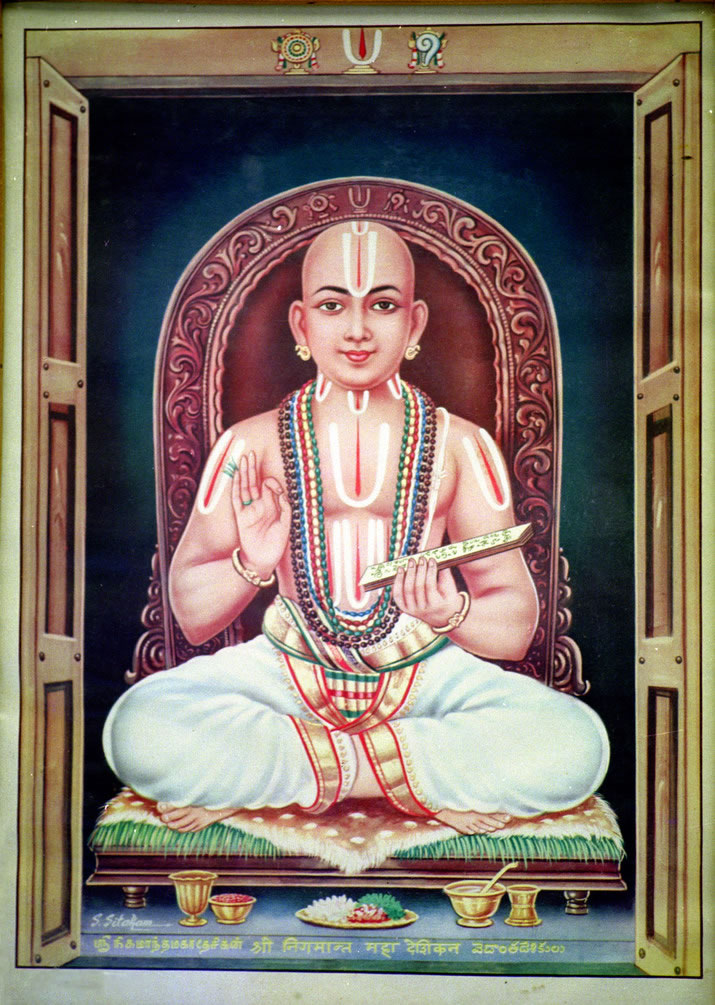
Vedanta Desika
In fact one of the most important members of our movement today [written in 1995], a dedicated disciple of Srila Prabhupada, staunch sannyasi for almost 20 years, GBC, Guru, leading book publisher, and preacher, etc. has Makara rising also. Not only that, but his Lagna lord and Sukra are conjoined together in the 8th house! In fact there are many distinguished devotees in our movement who have Makara Lagna. I have in my data base over 50 devotees, several of them leading preachers, with Makara rising and about the same number with Moon in Makara. Simply because Nalini feels that he manifests all the negative qualities of Makara (as stated on page three of his paper) is no reason to extrapolate that all Makara rising people will manifest those negative qualities. He should at least consider that some people may manifest the laudable, positive qualities of Makara as many of them do.
2.5 Guru in the 8th
Being an Asura Yoga
Before we examine this we should analyze the effects (positive and negative) of houses, look at what factors in a horoscope lead to a person taking to spiritual life, and probe the meaning of the 8th house in particular
2.5.1 Positive and Negative Effects on Houses
Just as we noted that every sign has a very positive and negative side to it, (with a whole spectrum of possible results in between) that an intelligent astrologer must be able to figure out. The same situation exists with all the other factors in a horoscope including the planets and the houses. Later we will discuss about the planets; now we will look into the houses.
Each of the twelve houses in a natal horoscope rules over a very large portfolio in a person’s life. Some of the portfolios overlap some are mutually exclusive. Some are shared with one or more planets, signs, nakshatras or vargas (like navamsa etc.). By this method a system of pointers and indicators is set up so that we can know which of the many possible faces a house is showing to us. Since a house has many items in its portfolio it is necessary to cross reference all the factors to understand the status of all the elements in its portfolio. In a particular house the results may be all good, bad, or a mixture of the two (misra-phala). This is why astrology is so difficult. And one should not be lead astray by simplistic, misleading presentations.
We have already seen a little bit from the discussion of the Lagna (whether it is Dhanus or Makara) that a sign can have many effects which are determined by the status of the planet that rules that sign, aspects to the sign (how other planets affect a planet or sign), etc. If all the factors related to the Lagna sign, its lord (ruler of the sign) and aspects to the sign are favorable then we can expect that the most favorable features of that sign will be displayed. If they are all negative then the bad side will be seen. And if the factors are mixed then the Lagna will display a mixture of features relating to that sign. Now the Lagna is the first house of twelve houses. The same principle is applicable to all the houses. The following is a very cursory exposition of the portfolios of each of the houses:
First House: self, head, body, personality, mental temperament, health.
Second house: eyes, face, upper part of the throat, speech, wealth, family.
Third House: arms, lower part of the throat, shoulders, brothers, sisters, valor.
Fourth House: chest, heart, mother, landed property, friends, conveyances, happiness.
Fifth House: stomach, education, intelligence, sons, daughters.
Sixth House: the region of the navel, illness, enemies, debts, distress.
Seventh House: partnership, sexual relations, spouse, the part of the body below the waist and down to the genitals.
Eighth House: genitals, anus, death, legacies.
Ninth House: hips, thighs, religion (dharma), devotion to God, prosperity, religious preceptor (guru), father.
Tenth House: knees, back, status and position in life, activity, honor from government.
Eleventh House: calves of legs, friends, income.
Twelfth House: expenditure, loss, sexual enjoyment, left eye, teeth, confinement.26
(It should be noted that the 12 houses of the horoscope are divided into four groups each representing one of the four purusarthas: The 1st, 5th, and 9th—Dharma. The 2nd, 6th, and 10th—Artha. The 3rd, 7th, and 11th—Kama. And, the 4th, 8th, and 12th—Mokṣa. This will be used later.)
Whole books can and have been written on the effects of just one house. To reiterate (and I will probably repeat this a few more times for emphasis) each house represents many things. Some houses represent mostly good things while others are considered bad. However the ultimate outcome of that house—good or bad—will be dependent on its disposition.
For example the fourth house is commonly called sukha-sthan, the place of happiness. This, however, is a little misleading if the student thinks that all planets in this house will give happiness. Certainly if the fourth house is well tenanted and aspected, and the lord of the house is similarly disposed, and the significator of the house, in this case for sukha being Candra, is also well disposed then we can say that the person experiences sukha—happiness. But if, on the contrary, this house is evilly tenanted or aspected, if the lord is debilitated or otherwise weak, and if Candra is similarly troubled, then rather than being sukha-sthan it becomes dukha-sthan the house of misery.
Similarly the sixth house is the place of enemies, illness, obstacles, debts—all manner of problems. This is certainly a scary house and if suitably situated all the negative can come to pass. But if the 6th lord is strong, well aspected, and the house tenanted by suitable planets then the person is free of disease, has no enemies or easily overcomes them, is free of obstacles, etc. The point being that while a house may relate to certain issues in life it doesn’t necessarily mean the positive or negative side of that issue. Whether it is positive or negative is determined by the condition of the house, its lord and significator.
2.5.2 Spiritual Factors in a Horoscope
The main houses that determine spiritual life in the chart are the 1st, 5th, 8th, 9th, and 12th; their lords, significators, and Candra . The lords of these 5 houses will be different for every chart, but the significators (karakas) for these houses are the Sun, Guru, Sani, Guru, and Sani-Ketu respectively.
Though the fourth house is classified as a “Moksha” house it doesn’t seem to have a prominent role in the discussion of spiritual life. Though we would assume that the 4th house should indicate happiness from spiritual sources, it also indicates a basic self-knowledge of our emotional make up and those of others which can be seen as precursors of spiritual life. It is definitely an important house but so far in my findings it doesn’t seem to have a crucial role like the 8th and 12th housess. It probably plays more of a role like the 5th and 9th houses which we will discuss now. We could also postulate that a person will not seek after spiritual life unless they become materially unhappy. But so far the 4th doesn’t stand out like the 12th or the 8th house. (In the intervening years since 1995 to this revision in 2019 I have had more examples of the 4th being the most important factor rather than 8th or 12th houses but they are rare.)
The first house and all related to it is important because this place, the Lagna, represents the person himself. It is important that this be well disposed to indicate a person of high caliber. Of course in Srila Prabhupada’s case the Lagna is Makara with Sani its lord exalted in the 10th. But we shall deal with this in detail later, when we discuss the tenth house.
The 5th and 9th houses are typically considered important because they are trinal and deal with purva-punya. And while the 9th house is considered the house of dharma, the 5th house, the 9th from the 9th is no less important.
Among other things the 5th has in its portfolio the following: yantras, mantras, mantra siddhi, devotion to God, kula-devata—family deity, religion, purva-punya, disciples, virtuous acts, going on pilgrimage, writing books, prabhutva—administrative ability, native intelligence, memory, discretion, good counsel, king and his ministers, depth of mind, sobriety, intensity or gravity, mystery, cheerfulness, contentment, and conception of children. But it also stands for: embrace of a prostitute, insanity, poor memory, low intelligence, stupidity, and atheism, etc. 27
You will notice that, as with the fourth and sixth house, the issues are basically the same but we are dealing with the positive and negative side of certain issues: intelligence—stupidity, good counsel—bad counsel, piety—impiety. Which side of the coin and to which degree it will come out is the task of the astrologer.
The 9th house, as Nalini has pointed out, is one of intense piety, good fortune, guru, dharma, devotion to God, higher learning, etc. But if ill situated just the opposite can manifest: atheism, uneducated, bad fortune, etc.
Another point to consider is that even if the 5th and the 9th are well disposed it may only show someone who is pious, or highly learned, etc. But this could be more in the line of religiosity and mundane learning such as that of a congregational church member or a Noble Laureate. Their are many pious people in this world, you meet them all the time. We could say that they are more influenced by Sattva. But what is it that separates a man who is a good, pious man and one who becomes a dedicated servant and devotee of the Lord? What indication in the chart would be the symptom of a devotee of Lord Krsna?
2.5.3 Eighth and Twelfth House
Crucial to Spiritual Life
The 6th, 8th and 12th houses are considered the worst houses in the chart. They are called Trik-sthan and Dushthana. Why is this? Because they typically represent the unpleasant topics of life. We have already noted the contents of the 6th house. We shall now discuss in detail the issues that the 8th and 12th houses bring to our attention. This discussion will be of great relevance to understanding the depth of Srila Prabhupada’s chart and his personality which it represents.
There is some controversy as to which is the worst between the 8th or the 12th. But we shall start with the 12th and this will lead us to the 8th. The 12th house, as many writers have pointed out, stands for:
On the negative side—Expenditure, financial loss, secret enemies, intrigue, secret liaisons with women, bad habits, wandering far from homeland (a great distress, especially in ancient times), misfortune, loss of luxury, loss of comforts of the bed (both sleep and sex), waste of wealth, loss of health, fall from height or position, going to naraka (hell) in next life, punishment, confinement, arrest, sins, being crippled, adultery, end of life, mental anguish and physical agony and distress, being cheated, social outcaste, ostracization, exiled, refugee, poverty, mental illness, backbiting, over-sensitivity, past bad karma, anger, greed, cruelty, humiliations, extravagance, etc. One would have to agree that these are very disagreeable issues which we would all like to avoid. For this reason the 12th is often called a house of self-destruction.
Yet in spite of this the 12th house is called Moksha-sthan, the house of spiritual emancipation. How do we determine whether the 12th is going to represent spiritual self-realization or self-destruction? This, as our line of reasoning continues, will depend on the status of the 12th house, its lord, and karaka (significator) Sani.
If these are well disposed and other positive factors are present in the chart revealing a person of higher understanding, then a different situation manifests. Some of the evils of the 12th may still manifest, but these will be but impetuses to push the person more and more into spiritual life. Typically they are immediately aware, without being told, that there is a God. They understand that the substrate of existence is consciousness. And because of this they are acutely aware of their own pain and suffering and that of others—they are naturally empathetic. They can see through the veneer of material life and see the ultimate painful uselessness of material society, friendship, and love and all that goes with it. They see absolutely no point at all to the goals and aspirations of “normal society.” Up to this point almost all these symptoms are shared with all persons who have the 12th house active in their charts. (By active, I mean by having the 12th occupied, aspected by its lord, or in some way there being sambandha (connection) between the 12th house and the Lagna.) Whether the person seeks out self-destruction or self-realization will be determined by such factors as favorable position of the 5th and 9th houses, their lords, etc., and also by positive aspects to the Lagna by benefic planets.
Whether the person seeks out self-destruction or self-realization will be determined by such factors as favorable position of the 5th and 9th houses, their lords, etc., and also by positive aspects to the Lagna by benefic planets.
If there are no positive aspects in the chart as mentioned above then the person sees no higher goal to life. But he continues to experience the pain of existence and considers the values of society as futile. Thus he becomes involved in escapism—substance abuse, alcohol, casual sex, fantasy, movies, fiction novels, TV, food, sleep, etc. Anything which, at least for the moment, distracts him from the pain of his existence. But unfortunately when the moment is over he is back to where he started except that it is now worse than before. Very serious cases can become delusional, catatonic, psychotic, etc. and be committed to insane asylums. Others can get on the wrong side of the law, since they don’t care about society, and spend time in jails as criminals or political prisoners.
If there is a positive aspect to the chart, then depending on how strong it is, the person may have to experience only a little of the negative side—a “dark night of the soul” or perhaps none at all. In any case they can somehow understand that there is a higher goal of life than society strives for and they aim their life in that direction. It is then that the positive aspects of the 12th house become manifest.
Positive traits of the 12th house: tremendous capacity for self-sacrifice, humble, devoted to God and saints, charitable, compassionate, empathy, deep understanding of psychology, control of wasteful expenditure, travels on pilgrimage, no fixed abode—all places are home, deeply introspective, meditative, fascinated by God, deep emotional strength, self-realization, residence in foreign lands, success away from his place of birth, very grave, likes his own company, very private, needs to be alone often, loves the solitude of remote places, powerful imagination, rich inner life, deep interest in ancient lore and history, reservoir of all kinds of secrets and secret (occult) knowledge, knowledge of past lives, able to reach deep within himself past the levels of ordinary consciousness, creative inspiration, extra-sensory awareness, psychic or mystic powers, transcendence; highest, idealized expression of love for Krsna and His creation; living in asrams, working behind the scenes, etc.
Depending on the evolution of the soul involved they will manifest these qualities in greater or lesser degrees. On the lower end they could be the kind of person who does volunteer work in the hospital or joins the peace corp. On the higher end you have dedicated devotees of God and Mahabhagavatas. The persons who have a positive manifestation of the 12th house fill the spectrum that Krsna explains in Bhagavad-gita 12.8-14.
Of the approximately 900 charts of devotees that I have on file (that was written in 1995 many more since then) I would say that a very large percent—80-90%—have a positively activated 12th house. It is a signature of a devotee, more than just a pious person, but someone ready to surrender and transcend.
2.5.4 The 8th House
Of the 10-20% of devotees who don’t have a positively activated 12th house I find that they have a positively activated 8th house. Some have both. I can’t think of any examples of any devotees who have neither 8th house or 12th house contacts in their charts but only 5th or 9th. The numbers are really overwhelming. Now let us examine why the 8th house, the worst house in the chart according to most astrologers, is associated with spirituality. As one astrologer put it: “The negative and positive implications of this house [the 8th] are major factors for determining the ultimate meaning of our lives.28”
The issues that the 8th house deals with are among the most unpleasant and troublesome in human experience. For example the 8th is commonly called Mrtyu-sthan—the house of death. That about says it right there, death being probably the most feared and unpleasant experience in material life. Let us briefly catalog (as with other houses) the litany of evils the 8th house represents.
Negative side of the 8th: cause and time of death, degeneration, incurring debts, lending money and losing it; diseases of genitals and anus such as piles, fistula, prolapsus and other diseases of the rectum; sexually transmitted diseases, sexual perversion; all kinds of physical and mental distress, pain, ailments, agony, etc.; break of partnership or friendship, defeat by diplomatic strategy; drugs, intoxication, prostitution, ruthless behavior, severe difficulties in crossing of oceans, mountainous regions or dense forest; weapons, major calamities; serious diseases like cancer, leprosy, AIDS, malaria, tuberculosis, etc.; very bad character, liar, Machiavellian manipulator, cheating, sexual profligacy and debauchery, going down the wrong path—literally and metaphorically, total destruction, ill repute, impediments, mutilation of limb, fear, battles, evil news, fear of or denial of death, morbid thoughts of death, fear of occult or superstitious, trouble from ghosts and black magic, murder, poisons, insanity, paranoia, etc.29
With this portfolio we can well see why the 8th house is feared if it manifests its negative side. But if we follow the line of reasoning that we have been pursuing, that a house has a positive as well as a negative side we shall soon see why spirituality is associated with the 8th house.
The positive side of the 8th house: ayuh-sthan the house of life, long life, regeneration, metamorphosis and transformation of self and others; deep, penetrating intelligence; sees through material facade, profound thinking, polymath of occult knowledge—remember that Krsna Consciousness is raja-vidya, raja-guhyam—the King of secret knowledge, sublimation of sexual energy and transcendence of material desire; sees through tricks and maneuvers of others; total self-control of body, mind, and senses; meditation, ability to focus the mind, deep stores of emotional energy to draw on, gravity, very deep and mysterious personality, deep policies with far-reaching consequences, researcher or inventor, detective-like qualities, distant travels, great adventures. Wealth gained through inheritance or legacy. The ability to “read between the lines.” Acceptance of death and an integration of its reality into daily life. Sense of immortality of one’s consciousness. Thinks of death often, sees death as a great teacher, prioritizes his life because always feels that death is near. Always goes to the heart of a matter, doesn’t beat around the bush. Many experiences outside the normal limits of personality. Ability to immediately bond with others on emotional, intellectual and spiritual levels. Knowledge of previous lives, etc. 30
After reading the terrain covered by the 8th and 12th house it is easily seen why they are demarked as belonging to the Moksha category. For it is only after one has conquered over the negative traits of these two houses and manifest their positive traits that spiritual realization is achieved. Now we shall return to our main points of discussion.
2.6 Is Guru in the
8th an Asura Yoga?
To recapitulate, Nalini Kanta has stated that:
“One chart had him with Capricorn rising, with exalted Saturn in the 10th and Jupiter in the 8th.” And, “Jupiter and Venus in the 8th creates an asura-yoga or a combination for a demonic personality.” In his paper he has referred to this many times. These are his reasons cited for Prabhupada’s not having a Makara Lagna.
Let us look at what standard texts say on the matter of Guru in the 8th.
Bhrgu Sutram says:
“[mostly concerned with longevity] . . . Jupiter joined by a malefic, the native will be sinful . . . if Jupiter is in own sign or exalted he will be long-lived, free from diseases a saintly person, learned and well versed in Vedas and Sastras.” [Italics mine.]
Brhat Jataka: “The native will be base.”
Phaladipika: “The native will be poor and will earn his livelihood by serving others. He will be long-lived but indulge in sinful deeds.”
Chamatkara Cintamani: “Not live at home for long. He keeps poor health. He will go to heaven after death.” [Italics mine.]
There are many other texts but they say basically the same thing. It generally doesn’t reflect good. This is because for the most part the explanations they give are very brief and to the point, as in the case of Brhat Jataka, without taking into consideration other factors. If they elaborate more we notice that if they take into consideration other factors, Guru then has the possibility of giving great benefit. Thus Bhrgu Sutram indicates that if Jupiter is strong in the 8th then: “he will be long-lived, free from diseases a saintly person, learned and well versed in Vedas and Sastras.” And Chamatkara Cintamani without conditions says: “He will go to heaven after death.”
So it doesn’t seem to be that the pandits were giving a blanket condemnation of Guru in the 8th as evil. Why the apparent contradictions between pandits and sages? The answer is that astrology is very complex. On the whole the issues related to the 8th are very serious indeed and thus the 8th is called a duhsthana or evil house, and Guru the supreme benefic if placed in the 8th will destroy his good qualities so Guru in the 8th is to be avoided. But there are exceptions.
When we look at the houses we have mentioned we see that they all have both a positive and negative expression. So this raises several questions: How is it possible to get the positive expression of the 8th house? Is Guru in the 8th evil for every rising sign or can he be good for some and bad for others? Also, is Guru always good in the 9th for every rising sign? Is it possible that in some cases Guru in the 9th can ruin the 9th? In the following section we shall examine the exceptions to the rules.
2.6.1 Viparita Raja Yoga
The problem with such blanket statements as “Jupiter in the 8th is an asura-yoga” is that they ignore the exceptions. In fact it is not so much an exception but rather a major principle in astrological synthesis of determining what part of the spectrum of results a planet, sign or house will give. This result is determined by carefully balancing several factors before reaching a decision. It is not that Guru in the 8th house will give the same identical result for each person who has this configuration. The result will vary considerably according to the following criteria:
- What sign is rising?
- Which sign rules the 8th house?
- Who is the ruling planet of the 8th house?
- What is the relationship between the planet who rules the 8th house and the planet who tenants it?
- Who is aspecting or conjoining the 8th house and its lord?
- What is the situation of the 8th house?
- Is the planet situated in the 8th weak or strong or somewhere in between by positional strength (sthana-bala), temporal strength (kala-bala), etc.?
- What is the situation of the karaka (significator) of the 8th?
- Are any special yogas (planetary combinations) formed?
- What houses does the planet who is tenanting the 8th own?
- What house is the 8th lord in?
In this case Nalini Kanta has ignored the concept of astrological yoga. In astrology certain combinations of planets either in combination of signs, houses, nakshatras, or planets will constitute a yoga which will give special results. It adds another dimension to astrology. One of the yogas is called Viparita Raja Yoga which I will now describe in detail.
As already mentioned the 8th house is considered to be quite evil, its portfolio mainly ruling over death, destruction and a host of miseries. There are other negative houses in the horoscope namely the 6th: sickness, enemies, obstacles, injuries, accidents, etc. And the 12th: loss, poverty, confusion, wandering aimlessly, self-destruction, insanity, imprisonment, etc.
Not only are the houses evil but so are the planets that rule the evil houses. Suppose down the street from where you lived was a saloon/brothel, doubtlessly an evil establishment. Do you doubt that the person who owned such a place would also be of immoral disposition?
Therefore wherever such evil planet goes he wreaks destruction. So what to do with the evil lords of the 6th, 8th, and 12th? The best place for them to be is to stay in one of these houses then they cause no harm but rather increase benefits. This is the idea of Viparita Raja Yoga. The formal definition is given in Uttara Kalamrita 4.22:
If any one of the following four Yogas takes place—(1) Lord of the 8th in the 12th or the 6th; (2) Lord of the 6th being placed in the 8th or the 12th; (3) Lord of the 12th being in the 6th or the 8th; (4) the said three lords being connected in any way, by mutual exchange, mutual aspect or conjunction and at the same time are free from such relation with other planets—the person born will become a great king lording over other kings and blessed with fame and wealth.
Satyacarya in his Jataka Satyacariyam31 confirms this stating:
If the lord of the 8th house is in the 6th, 8th or 12th, he will make the significations of these houses prosper . . .
There is, however, a rider on this rule and that is that there can be no other planets involved who are lords of good houses. Suppose for Mīna Lagna you have Sun, Guru and Sukra in the 12th. Then Surya (the Sun) as 6th lord, and Sukra as 8th conjoined in the 12th form Viparita Raja Yoga, but because Guru is there and he is the lord of the Lagna and the 10th, then this is not Viparita Raja Yoga but rather a very destructive yoga. In this case Guru is assailed by two bad planets while in a weak position.
So as long as there are no good lords in the combination then Viparita Raja Yoga can be said to exist. This Viparita Raja Yoga is a very favorable one and will give different results depending on the planets and houses involved.
Now let us revert to Srila Prabhupada’s chart. In his case he has Makara Lagna and in the 8th is Guru, Surya and Ketu. Guru is the lord of 12th and Surya as the lord of the 8th is in his own house, the 8th. Thus we have a perfect Viparita Raja Yoga. The lords of 8th and 12th conjoined together in the 8th. Not only that but Guru is able to aspect the 12th house from this position and make its spiritual significations strong.
Even without the Viparita Raja Yoga, Surya in the 8th is very powerful because it is a dictum of astrology that whenever a planet is posited in his own sign or aspects his own sign, that sign (and house which the sign rules) becomes very strong. So Surya is bound to give good results. But what of Guru as 12th lord in the 8th? Here is the opinion of several authorities. [Emphasis mine.]
Parasara Rsi states:
If the 12th lord is in the 8th, the native will always gain, will speak affably, will enjoy a medium span of life and be endowed with all good qualities. Brhat Parasara Hora Sastra 24.140
Satyacarya states:
If the lord of the 12th house is placed in the 8th, the native will experience happiness and unhappiness in almost equal amounts. Benefic combinations cause auspicious results to happen. [Such as planets in 5th and 9th as is found in Prabhupada’s chart.] If there is combination with the lord of the 6th house, the period will prove to be extremely auspicious and cause good results to happen. Also, the effects will be modified by the nature of the planets associated with the lord of the 12th house. Satyajatakam 4.12.8
Lomasa Rsi states:
When the lord of the 12th house occupies the 2nd or the 8th, the natives devotion to Lord Krsna will be immense. He will be endowed with all good qualities and will speak kindly. He will be charitably disposed. Sanketanidhi 6.98
Bhrgu Samhita Paddhati says the following about Guru as the 12th lord in the 8th in Simha:
. . .gets power by spending much money acquired in foreign countries; . . .gets the power of old and serious things helping the life career [mystic and occult knowledge, ancient lore, knowledge of past lives, metaphysics, philosophy, etc.] . . . spends the daily routine of life with great dignity and influence. Bhrgu Samhita Paddhati p. 567
B.V. Raman states:
The native will be rich and celebrated, will enjoy a luxurious life with many servants waiting on him. Gain through deaths and legacy is indicated. Interest in occult subjects and devoted to Lord Visnu, he will be righteous, famous and a gentle speaker being endowed with many good qualities of head and heart. How To Judge A Horoscope Vol. 2, pg 420.
2.6.2 Nalini’s Contradiction
On page 5 of his report Nalini says the following of Jupiter in the 8th house:
[Jupiter in] 8th house (if Makara is rising, also Chamatkara-Chintamani); ‘short lived, base acts, a devil, miser, friendless, gloomy, miserable, irrational, immodest, inert and lean, debauchee, wicked, slighted, etc.’
What is strange is that in Nalini Kanta’s own book, How To Read Your Horoscope page 196, he totally contradicts himself and says the following about Jupiter (as 12th lord for Makara rising) in the 8th house:
Lord of 12th [Jupiter] in 8th—Only good words are used in texts describing this position, like devotion to God, charitable heart, kind speech, etc . . .
As I said before I have the charts of many devotees who have Jupiter in the 8th house and they do not appear to me to be the way Nalini describes them to be. For example there is HH Bhakti-marga Swami, Advaita-Candra Dasa, Hari-sauri Prabhu, Hansarupa Dasa, Jagadishananda Prabhu (of NA BBT), Kusa Devi (wife of Sruta Kirti Dasa), and Yamuna Devi to name a few. None of them are “miserly, irrational, devils.”
2.6.3 Surya in Simha in the 8th
Aside from Guru the 12th lord in the 8th there is the placement of Surya in his own sign in the 8th. The Bhrgu Samhita Paddhati says the following about Surya in own sign in the 8th house:
. . . lives long; is very influential; gets great influence and advantage through the old and serious things helping the life career [mystic and occult knowledge, ancient lore, knowledge of past lives, metaphysics, philosophy, etc.];. . . possess a very strong power of secrecy and mystery; lives in a very dignified manner; doesn’t care at all about his future; . . . Bhrgu Samhita Paddhati p. 543
Though textual quotes cannot be taken literally without modification we see very strong indications that the combination of Surya and Guru in Simha, in the 8th, greatly enhance the spiritual significations that the 8th can manifest. This combination curbs the negative character traits associated with the 8th house leaving only the positive manifestation.
In any case we can see that when we look a little deeper we find that the real picture unveils itself. That actually in the case of Makara Lagna, to have Jupiter in the 8th house is not an Asura Yoga as Nalini Kanta would have us believe, but rather a Mahabhagavata Yoga as confirmed by all great authorities and even strangely enough by Nalini Kanta himself. Unfortunately he didn’t apply this to Prabhupada’s chart.
2.6.4 Ketu in the 8th
What of the fact that in Prabhupada’s chart it is not only Surya and Guru in the 8th but also Ketu?
Ketu like Rahu is a chaya graha—shadowy planet. Ketu doesn’t really rule any signs so he owns no houses thus he can not nullify the Yoga. But because he is a chaya graha he can act as a catalyst and make it more powerful and also act as a conduit such that the powers of Surya and Guru will act through him. Aside from this Ketu does add something to this yoga. Though he owns no houses Ketu does have a karakatva (signification), namely moksha-karaka. Ketu unlike Rahu has a very spiritual side to him and he is recognized as the significator of liberation (moksha-karaka). And though the 8th has a generally bad reputation, on the good side (or when the bad side is destroyed) it is the house of mysteries, regeneration, occult knowledge, old and secret things that help in life, purification, devotion to God, control of the senses, mystic siddhis, revolution, knowledge of past and future births, etc.
So with Surya placed in his own sign in the 8th house all these positive factors become strong. Guru conjoined Surya makes it even more powerful for two reasons:
1 Because as we have already mentioned the 8th house becomes purified of negativity leaving strong spiritual and mystic tendency and,
2 From the 8th Guru aspects the 12th house which he owns and makes it very strong.
As we have already shown the 12th and the 8th are essential for true spiritual accomplishments and thus Guru in the 8th activates both. By adding Ketu it makes for a person who is completely from some other realm, detached from material existence. Ketu thus further emphasizes Srila Prabhupada’s spiritual nature. This yoga in the 8th house actually reveals that we will never really understand Prabhupada’s true identity. He appeared like an ordinary man, but that was a facade. He is inscrutable. He is a siddha, a perfected soul. His plans were very deep and far-reaching. Because of our nearness it is difficult for us to appreciate what he has done or to what extent he has changed the course of history. We are living at a very historical moment, people will, in the future look back on Srila Prabhupada much as they do now on Mohammed, Christ or Buddha except that Prabhupada’s contribution will be far greater.
2.6.5 Is Guru Always Good in the 9th?
Before we leave this section we should note that while Nalini traduced Guru in the 8th he also made the blanket statement that Guru in the 9th is all good. Is this always true? Can there be Lagnas for which Guru in the 9th is not good but even downright evil?
Yes, for Vrshabha Lagna, Guru in the 9th, without mitigation, is very bad and destroys all the significations of the house. The reasons are two fold:
First of all Guru becomes a functional malefic because he owns the negative 8th house.
Secondly when Guru is in the 9th from Vrshabha he is in Makara, his sign of debilitation where he loses his power to do good.
. . .heavy loss in destiny and dharma; gets weakness of longevity; gets the loss of old and serious things which help the life career, injures dharma to gain wealth, gets weak income, little belief in God,. . . Bhrgu Sangita Paddhati p. 89.
I also have charts of persons with Guru in the 9th who are not much interested in spiritual life. And others such as Bhagavan Prabhu who have had some very serious setbacks in their spiritual life. Thus we again find that in the multi-faceted world of real astrology Guru is not always good in the 9th house, nor is he always bad in the 8th.
2.7 Is the Lagna Lord in
the 10th House Bad?
Now we shall take up the cudgel against Nalini’s objection that Srila Prabhupada couldn’t have Makara Lagna because then Saturn: “the ascendant lord exalted in the tenth house [is in] (the house of artha or economic development).” Implying that this would make Prabhupada like a karmi.
Nalini Kanta’s argument, in this case, hinges on the 10th house being, “the house of artha or economic development.” Is this the actual case?
As we mentioned before the 12 houses of the chart are divided up equally between the purusarthas—dharma, artha, kama, and moksa. Thus:
- The dharma houses are 1, 5, 9.
- The artha houses are 2, 6, 10.
- The kama houses are 3, 7, 11.
- And the moksa houses are 4, 8, 12.
The first comment we might make is that if Nalini insists that the 10th is an artha house then he should have no trouble accepting the 8th as a house of moksa. And, thus not complain about Guru being posited there. As we have shown, in Prabhupada’s case Guru in the 8th is a part of Viparita Raja Yoga and raises the quality of the chart several quanta. It is a Maha-Bhagavata-yoga.
Aside from this to simply designate the 10th as a house of artha is to miss the point of the 10th house. Each house has in its portfolio a wide variety of items and we shall soon delve into what the sastras say about the 10th house but before that let me give a bit of deeper analysis.
The 4th house in a natal chart represents the mind of the individual. It is the house of sukha-dukha, happiness and distress. What ever is conceived in the mind of the individual, if it is to manifest, must be acted upon. The house representing this action is the 10th. The 10th ultimately represents karma, in the sense of how a person will accomplish an action—by noble or base methods, to what extent they will be successful in their actions, will their actions bring them fame or infamy, etc. An epiphenomenon of this will refer to a person’s vocation or career, what they “do” in life. Even saints and sadhus have a profession or career—they are preachers and servants of God. So to relegate the 10th to artha is to misunderstand the fundamental basis of the meaning of this house. Now let us look at what ancient sages have said about the signification or karakatva of the 10th. [Emphasis mine.]
Parasara Muni: “Royalty (authority, the power to command), place, profession (livelihood), honor, father, living in foreign lands and debts are to understood from the 10th house.” Parasara Hora Sastra 11.11
Bhrgu Samhita Paddhati: “Government and society, big occupation, attaining a high position, splendor, sovereignty.” p.8
Suka Nadi says (as told to me by the owner of Suka Nadi): “. . .temple building capacity. . .”
Pandit Ojha32 has given a synopsis of the views of several ancient astrologers about the 10th .
Vaidyanatha: (In addition to matters already stated) “the natives actions or activities, ornaments, sleep, agriculture, renunciation of worldly life and taking to asceticism, means of livelihood.”
Ramadayalu in Sanketanidhi: “The backbone, trade and commerce, seal of authority, position, etc.”
Prasna Marga: “Temples, the city; municipal, legislative or administrative council, rest houses where free lodging and boardings used to be provided (Dharmasalas), slaves, all activity, authority, and support.”
Uttarakalamrta: “Trade, depositing of a treasure, riding a horse [fancy vehicles], road or track for a journey, athletics, teaching, supremacy, fame, elders, talismans, and adopted son.”
And, Ramakrishna Bhat 33 opines:
. . .kingly duty, [or] servitude, fame, performance of sacrifices, mystic yantra, mantra, mantra siddhi, self-respect, honorable living, education,. . .” Fundamentals of Astrology
We can see from the evidence culled from respectable sources that the 10th is hardly just “the house of artha or economic development.” We see “renunciation of worldly life and taking to asceticism”, “performance of sacrifices, mystic yantra, mantra, mantra siddhi” and “teaching” among many other things.
All authorities agree that the 10th is the house of Royalty and command as Parasara Muni stated: “Royalty (authority, the power to command). . .” This is confirmed by Srila Prabhupada who said:
Prabhupada: So when I met Bhaktisiddhanta Sarasvati Thakura . . . It is a long story, how I met him. One of my friends, he dragged me. (laughing) (laughter) I was at that time nationalist and manager in a big chemical factory. My age was about twenty-four years. So one of my friends, he asked me that ‘There is a nice sadhu, Bhaktisiddhanta Sarasvati Thakura. He has come in Calcutta. So let us go and see.’ So I was reluctant. I thought just like so, there are so many sadhus. So I was not very much . . . Because I had very bad experience, not very good. So I said, ‘Oh these kind of sadhus, there are many.’ You’ll be glad to know that even my in young age or early age—it was Krsna’s grace—even amongst my young friends, I was considered the leader. (laughing) (laughter) In my school days, in my college days, in my private friendship, some way or other I became their leader. And one astrologer sometimes he read my hand. He said in Hindi, kukum calena. (?) Kukum calena means “Your hand speaks that your order will be executed.”
Devotees: Jaya!
Prabhupada: So anyway, it was Krsna’s grace. I would not go, but their point of view was that unless I certify that sadhu, Bhaktisiddhanta Sarasvati Thakura, he’ll not be accepted. Therefore he dragged me. So I went to see Bhaktisiddhanta Sarasvati Thakura on that day.
Srila Bhaktisiddhanta’s Disappearance Day, Los Angeles, December 13, 1973
In Prabhupada’s chart he has his Lagna lord Sani in deep exaltation in the 10th house. And we can’t forget the lord of the 10th house Sukra, who is conjoined exalted Budha the lord of the 9th in the 9th. What does it mean? Well considering what we learned about the chart so far in regards to the 8th house we will have to keep that in mind when we look at the rest of the chart.
For Makara rising Sani in the 10th in Tula means that the 1st and 2nd lord is very powerful in the 10th and indicates that, regardless of any other consideration, the person: Will rise to a very prominent position, will become very famous, he will be an expert organizer and manager, he will do many things for the upliftment of society, he will be a visionary with large-scale plans, he will be very expert in dealing with people, will be wealthy and expert in handling money, highly educated, knowledge of ancient sastras, speaks convincingly and powerfully, be very self-reliant, keenly developed sense of justice, equal to all, equipoised, full of grace and culture. Also Sani in this placement causes Sasa Mahapurusa Yoga indicating a very great person. Aside from this, Sani in Tula, as the Lagna lord, indicates that he will be very graceful, dignified and swan-like, he will have an attractive personality and features [photos from his youth indicate that Srila Prabhupada was a handsome man].
I don’t think that anyone can doubt that, though Srila Prabhupada was a businessman in his purva ashrama, he didn’t attain the height of success until he answered his true calling, that of a preacher for Caitanya Mahaprabhu. His creating and managing ISKCON and turning it into a worldwide mission are all understandable for a Makara Lagna person who has Sani in the 10th. It is clear that the 8th house placement of planets indicates that Srila Prabhupada is a true devotee and that is going to influence in what direction he acts. The placement of the Lagna lord Sani in deep exaltation in the 10th indicates the magnitude and quality of that action. In Prabhupada’s case it makes him the Emperor of devotees. One who has accomplished unimaginable things, is great in many ways, aristocratic, etc.
What of Sukra, the 10th lord in the 9th? As we mentioned the 10th is for action. Sani in the 10th indicate that he will work very hard himself. But Sukra as 10th lord also gives an indication of what the direction of action will be. (Of course we should also keep in mind that the 8th indicates Bhakti-yoga in his chart, this also indicates the direction of his actions.) Since Sukra is the Yoga Karaka planet for Makara his placement is vital. Yoga Karaka means the planet that can do most good for a particular Lagna. For Makara and Kumba that planet is Sukra because he simultaneously owns a kendra and kona house, i.e. for Makara he rules the 5th and 10th both very good houses, thus he carries no blemish and can only do good not evil.
Though Sukra is nica (debilitated) in Kanya this blemish is canceled thrice by three nica-bhanga yogas: Guru in the 4th from Moon, Budha conjoined Sukra, and the Sukra's navamsa lord exalted in the 10th. For details see section 1.6. (Though it probably contributed to his having an un-cooperative wife.)
According to Raman:
“Lord of the 10th in the 9th makes the native a spiritual stalwart. He will be a beacon to spiritual seekers if Guru aspects the 10th lord. He follows the profession of a preacher, teacher or healer. The father of the native has a great influence over him. He will be a dutiful son and do many charitable deeds.”
Though in Prabhupada’s chart Guru doesn’t aspect Sukra, Guru’s place can safely be replaced by exalted Budha lord of the 9th in the 9th with Sukra. This is because the function of Guru and the 9th house lord is the same.
In any case I think that it should be clear by now that to claim that having Sani exalted in the 10th makes a person a materialist interested only in economic development is a very shallow and wrong understanding of the situation. One must look a little deeper to see the true picture.
2.8 Guru-Good; Sani-Bad
In another over-simplification Nalini has characterized Guru as all good and Sani as the opposite. This is a lop-sided argument that doesn’t present the real facts. Both planets represent a whole spectrum of results depending on the status of the planet in the chart. Nalini has gone to great lengths to paint the qualities of Guru in glowing colors as if this were always the case. While I am not denying that Guru is the supreme natural benefic planet with many laudable qualities it doesn’t mean that Guru will always display these qualities in everyone’s chart.
When Guru is ill disposed it represents—over-extension, unregulated growth, cancer (explosion of cell growth), over-optimism, pomposity, pretense, denial of negative realities, religious bigotry or hypocrisy, guru-complex, great pride due to scholarship, being full of one’s self, crude humor, bombast, etc. If really badly situated it could indicate outright atheism or mayavadi and Buddhist tendency.
Another point to consider is that Nalini gives so much prominence to Guru controlling Prabhupada’s chart that he forgets that such a dominance of Guru often leads to the person becoming very corpulent for Guru rules fat. In fact one of the passages quoted by Nalini states: “. . big bellied body. . . ”(page 4) Hardly a description of Prabhupada.
I should like to say that for a Dhanus Lagna, Guru in the 9th is a very good position and in fact in many ways the Dhanus chart is a powerful one. However according to the time Prabhupada gave us he has a Makara Lagna not Dhanus and as we have seen so far the Makara Lagna chart is not the chart of a demonic karmi as Nalini has made it out to be. There are many other reasons why Dhanus Lagna could not be Prabhupada’s chart as we shall point out in different places (see chapter on analysis of the Dhanus rising chart), especially when it comes to timing Prabhupada’s life.
Nalini says of Sani, who rules Prabhupada’s chart (if we go along with the time given to us by Prabhupada):
On the other hand, look at the description of the planet Saturn, which certainly has some good qualities as well, but is generally entrusted to giving the embodied souls suffering: ‘Saturn is cruel, with a thin long body, hard nails, big-sized teeth, is tamasic in nature, prominent veins, is curt in speech and is despicable.’ (page 4)
As you probably have already guessed Nalini has (again) not told us the whole story. The above description of Sani is true if Sani is weak. But if Sani is strong, as he undoubtedly is by being in his exaltation sign of Tula in Prabhupada’s chart, then we get a very different picture:
If Saturn be strong the native would be sober, deep, sagacious, fond of mystic and occult sciences, philosophy, etc.34
And for Sani in Tula
Endearing speech; intelligent; occupies a senior position among groups of people and respected in the village or town he resides in; very rich—equal to a king; earns money and respect by touring or contacts with foreign countries; can bank upon hoarded money; rises as life advances; . . .35
And for Sani in the 10th (as in Prabhupada’s chart):
. . .The native has much knowledge of sastras, he is learned; brave and famous. He is wealthy and occupies a high position in life. He is the head of an institution or at the helm of affairs of his sphere of activity. This is not a good location for happiness from mother, but good for father unless Saturn rules the 8th house. The person generally lives at a place other than his homeland.36
And, we must consider that the placement of Lagna Lord, in this case Sani, in the sign of Tula ruled by Sukra, the planet of beauty, will give the qualities of Tula such as charm, and handsome features. Srila Prabhupada as a young man was quite handsome.
By putting these factors together—strong Sani in Tula in the 10th house—and Nalini Kanta’s argument evaporates.
We should also like to point out that while Guru is very important planet in regards to spiritual life so is Sani. We have already noted that 5th and 9th house have Guru as the karaka while the 8th and 12th have Sani, and these later two houses are essential for spiritual life. Varaha Mihira in his chapter on Parivraja Yoga (combinations for Sannyasa) has stressed on Sani being the dominant planet because a strong Sani gives philosophical outlook, detachment, and tapasya. Here is what Varaha Mihira says:
2.8.1 Parameters of Parivraja Yoga
In Brhat Jataka chapter 15, probably the shortest chapter, only four verses, he gives the essence of Parivraja Yoga.
1-Four or more powerful planets should reside in one house. The nature of the Parivraja Yoga will be determined by the nature of the strongest planet involved in the Yoga. That is, to what sect the man will be is supposedly determined by the planet involved. [But this could also be interpreted in the case of Vaisnavas as which avatara the sannyasi is most attached to.] If the yoga causing planets are defeated in planetary war he will fall from sannyasa.
2-If the planets involved in Parivraja Yoga are combust by Surya (too close to the burning rays of Surya and thus obscured) then the person will not take Sannyasa but greatly worship Sannyasis instead. If the yogakaraka of the Parivraja Yoga and other defeated planets are aspected by other planets he makes application for taking sannyasa but doesn’t become one.
3-This is a bit of a round about combination. Consider the lord of the sign Candra is in. Call this planet X. X should not be aspected by any planets. X should aspect Saturn. Or if X is weak and aspected by Saturn. Or if Candra is in the Drekkana of Saturn and occupies the navamsa of Saturn or Kuja and is aspected by Saturn. Then the person gets Sannyasa Diksha. (However we should still consider combustion and Graha-yuddha as mentioned in previous verses.)
4-If Guru, Candra and ascendant lord are aspected by Saturn. And Saturn occupies the 9th unaspected by any planet he gets Sannyasa diksha.
Of these four combinations two have a heavy involvement of Sani. These are only some combinations indicating Sannyasa. Sani is a major player for Sannyasa and gives vairagya-detachment and tapasya-austerity. Sani should positively aspect Candra thus cooling the emotions and giving emotional detachment. Sani aspecting the Lagna gives self-control and discipline. Sani associated with Guru hones the philosophical insights.
One can not just apply some formula but must look at the chart after a lot of experience with astrology. There are many subtleties and intuition is involved. In other words you should not just jump into doing sannyasa charts especially when it is such a serious thing with great spiritual and social ramifications.
The main point is that while Sani is often portrayed as a villain in astrology it is only one side of the coin. He has another side to him which has been ignored by Nalini especially the role that Sani plays in Prabhupada’s Makara Lagna chart. The fact is that no one can ever make it to the top in any field, material or spiritual, without the blessings of Sani.
2.8.2 Srila Bhaktisiddhanta Saraswati Thakura’s
Chart Ruled by Sani
On page four of his report Nalini Kanta Prabhu makes the following statement “Gemini was rising, the rising sign of Srila Bhaktisiddhanta Saraswati Prabhupada’s chart.”
By making this statement Nalini Kanta has contradicted himself and totally nullified his whole presentation. Why is that? The answer will become obvious if we briefly examine His Divine Grace’s chart.
His Divine Grace 1008 Srila Bhaktisiddhanta Sarasvati Thakura was born Feb 6, 1874 at 3:30 PM, LMT, at Puri, with 23° 31' Mithuna rising on the ascendant.
Update 2019. We supplied a detailed reading of Bhaktisiddhanta’s horoscope to His Holiness Bhakti Vikasa Swami who published it in Sri Bhaktisiddhanta Vaibhava volume 3, which was published in 2009. For the purpose of that reading we slightly adjusted the birth time by two minutes, to 3:28 PM, so that it would more accurately represent him.
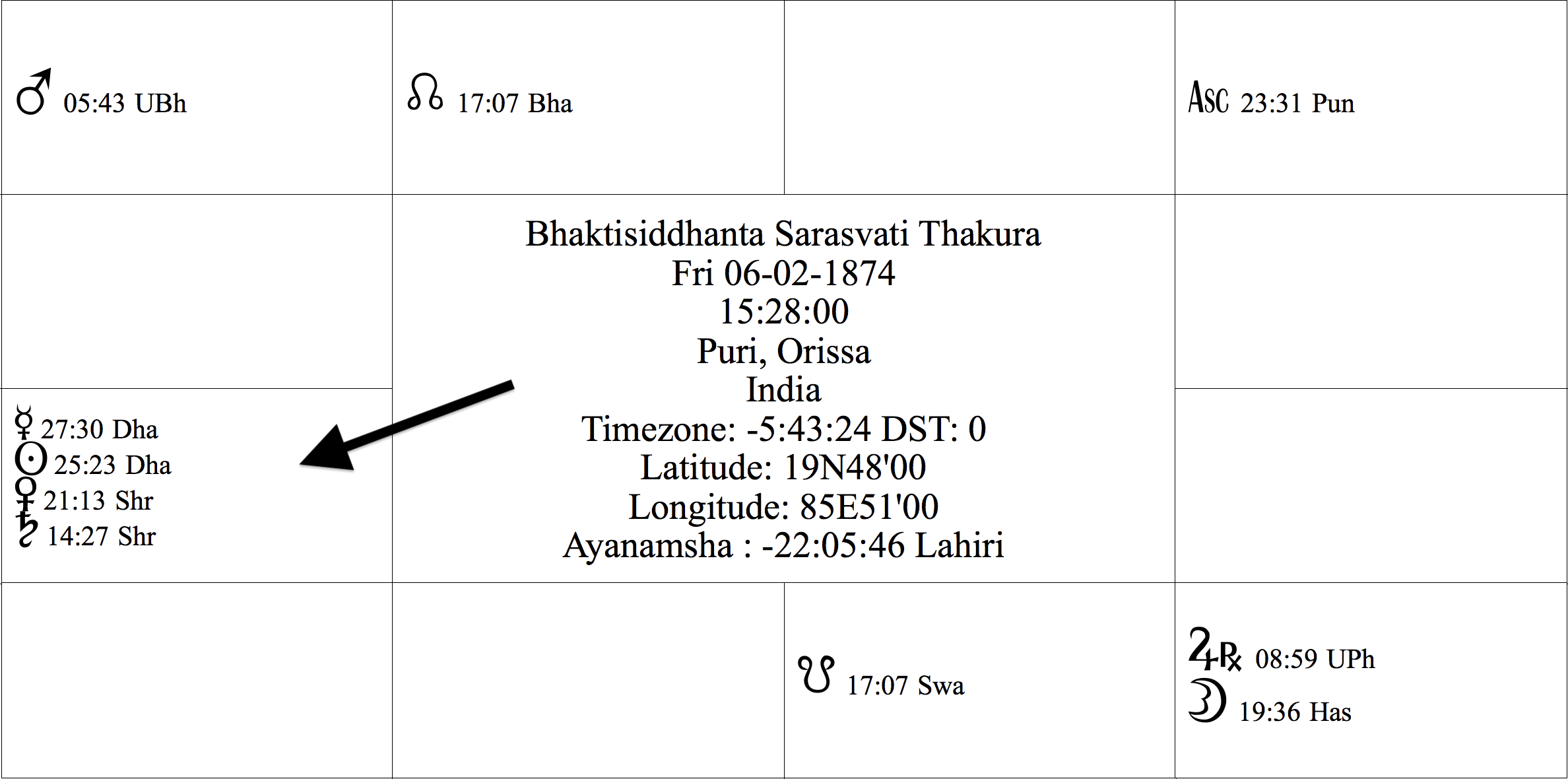
In this chart we see that there are four planets conjoined in one house. Namely Surya, Sukra, Budha, and Sani are conjoined in Makara. Please note this important fact.
This poses an insurmountable problem to Nalini Kanta’s thesis. Why is that? In any horoscope, no matter what the rising sign, any sign that has three or more planets will have a tremendous impact on the psycho-physical nature of the person. In this case there are four planets in the sign of Makara, the sign that Nalini deprecates.
Now these four planets stay in Makara no matter what the rising sign was on that day, or for several days after that. But Nalini Kanta agrees that Bhaktisiddhanta Saraswati Thakura has a Mithuna rising. The inescapable implication of this is that since Makara is 8 signs from Mithuna that means that Nalini Kanta Prabhu has given Bhakti Siddhanta Saraswati a chart in which he has 4 planets in Makara in the 8th house (one more than Srila Prabhupada has with a Makara rising chart). And we note how much Nalini Kanta loathes both Makara and the 8th house. We also note that Bhaktisiddhanta Saraswati’s chart ruler for Mithuna becomes Budha and he (Budha) is placed in Makara in the 8th.
In Bhaktisiddhanta’s chart he has four planets in Makara. Does this mean that he is low class? He has a total of six out of ten significators in Earth signs, which by the definition of Nalini Kanta definitely puts him in the Sudra category. This doesn’t quite sound like Bhaktisiddhanta. (Srila Prabhupada, even if you ignore his ascendant, still has four planets out of ten significators in earth signs!) Not only that, but Sani who in varna classification represents sudras, is the main significator for sannyasa. Astrology is complicated and it requires discrimination and training to know when to apply different rules to various situations.
Nalini cannot have it both ways. He can’t claim that Makara is a “low class sudra sign” and thus we can’t have Prabhupada born with it rising; yet it is the predominant sign in Bhakti Siddhanta’s chart (and Bhaktivinode Thakura as well). If he complained about Prabhupada having his ascendant lord exalted in the 10th because he said that the 10th was the house of artha—economic development, how then will he approve of Prabhupada’s guru having his ascendant lord in the 8th (“asura-yoga”) with three other planets, and all in that “sudra sign” of Makara?
2.9 Other Astrologer’s Charts
2.9.1 Arkasomayaji
Nalini Kanta Prabhu, and those who follow him, substantiate their belief that Srila Prabhupada had a Dhanus Lagna because one astrologer, named Arkasomayaji, calculated a chart for Srila Prabhupada with a Dhanus Lagna. This astrologer is said to have pronounced Srila Prabhupada to be an “Avatara-purusa, Jivanmukta, etc,” on the basis of this Dhanus chart. And since Srila Prabhupada is a great soul, a siddha, ergo he must have Dhanus ascendant. Nalini Kanta writes:
I read those five charts that were given to Prabhupada. One chart from a South Indian Astrologer [Arkasomayaji] said that Prabhupada was under 29 degrees Sagittarius [rising], as stated in my book, and that Prabhupada was a Shaktyavesa Avatara, an incarnation of the mercy of the Lord [he didn’t exactly say that, see Arkasomayaji’s letter page 1 and page 2 for what he actually said, or download it as a pdf.] who can deliver the whole world. Why has Shyamasundara rejected that fellow’s opinion and accepted Ojha’s [chart with Makara ascendant], which says nothing special about His Divine Grace? (From a letter to Hrishikesananda March 26, 1995 and posted on the GBC, Prabhupada Centennial, and other forums as text 105820.)
I do not know Arkasomayaji or his astrological abilities, he may or may not be a good astrologer. He seems to be a gentleman from a pious mayavada brahmana family. In any case he well knew Srila Prabhupada’s reputation and that only a person of exceptional spiritual magnitude could do such deeds. Naturally one wants to praise great souls and he took this opportunity to do so. However while Akrasomayaji makes very nice comments which we can all appreciate as true, Nalini has jumped to the conclusion that simply because the astrologer praised Srila Prabhupada then it follows that the chart must be correct. His criteria is—he who praises the most must be the best. Nalini asks “Why has Shyamasundara rejected that fellow’s opinion?” My reasons for rejecting Arkasomayaji’s calculation are as follows:
1- Though he was given the correct birth data, for he writes in the chart “1-9-1896 at 4 pm at Calcutta,” he makes the wrong calculation of the horoscope based on this information he writes “Lagnam=8-29-14 verging on Makara.” 8-29-14 means 8 signs passed, and 29 degrees, 14 minutes of the next sign, namely Dhanus 29° 14'. However it is mathematically impossible to get Dhanus for the birth time given. To get Dhanus you have to change the birth time by 30 minutes like Nalini Kanta did. At 4 PM the 7th degree of Makara rises.
2- Then he predicts in his letter to Surabhi Swami, dated August 18, 1977, that Srila Prabhupada will easily recover from this illness and live till 1984. He predicts:
The present illness should be interpreted only as a sort of exhaustion after a strenuous over-work both of body and mind. And
I see clearly and assert that the native shall be able to overcome this illness, by his strength of spirituality and shall have the opportunity of fulfilling his spiritual errand living up to 19-1-1984, i.e. the beginning of Sukra-Kuja, who are marakas [death inflicting].
So Swamiji [Surabhi], we have nothing to worry regarding the health of His Divine Grace, who has taken this mortal coil only for a Divine mission.
Since he purposely ignored the birth data provided him and chose Dhanus ascendant, is it a surprise that when he made a prediction based on the wrong data that he should make such a glaring mistake?
Unfortunately he was wrong and Srila Prabhupada departed on Nov 14, 1977, six years before Arkasomayaji predicted. It is one thing to make a statement about what is already known—that Srila Prabhupada is a mahatma and mahajana. It is another to be able to accurately predict on the basis of the horoscope. Since he purposely ignored the birth data provided him and chose Dhanus ascendant, is it a surprise that when he made a prediction based on the wrong data that he should make such a glaring mistake? He was specifically asked if Srila Prabhupada, who was gravely ill, would live, and he said there would be no problem and that Prabhupada would live at least to 1984. This is a serious mistake. Therefore we must assume that he was using an incorrect horoscope.
Update 2019
We are lead to believe by Nalini Kanta Prabhu that Arkasomayaji was a specially gifted astrologer and we should just follow him because he praised Srila Prabhupada. But Nalini Kanta Prabhu is only following Patita Pavana Prabhu who actually first contacted Arkasomayaji and eulogizes him as a great scholar who very much appreciated Srila Prabhupada and saw amazing things in Prabhupada’s horoscope and wrote a laudatory horoscope as well as glowing reviews of Prabhupada’s books. Thus it seems the astrologer who praises the most is the best. And, we then surmise that the appreciation was mutual though not directly stated, a further reason for accepting the chart drawn by Arkasomayaji. But what are the facts? To find out we must consult room conversations for April 20th and 30th, 1977 in Juhu.
As described in a April 20, 1977 Room conversation, Patita Pavana Prabhu aka Patita Uddharana was traveling in South India and meeting various scholars. Srila Prabhupada was very interested in finding some academically qualified person with traditional learning who can understand the 5th canto description of the universe. Prabhupada specifically says that:
Yes. One who can understand that description in the Fifth Canto rightly, it is... There is no question of whether he's spiritually advanced or not. It is simply academic qualification.
Patita Pavana Prabhu tells Srila Prabhupada that he met two such men who were vastly learned and who could help in understanding the meaning of the 5th canto. Their names were Dr. Arkasomayaji and Agnihotram Ramanuja Tattvacarya. Prabhupada asks if they actually understand the 5th canto:
Prabhupada: To get the... Yes. That is another advantage. If it is possible, do. So they can understand the description in the Srimad-Bhagavatam?
Patita-pavana: They have assured me they can.
Srila Prabhupada is thus very eager to have them come at once and no expense is spared and arrangements are made to fly them to Mumbai and comfortable places are arranged for their residence. Read the whole conversation here (pdf) and, listen to it here (right click to download).
Then on April 30th, 1977, Agnihotram Ramanuja Tattvacarya came to Juhu and met with Srila Prabhupada. But when Srila Prabhupada asked him a few simple questions it became evident that the man had only some vague idea about the 5th canto description of the universe. Srila Prabhupada was not very happy and the following discussion took place when the man left the room.
Tamala Krsna: Phew! This boy, Patita Uddharana, has spoiled thousands of rupees for months. He has no knowledge or intelligence, and he's going around and thinking that this man is the foremost... [In 1977 US$1 = 8 Rupees]
Prabhupada: Useless.
Tamala Krsna: To fly him from Madras [Chennai] to here and back is twelve hundred
rupees, and Patita has been traveling for months all over India. Who knows
how much they have spent on him? And he doesn't have the intelligence to
ask the questions which Your Divine Grace just asked. Otherwise he could
have known from the beginning that the man doesn't know a thing.
Prabhupada: He cannot, cannot explain.
Tamala Krsna: This man will not be able to. I mean, the things you were
saying, Srila Prabhupada, he was thinking... When you started to describe
them, he was thinking it had to do with the individual soul. He said that
“You're desc...” You said, “No, I'm talking about the universe.” He said, “Oh, the universe.”
Prabhupada: He does not know anything. Now he goes away. He goes back and
he... Why he has come?
Tamala Krsna: For your blessings. Twelve-hundred-rupee blessing. There are
learned men in India, there's no doubt. There must be learned men.
Prabhupada: All bogus.
…
Tamala Krsna: He says, “We never thought to read Bhagavatam as you are now
talking. We have not read like this yet, so I will have to begin to read it again
as...” I mean, what... I'm only wondering what kind of talk Patita Uddharana
must have had with him that he felt that this man was qualified.
Prabhupada: So how he'll make diagram? He has no idea.
Tamala Krsna: No, he doesn't. He never thought about it. No one reads the Bhagavatam as a scientific book, Srila Prabhupada. That's the point. Except for
Your Divine Grace, they are thinking it's story: "It is stories."
Prabhupada: Yes, they do not believe.
Tamala Krsna: No. And therefore no one takes it seriously. Modern people
don't take it seriously.
Prabhupada: There was a gosai. He was reading Caitanya-caritamrta. So the
description of the planetary system there is. He used to say to his audience,
“Actually, these things are not there. These are imaginary descriptions.” He
was such a fool. So the whole world has taken like that: “symbolic,”
“imagination.”
Tamala Krsna: And he was lecturing on Caitanya-caritamrta. I think you
mentioned that one of your Godbrothers once said to you, "You really believe
that there is such a place, Krsnaloka, Vaikunthaloka?" He was himself...
Prabhupada: Bon Maharaja did not believe. No... Nobody ever thought of it.
Tamala Krsna: You are the only representative, the lone representative of
religion left on this planet, Srila Prabhupada.
Prabhupada: So what to do? He has wasted so much money. He's not the proper
man.
Tamala Krsna: No. Why not let us try to find out some man locally here in
Bombay?
Prabhupada: Very difficult. You can try.
Tamala Krsna: I mean, there's just as good a chance he'll find him here as
anywhere else. And it won't cost anything.
Prabhupada: “Astronomer knowing the planetary system,” you can advertise.
“Expert astronomer who knows the planetary systems as described...”
Tamala Krsna: “...in Srimad-Bhagavatam.”
Prabhupada: Hmm.
Tamala Krsna: Yeah, we can advertise. Instead of having somebody going all
over India.
Prabhupada: He assured that he has found out an expert. The other man [Arkasomayaji] did not come because he does not know.
Tamala Krsna: Patita said that these were the two top men in all of India,
guaranteed.
Read the whole conversation here (pdf) and listen to it here (right click to download).
These two room conversations put the position of Arkasomayaji in a completely different light.
2.9.2 Ashutosh Ojha
Reverting back to the discussion. While Arkasomayaji's predictions about Srila Prabhupada's health and longevity were completely wrong the predictions made by Ojha turned out to be very accurate. This is confirmed by entries in Tamal Krsna Goswami’s diary. Tamal Krsna was the secretary to Srila Prabhupada in the last days, he writes:
30th July entry: Srila Prabhupada had asked for us to consult an astrologer regarding whether or not he should travel. This afternoon reports came from three different astrologers. These were presented by Yasodanandana Swami, Dr. Sharma, and Bhakti Prema Swami. I had each give their reports separately so that we could see how they agreed and how they differed. Bhakti Prema’s was useless, Dr. Sharma’s was fair, and Yasodanandana Swami’s most reliable. But all three agreed on one point: the next two months would be the most difficult of Srila Prabhupada’s life and travelling was to be avoided. The astrologer Yasodanandana consulted [Ojha] recommended the wearing of a blue sapphire. After hearing all the reports which forecast Srila Prabhupada’s future, His Divine Grace said, ‘So it is not hopeless. At least for five weeks keep me very carefully. For the time being, no travel. Secure this blue sapphire and chant Hare Krishna.’
4th August entry: After lunch Srila Prabhupada had me read again the astrologer’s [Ojha] report brought by Yasodanandana Maharaja. Prabhupada found it to be quite an accurate regarding of his past. For the future it states that Sani is exerting very bad influence. This will be counteracted by wearing a blue sapphire. (Click link for complete text.)
Ojha predicted extremely difficult times in the coming 2-4 months. He said “the patient may not recover” “the native will not come up astrologically.” (Please see transcripts of Ojha’s charts here and here for details.)
Of course, Srila Prabhupada in fact did leave us during that period. The difference between a two month period and saying Prabhupada would live till 1984, as Arkasomayaji did, is quite large considering that 1984 was over 60 months later. Thus Arkasomayaji’s error was more than a factor of 30. Ojha, to have been so accurate must have been using the correct horoscope.
Nalini says we should discount what Ojha said because he had said “nothing special” about Prabhupada. He also claims that Ojha depicted Prabhupada “as an ordinary karmi” by giving him Makara ascendant. Hari-sauri Prabhu says the following (see section with his complete statements):
...this is not at all the case. When I spoke with Ojha at that time he was full of respect and admiration for Srila Prabhupada as a great saint and spiritual leader. He was fully aware of Srila Prabhupada’s accomplishments and there was no way he thought he was an ordinary man. However, he was not asked to give an overall reading, he was only asked to focus on the coming months. Therefore we do not find in that chart any assessment of Srila Prabhupada’s life or personality.
Hari-sauri continues:
There is written evidence that Ojha recognized Srila Prabhupada’s spiritual position in Abhirama’s letter to Tamal Krishna Maharaja. ‘He calculated that according to the stars at birth Srila Prabhupada would live for 81 years 5 months and 29 days. In other words on the 28th February 1978—But he further stressed that this is true only for an ordinary man, that the pious activities and spiritual activities very often prolong the life.’
(See also recent chart done by Ojha which is a general assessment of Prabhupada’s character.)
Thus in conclusion I rejected the chart used by Arkasomayaji which is used as support by Nalini because it was inaccurate in predicting the time of Srila Prabhupada’s departure. Whereas the chart by Ojha, correctly calculated using the time given by Prabhupada, was accurate in its predictions.
2.10 Other Points:
2.10.1 First Published Fallacy
On page 5 of his report Nalini states that he has published Prabhupada’s chart with Dhanus ascendant, and since this has been (uncritically) accepted by thousands of people it must be correct, and so on. This is hardly an argument to support his position. Let me remind you that his conclusion that Srila Prabhupada’s chart could not have Makara ascendant but rather must be changed so that it has Dhanus ascendant was done, according to Nalini (page 2), in my initial months of study [of astrology]. Hardly the conclusions of a seasoned and mature astrologer who had crossed the ocean of astrology by studying at the feet of masters for many years. Simply because he was audacious enough to publish his immature conclusions does not bind us to being a party to his mistake by continuing it. I suggest that Nalini made a mistake but has backed himself into a corner that he can’t get out of for reasons best known to himself.
Many people wrongly consider that the conclusions of Sankaracarya are correct simply because he was among the first to publish a commentary on the Vedanta-sutra. We don’t accept that logic in the case of Sankacarya nor need we accept it in the case of Nalini Kanta.
2.10.2 Demeaning Srila Prabhupada
Also on page five Nalini states:
My only intention in joining this debate is to preserve and protect the good name of His Divine Grace. . . .If we publish with Capricorn ascendant, I am afraid that many others like myself will see the flaws in the horoscope and think less of Srila Prabhupada. . . .If you do not agree with the above representations, then I ask that you do not publicly depict Srila Prabhupada’s glorious horoscope with this Capricorn ascendant that I think demeans him. Let it only be said, in the case that you reject this argument, that there are several opinions.
While I certainly agree that the glorious good name of our beloved guru maharaja, Srila Prabhupada, should be preserved at all cost. However, Nalini’s reasoning for maintaining a Dhanus ascendant is not sound. His fallacy here is—atmavan manyate jagat As I am so I think the world to be. Fortunately this is not the case, there are actually many intelligent and learned astrologers in India, some coming from family lineages with several generations of astrologers. For example, Ashutosh Ojah came from a family with six generations of astrologers. They had been the Raja-Gurus of Alwar. I personally know and have studied with several astrologers who represent a very long lineage of astrological knowledge. The point being that persons who are actually learned in this science will easily be able to see the greatness that is written all over Srila Prabhupada’s Makara rising horoscope. We have demonstrated on many occasions in this chapter that Nalini has either misrepresented astrological principles or was ignorant of their actual usage. Why should we accept the opinion of someone who erroneously, out of ignorance, calls the magnificent yogas in Srila Prabhupada’s chart “flaws.” Thus, we should not be intimidated by Nalini’s fears which are based on a poor fund of knowledge.
2.11 Mahadasas
Let us now approach Prabhupada’s chart from another angle. Let us look at the critical mahadasa’s that were in effect during his lifetime and see how they should act using the two different ascendants. I breakdown periods generally only into Mahadasa and Bhukti—period and sub-period. The format will be “a X b”: “a” Mahadasa and “b” Bhukti. Occasionally when a specific date is provided I may go to a finer breakdown of sub-sub-period “a X b X c.” All events taken from Lilamrta, volume 1, page 297-299.
2.11.1 Rahu Mahadasa
Let us start with Rahu Mahadasa which ran from March 3rd 1901 till March 4, 1919. This spanned the ages of approximately 4.5—22.5. This period covered most of Prabhupada’s young life. For a Makara ascendant, Rahu is posited in the second in Kumbha where he does tolerably well as Rahu seems to do well in the Air signs. The second house represents, among other things, kutumbha—family, speech, values, wealth, inherited knowledge, learning—especially Vedic learning which is handed down in oral tradition (from speech—sruti) from guru to disciple and is considered wealth. This is especially true since Guru and Surya aspect Rahu from the 8th house thus indicating ancient traditions and secret learning from past lives or existences. Thus we see that during this period (Rahu X Rahu) Srila Prabhupada immediately took to the ancient traditions and started his own Ratha-yatra and Deity worship. He later entered into the Mutty Lall Seal Free School to begin his more mundane education. For Dhanus ascendant Rahu would be in 3rd house not much connected with education.
During Rahu X Ketu (1911—12) and Rahu X Sukra Sept 1912 onwards, Prabhupada’s mother Rajani dies. Most likely during Rahu X Ketu as it is most malefic, Rahu being a maraka for Makara, and Ketu in the 8th. We also note that Ketu is aspected by the 4th (house of mother) lord Kuja, a natural malefic, who is combined with Candra (Karaka for mother) and Maraka as the 7th lord. For Makara rising Kuja, as lord of 11th and 4th has more malefic tendencies. So here we clearly see the indications of mother aspecting the sub-period lord Ketu who is in the 8th house of death.
For Dhanus ascendant there is not much connection of Rahu X Ketu with mother except that Kuja who aspects Ketu is conjoined with Moon, but this is not as direct as Kuja owning the 4th house of mother. Also for Dhanus, Kuja is a functional benefic not a malefic as he is for Makara. And for Dhanus, Ketu is not in the 8th house of death but the 9th. It is the 8th house placement for Makara which indicates that Prabhupada will be touched by death during the Ketu bhukti. (It was also in Ketu Mahadasa that Prabhupada left his body.)
It is true that Moon is the 8th lord for Dhanus but this may show more danger to the holder of the chart than their mother. For Dhanus there is little or no indication for death in family. Whereas for Makara there are many potent marakatva—death dealing—combinations.
Prabhupada entered Scottish Churches College during Rahu X Moon in 1916. Moon is the 7th lord exalted in the 5th house (education) conjoined with 4th (formal education) lord Kuja. And we remember that Rahu is in the 2nd also a house of education. So here we get three indicators of education when Srila Prabhupada goes to College.
For Dhanus, Rahu in 3rd doesn’t represent education, nor does Moon as 8th lord in the 6th. Kuja as 5th lord would be connected with education. But if anything this (5th and 8th lord in the 6th) would be a combination that might snuff out education and learning, and twist a person’s judgment.
Finally in 1918, during his Rahu X Kuja period, Srila Prabhupada married Radharani Datta. Usually for marriage we must see the following houses 2nd (family), 7th (partner, wife), and 11th (gain, increase). These three must be favorable and their periods running. In this case during Rahu X Kuja when Prabhupada married, Rahu is in the 2nd house, Kuja rules the 11th and is conjoined the 7th lord. Aside from that Kuja further rules the 4th house of home. So marriage is very clearly indicated during Rahu X Kuja period. Of course the combination of Kuja and Candra, as well as the 8th house placement of Ketu made the marriage troublesome. But Candra is strong and the cultural training was such that divorce was inconceivable.
For Dhanus ascendant there are no connections to the 2nd, 7th or 11th during the Rahu X Kuja period, but rather to the 3rd, 5th, 6th, 8th, and 12th. These have absolutely no connection to gaining a wife for increase of family as it would if it had been Makara ascendant with 2nd, 4th, 5th, 7th, and 11th involved.
2.11.2 Guru Mahadasa
Guru Mahadasa from March 4, 1919—March 4, 1935; ages 22.5—38.5. If we take Dhanus ascendant then we would have 1st,4th, and 9th lord in the 9th. This is a very important period which shows the absurdity of claiming Dhanus as the ascendant. For Dhanus ascendant this period should be one of very great fortune or bhagya in which everything comes very easy, great wealth, increase of prosperity, good fortune, etc. No doubt there will be a spiritual dimension but a very important attribute should be the ease in which every thing proceeds. If things can’t be easy and proceed beyond expectation in the period of Guru in the 9th with the 9th lord then it will never happen. (This is very important to remember. Bhagavan Dasa rose to his heights during his Guru period, he had Guru in the 9th.)
Satyacarya confirms this and says:
If the lord of the ascendant be placed in the 9th house with the lord of the 9th, [then during his period] the person will get wealth from property. He will worship deities and serve his father. He will become very rich and famous for his large-scale charitable deeds. Satyajatakam 4.3.15
Ramadayalu says:
When the 9th house is occupied by the 1st lord, the person is fortunate and will befriend the good . . . He will be contented. Sanketanidhi 6.22 (This is basically repeated by other authorities.)
Bhrgu Samhita Paddhati says:
The person having Jupiter in Leo in the 9th is very fortunate and talented; possesses scientific knowledge, possesses authority on wisdom and education,, gets land and property, gets fame and influence, gets numerous means of happiness on account of fortune, etc. Bhrgu Samhita Paddhati p. 508.
In doing a prediction on a horoscope we would thus expect that such a person with 1st and 4th lord Guru in the 9th with 9th lord, Sun, would come up in life very easily during the Guru Mahadasa, and be a raging success. This however was far from true in Prabhupada’s case during Guru Mahadasa.
Now if Guru is in the 8th involved in a Viparita Raja Yoga with Surya then it will have a very different tenor. There will be struggle and difficulty because we are still dealing with the 8th and 12th lords but the great spiritual blossoming should take place during this time. (Note Viparita Raja Yoga is one that influences the whole life and exalts the nobility of the person. It may not always translate into mundane success. But rather greatness of personality.)
Satyacarya:
If the lord of the 12th house is placed in the 8th, the native will experience happiness and unhappiness in almost equal amounts. Benefic combinations cause auspicious results to happen. If there is combination with the lord of the 6th house, the period will prove to be extremely auspicious and cause good results to happen. Also, the effects will be modified by the nature of the planets associated with the lord of the 12th house. Satyajatakam 4.12.8
Lomasa Rsi:
When the lord of the 12th house occupies the 2nd or the 8th, the natives devotion to Lord Krsna will be immense. He will be endowed with all good qualities and will speak kindly. He will be charitably disposed. Sanketanidhi 6.98
For Srila Prabhupada his Guru Mahadasa extended from March 1919 till March 1935. According to the Lilamrita this period was one of very mixed results on the material front with ups and downs. But it was a time of great spiritual fortune for this was the time when Srila Prabhupada met Srila Bhaktisiddhanta, was defeated by him, eventually took initiation, associated with him and got his instructions. Totally in keeping with the views of Satyacarya and Ramadayalu with regards to 8th house occupancy of Guru. But this is at variance for Guru in the 9th which should have been a time of great material acquisition.
Let us look a bit closer at the details. In 1919 during the Guru X Guru period Prabhupada rejected his college diploma and became a Gandhian. This is totally in keeping with the 8th house placement of Guru which indicates ending of formal education from the “Sanda and Amarkas” but at odds if Guru had been in the 9th. Had it been in the 9th for Dhanus ascendant it would have indicated one who went on to graduate school and became a big scholar. For 9th house stands for higher learning, graduate school, etc.
In 1921 during Guru X Sani Prabhupada was a department manager for Bose Chemicals. This administrative position at such young age during the sub-period of ascendant lord exalted in the 10th is to be expected (see next few paragraphs). Not so for a Dhanus ascendant.
1922 during the same Dasha-Bhukti Prabhupada met Bhaktisiddhanta for the first time. Guru as 12th lord in 8th shows the great mysticism, and Sani, ascendant lord exalted in 10th shows that the indications of Sani now blossom:
If Sani be strong the native would be sober, deep, sagacious, fond of mystic and occult sciences, philosophy, etc. 37
And for Sani in Tula:
Endearing speech; intelligent; occupies a senior position among groups of people and respected in the village or town he resides in; very rich—equal to a king; earns money and respect by touring or contacts with foreign countries; can bank upon hoarded money; rises as life advances; . . .38
And for Sani in the 10th (as in Prabhupada’s chart):
. . .The native has much knowledge of sastras, he is learned; brave and famous. He is wealthy and occupies a high position in life. He is the head of an institution or at the helm of affairs of his sphere of activity. This is not a good location for happiness from mother, but good for father unless Saturn rules the 8th house. The person generally lives at a place other than his homeland.39
These results can’t be taken literally but must be adjusted. But by putting these factors together—Guru Mahadasa and Guru as 12th lord in the 8th (Krsna Bhakti) and strong Sani in Tula, in the 10th house—and we see why Prabhupada was put into a managerial position at Bose Chemicals and also met Srila Bhaktisiddhanta Saraswati his eternal guru. This is not so easy to explain if we take Dhanus ascendant.
With Dhanus ascendant Sani rules 2nd and 3rd what does this have to do with spiritual initiation or events which so greatly impact the person directly? Nothing, unless one bends the rules of astrology.
With Makara ascendant, Sani rules the ascendant and thus stands for Prabhupada. Thus during this Guru X Sani period Prabhupada (1st house) starts his spiritual transformation (8th house). Also Sani in the 10th in Tula a movable sign and aspecting the 7th strongly indicates a career associated with travel (Satyacarya states that a sambhanda of 7th and 10th lord indicates a career full of travels). In his grhasta, vanaprastha and sannyasa asrama Srila Prabhupada traveled far and wide.
Prabhupada’s father died in 1930 during Guru X Surya (father) which covered most of the year. Both of these planets are in the 8th (death) and aspected by Kuja lord of 4th and 11th (natural and mildly functional malefic). One would be hard pressed to explain why such a great loss would take place if they were both in the 9th house of great good fortune from Dhanus. And aspected by Kuja, who would be a functional benefic ruling the 5th.
During the Guru X Rahu period (Oct 8, 1932—March 4th, 1935) Srila Prabhupada becomes very active in spiritual life. He visits Bhakti Siddhanta and hears him speak for second time. A few weeks later he gets initiated. And later helps establish a Gaudiya Matha in Bombay. We note that Guru and Rahu are in almost exact opposition with Rahu in Kumbha where he is favorable and Guru strong in Simha in the 8th. This shows a very mystical time in Prabhupada’s life. The death (8th house) of the previous life and transformation (8th house) by initiation into spiritual life.
2.11.3 Sani Mahadasa
Sani mahadasa from March 1935 till March 1954.
If Saturn be strong the native would be sober, deep, sagacious, fond of mystic and occult sciences, philosophy, etc. Endearing speech; intelligent; occupies a senior position among groups of people and respected in the village or town he resides in; . . . rises as life advances; . . . The native has much knowledge of sastras, he is learned; brave and famous. He occupies a high position in life. He is the head of an institution or at the helm of affairs of his sphere of activity. The person generally lives at a place other than his homeland . . .40
Saturn is uccha (exalted) in the 10th, the best position. The tenth indicates how we actualize our inner desires, it is also related to profession and calling—vocation. In the very first period, i.e. Sani X Sani period, Prabhupada met Srila Bhakti Siddhanta for the last time and then got the final instruction from him via a letter that he should preach the message of Lord Caityana in English.
Prabhupada had been given his orders, he heard his calling, the order of the spiritual master became his heart and soul. From that point on he struggled with redoubled efforts to fulfill these orders. Prabhupada became very grave and sober, mastered the sastras and became a great scholar and was honored as Bhaktivedanta (Sani in own Chaturvimsamsa achieves siddhi in education), tried running his business but had very mixed results and serious financial troubles (Sani in nica Chaturtamsa). His heart was obviously not into mundane business but into fulfilling the order of his Guru Maharaja that he had received at the onset of this period.
With Dhanus ascendant there is a big discrepancy. If it had been Dhanus ascendant then with Sani in the 11 and uccha we have a Dhana yoga (great wealth yoga) as 2nd lord is exalted in the 11th giving great wealth and influence. Nalini Kanta writes:
(for 2nd lord in the 11th as would be the case for Dhanus ascendant) These are wealthy people, successful in partnership businesses, and inclined to the gratification of the senses. They have good friendships and get the opportunity to hear from enlightened persons.41 [Italics mine.]
During this time, I think that no one would say Prabhupada was having excess money. On the contrary he lost his Lucknow factory, his business in Allahabad got burglarized, and his Gita manuscript was stolen and he was paying back rent in installments. His business and finances plummeted.
Rather with Makara ascendant and Sani in the 10th he was steadily progressing in fulling his destiny as a preacher. By studying, writing and publishing, he was focusing on his true calling. He began the BTG, wrote Mahatma Gandhi, wrote a commentary of the Gita, wrote for the Gaudiya Patrika, began preaching in Jhansi, started League of Devotees, initiated his first disciple, etc. Direction, status and quality of action, this is the focal point of the 10th. His direction was that of bhakti and he gained recognition in this sphere.
As Sani was in nica-amsa it indicates that problems with wife increased leading to renunciation. She moved back to her father’s home in 1950.
2.11.4 Budha Mahadasa
In Budha period March 4, 1954 to March 4, 1971 if it had been Dhanus ascendant then Budha would have been saddled with a conjunction with Sukra, malefic lord of 6th and 11th. Being in the 11th is good, but most don’t know that the 11th lord can be negative during his Mahadasa. That is why for Mesha, Sani is not favorable even though owning the 10th. In any case Sukra rules evil 6th and moderately negative 11th he would have no doubt marred the effect of Budha in the 10th even with nica-bhanga yoga. Nalini Kanta says this of the 6th lord in the 10th (as it would be for Dhanus ascendant):
Not being able to get the fruits of one’s labor or being stuck in a low position arise. This person will have a sinful and destructive nature and will feign religiosity for selfish reasons. Many enemies bother them. 42
But if we have a Makara ascendant then this combination is a powerful raja yoga as the Sukra is the yoga karaka ruling the 5th and the 10th and Budha is the lord of the 9th exalted in the 9th. Sukra as yoga karaka can only boost Budha not drag him down. Though Sukra is nica he is having several nica-bhanga yogas which neutralize the situation.
Budha also rules the 6th house for Makara ascendant, but since he is in his own sign, the 9th, it is somewhat pacified. According to Nadi Granthas the nature of the Budha Mahadasa should be divided between the 6th and 9th lord, with the 6th ruling the first 8.5 years and the 9th ruling the second 8.5 years. Thus 6th house events mostly affected the period from March 4, 1954 to September 4, 1962. The 9th effects would be prominent from September 4, 1962 till March 4, 1971.
The 6th house deals with illness, enemies, debts, disease, obstacles, hurdles, etc. Pretty tough going. It was during this 6th house influence that Srila Prabhupada left his home for good and was practically penniless. He first went to the ashrama of Paramahamsa Maharaja (after borrowing 10 rupees for train fare), who stated:
When Abhay arrived he appeared very poor, starving. He came alone to the matha, and when he arrived he only chanted Hare Krsna, nothing else.43
From that point Srila Prabhupada struggled to overcome many obstacles. He was gored by a cow. He established a center in Jhansi only to be betrayed by some lady supporters who wanted to establish a “women’s social center.” He had difficulties with some of his God-brothers, and was generally “struggling in the wilderness” to preach and produce and distribute BTG. On September 17, 1959, during the lunar eclipse (auspicious for sannyasa initiations) he accepted the sannyasa order of life. He sharply criticized his God-brothers for not preaching, etc. These were very difficult days clearly described in Lilamrta pp. 163—237. At about the end of the 6th house period in the summer of 1962 Srila Prabhupada began his life’s work on translating and commenting on the Srimad-Bhagavatam. This was the beginning of good fortune.
New evidence 2019. Hari-sauri Prabhu had been one of Srila Prabhupada’s longest serving personal servants. In 2004 Hari-sauri informed me that Srila Prabhupada had told him that sometime between 1953-1956 Srila Prabhupada had one or more operations on his testicles for hydrocele.
And in a personal communication Bahusira Prabhu, who had been engaged in doing research for the Lilamrta, informed me that Acarya Prabhakar Misra, Srila Prabhupada’s first disciple, stated that, “In 1953 Prabhupada was put in the Jhansi Civil Hospital for hydrocele that almost killed him.”
The period of 1953-56 would cover the end of the Sani – Guru period, the Budha – Budha period and the first half of the Budha-Ketu period. Mercury rules both the 6th house and the 9th and the first half of the Budha major period would tend to emphasize the 6th house more. Sixth house is for things like disease and surgeries. And Guru and Ketu are in the 8th, this is also a house associated with disease and the 8th is specifically associated with the sex organs. These are clear indicators that can be seen if the Lagna is Makara, but how to explain it if it were Dhanus?
Hari-sauri Prabhu also mentioned that once when massaging Srila Prabhupada he noticed a scar very high on Srila Prabhupada’s thigh. On inquiring Prabhupada told him that as a young child he was playing with matches the result being that his pants caught fire in the groin area resulting in the scar. This again is suggestive of Surya and Ketu in the 8th house, Surya is a fire planet and Ketu can cause injury in the part of body signified by the House and Sign he is in. The 8th house governs the groin area.
2.11.4.1 Travel During 70th Year Only
Possible For Makara Ascendant
From September 4, 1962 onwards the 9th house effect takes over. The 9th house stands for Guru, sastras, dharma, bhagya (fortune), higher learning, all kinds of wealth, conveyance, traveling, pilgrimage, etc. 44 It was during this period that Srila Prabhupada realizes that the production of a book is much more important than a magazine. It becomes his main objective and preaching tool. In quick succession (not without difficulties) he publishes the first canto of Srimad Bhagavatam in three volumes. He meets the Prime Minister of India. He desires to go abroad. Convinces Sumati Morarji to give him free passage and leaves for the USA. This all mostly happened during the Budha X Rahu period from Aug 31, 1963—March 19, 1966. Prabhupada arrived in the USA on September 18, 1965 at 5:30 AM in Boston. He had just completed his 69th year and was now in his 70th year, thus fulfilling the prediction that he would travel abroad, preach and establish temples in foreign lands. Rahu stands for foreign lands especially of the Yavanas and Mllechas.
It is significant that this could only happen if Makara were the ascendant because then only does Budha become lord of the 6th and 9th. The 9th signifies long distance travel for beneficial purpose such as higher studies or pilgrimage.
It is significant that this could only happen if Makara were the ascendant because then only does Budha become lord of the 6th and 9th. The 9th signifies long distance travel for beneficial purpose such as higher studies or pilgrimage. Other houses also signify travel, they are 3rd, 7th, 8th, 9th and 12th. The 3rd is generally for short journeys. The 7th is a general significator for traveling but usually in relationship to work. The 8th for difficult journeys usually associated with wars and inauspicious things. The 9th for long journey in regard to education or spiritual upliftment. The 12th for residence in foreign places, holy pilgrimage, but could also be difficult journeys associated with warfare and destruction—refugees, ostracization, exile, etc.
It is very true that for Dhanus ascendant Budha is lord of the 7th and 10th, and that the 7th is a house of journey. But if this were the case then the 7th house influence would not have destroyed his marriage. Also the period of the 7th house influence ends before Srila Prabhupada leaves for America, not after. So this Dhanus ascendant doesn’t work. But for Makara ascendant Budha as 9th lord, in the second half of the Budha period, in Prabhupada’s 70th year, clearly indicates travel associated with a spiritual mission. We also note that the period from April 19, 1965—Sep 21, 1965 was the sub-sub period of Sukra in the Budha X Rahu period. And Sukra rules the 5th and the 10th and is in the 9th adding even more emphasis to travel as Sukra himself represents vehicles but especially as Sukra rules the 5th again emphasizing the spiritual, auspicious nature of the trip.
As the 2nd half of the Budha period continues things become more and more successful. Prabhupada came to the USA and established ISKCON on a very solid footing. Spiritual books, the emblem of 9th house Budha became the basis of this movement.
This manifestation of great good fortune is what one would expect from a favorable 9th house. But for the Dhanus rising chart the Guru period where Guru is in the 9th with the 9th Lord was not like this. But rather filled with many difficulties, not what one would expect from a favorable 9th house. That is why Guru is not in the 9th but 8th house. Confirming it is Makara Lagna.
This manifestation of great good fortune is what one would expect from a favorable 9th house. But for the Dhanus rising chart the Guru period where Guru is in the 9th with the 9th Lord was not like this. But rather filled with many difficulties, not what one would expect from a favorable 9th house. That is why Guru is not in the 9th but 8th house. Confirming it is Makara Lagna.
2.11.5 Ketu Mahadasa
In Ketu Mahadasa from March 4, 1971 to March 4, 1978. This period is note worthy for two things. The stupendous rise of Srila Prabhupada’s ISKCON, and the sad departure of Srila Prabhupada.
If it had been Dhanus ascendant as promoted by Nalini Kanta then with Ketu conjoined the 1,4, and 9th lords in the 9th house there is no hint of death. Rather Ketu should just act as a catalyst for the raja yoga that this forms for we have conjoined the lord of two kendras (angles—1st and 4th) with the lord of a kona (trinal-9th) in the best kona (9th). For as Ojha says:
It is good to have Rahu conjoined with a planet and particularly so if (i) Rahu is in an angle with the lord of a trine, (ii) Rahu is in a trine with the lord of an angle, (iii) in any other house with a benefic, (iv) in the 3, 6, or 11, with a malefic or benefic. This applies to Ketu also. 45
In this case as already pointed out Ketu fills these conditions exceedingly well. So we should expect great material good fortune, and piety etc., but not death.
If we take Makara ascendant then Ketu focuses the effects of the Viparita Raja Yoga in the 8th. The general dictum is that if two planets are together and one is strong and the other weak, then during the reign of the strong planet you get the effect of the weak planet and vice versa. It is like mixing hot and cold water. The hot water gets cooler and the cold water gets warmer. The point is that Ketu being a malefic may have caused some problems during the Guru Mahadasa, but during his own period he will get the strong beneficial association of Guru and Surya and pass it on to the person during his period. We have already noted that this yoga is one which is great in devotion to Lord Krsna and great success in all preaching activities associated with Krsna. It is the time when ISKCON really took off and book writing, publishing and distribution were at all time highs. Prabhupada used to say that his writing was his ecstasy. So Ketu very well satisfies a time of great spiritual enthusiasm and success. But does Ketu have marakatva, the ability to inflict death?
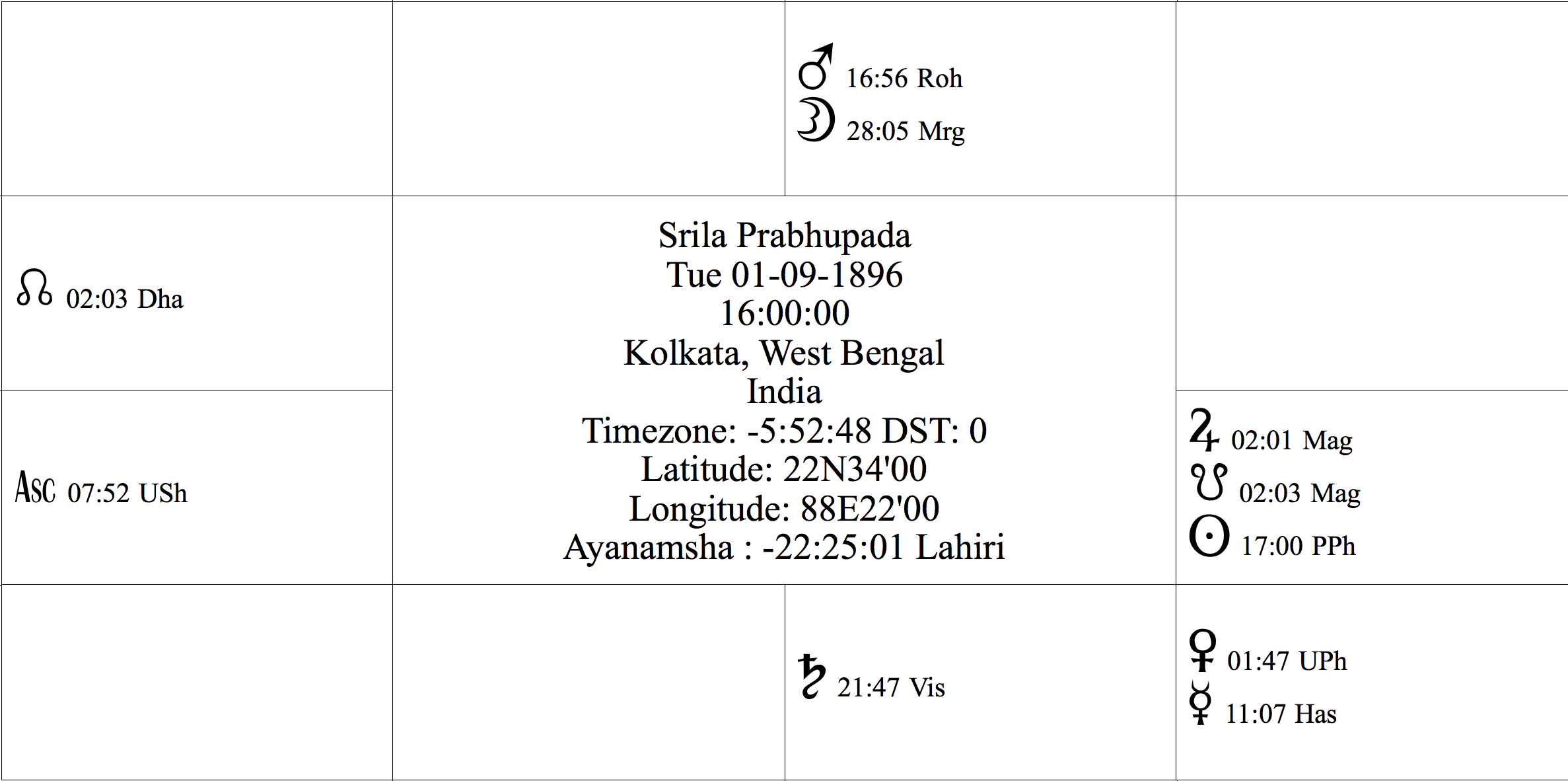
It is obvious that he does. He is in the 8th house with the 12th lord (end of life, and next life) and the 8th lord of death itself. One need not look much further to see the maraka qualities of this configuration. We also note that at the time of death Sani was at 6°20' of Simha almost exactly transiting the Lagna point (7°52') in the 8th from Makara ascendant. And, Sani was also in the 4th from Moon and Kuja who he directly aspected (highly unfavorable). He was also transiting over the lord of the Mahadasa, Ketu. (Planets transiting over the lord of the mahadasa have profound effect.) These are highly inauspicious and combined with the mahadasa lord being in the 8th the result was very clear and that is why Ojha predicted a very negative result which came to pass. The end of life came in holy place signified by Guru in the 8th, under very spiritual conditions with the chanting of the holy name.
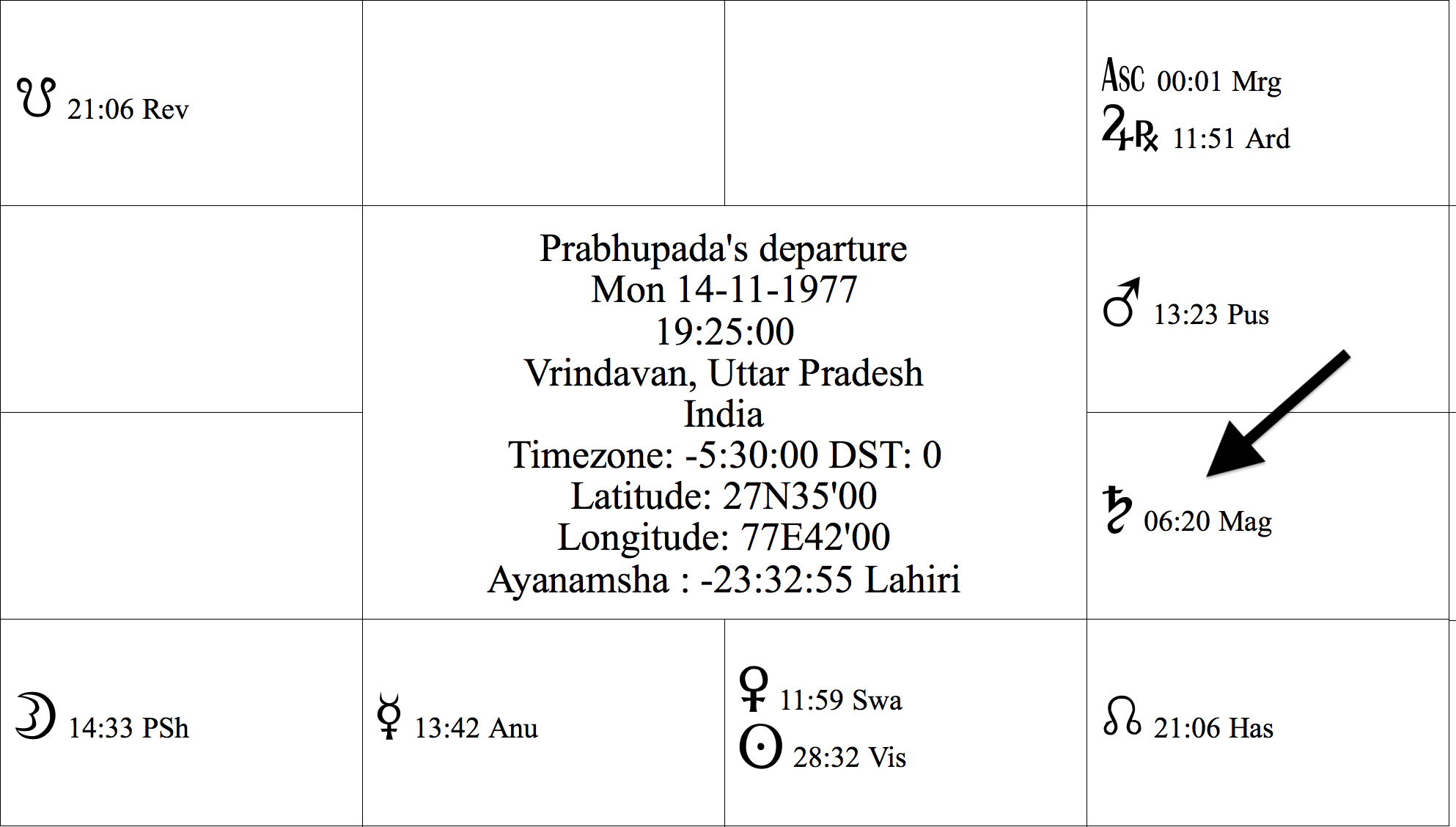
If it had been a Dhanus ascendant as Nalini maintains then what is the cause of death? Ketu is in 9th house with two very auspicious planets. Guru, by transit, is in 7th from the ascendant and thus protecting the ascendant. Sani transiting the 9th from ascendant is not so serious as to think of death. Indeed they do not indicate death at all. And it was for this reason that Arkasomayaji, the South Indian astrologer who, like Nalini, used a Dhanus ascendant, predicted that Prabhupada was in no danger and would live till 1984.
He writes in his letter (page 1 and page 2) to Surabhi Swami, dated August 18, 1977, that Srila Prabhupada will easily recover from this illness and live till 1984. He predicts:
The present illness should be interpreted only as a sort of exhaustion after a strenuous over-work both of body and mind.
And:
I see clearly and assert that the native shall be able to overcome this illness, by his strength of spirituality and shall have the opportunity of fulfilling his spiritual errand living up to 19-1-1984, i.e. the beginning of Sukra-Kuja, who are marakas(death inflicting).
So Swamiji [Surabhi], we have nothing to worry regarding the health of His Divine Grace, who has taken this mortal coil only for a Divine mission.
Thus if we use Makara ascendant then death during Ketu period is obvious.
By examining Srila Prabhupada’s life and comparing this to the planetary periods for each of the two charts it becomes very clear that it is much easier to explain Prabhupada’s life using Makara ascendant. Whereas for Dhanus ascendant there seems to be no rhyme or reason for the happenings in Prabhupada’s life.
2.12 Compatibility of Srila Bhaktisiddhanta
and Srila Prabhupada
As another confirmation of Prabhupada having a Makara ascendant let us consider the compatibility of these two great souls from an astrological perspective. Compatibility can be done for any two or more people, not just for marriage. There must have been some special reason why these two great personalities were so much in tune with each other. It will not be difficult to point out the reasons from the astrological side.


Prabhupada’s ascendant conjoins 4 of Srila Bhaktisiddhanta’s planets. This shows similar mentality and goals. Also Srila Bhaktisiddhanta’s Guru at 8°59' of Kanya very closely aspects Prabhupada’s ascendant at 7°52' of Makara. It is often found that in a good parent-child or student-teacher relationship the superior party has his Guru in such positions. And the same is true regarding Bhaktisiddhanta’s Sani close to Prabhupada’s Lagna. And, we note that Srila Prabhupada’s Budha is between Bhaktisiddhanta’s Guru and Moon and especially close to Guru this indicates the compatible exchange of ideas and ideals between the two of them.
Like Srila Bhaktisiddhanta, Prabhupada has the majority of significators in earth signs. Six for Bhaktisiddhanta and five for Prabhupada.
This close matching of the two great souls only exists if Prabhupada has his ascendant in Makara. It fails if it is in Dhanus. This would be especially true of the aspect of Bhaktisiddhanta’s Guru to Prabhupada’s ascendant.
A lot more can be said about the compatibility between the two charts but here we are interested in showing the connection to Prabhupada’s Makara Lagna.
2.13 Conclusion
From this in-depth analysis it becomes very clear that the claims made by our senior god-brother, Nalini Kanta Prabhu, regarding the relative merits of the Dhanus and Makara rising horoscope are indefensible and unacceptable. It is clear that Srila Prabhupada was born with a Makara rising chart which is exactly in accordance with the time he gave us. This Makara ascendant chart is the preferable chart.
Footnotes
Go to Bibliography
21 Chatterjee, p. 394. ↩
22 Hopke, p. 222. ↩
23 Ibid., p. 157.↩
24 Govindacharya, table of Spiritual Pedigree. ↩
25 Govindacharya, p. 73. ↩
26 Ojha, p. 114. ↩
27 Ibid., pp. 105-106. ↩
28 Frawley, p. 150. ↩
29 Based on several authors mentioned in references. ↩
30 Based on several authors mentioned in references. ↩
31 Rajan p. 83 ↩
32 Ojha, pp. 111-112. ↩
33 Bhat, p. 32. ↩
34 Ojha, p.77. ↩
35 Ibid., p. 143. ↩
36 Ibid., p. 169. ↩
37 Ibid., p. 77. ↩
38 Ibid., p. 143. ↩
39 Ibid., p. 169. ↩
40 Ibid., p. 77. ↩
41 Hopke, p. 176. ↩
42 Ibid., p. 184. ↩
43 Lilamrta, vol. 1, p 164.↩
44 Ojha, pp. 110-111. ↩
45 Ibid., p. 172. ↩
